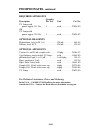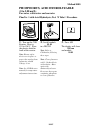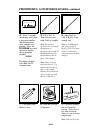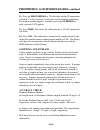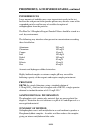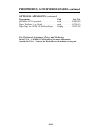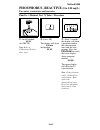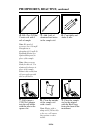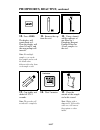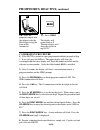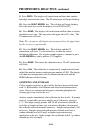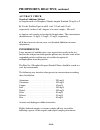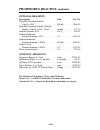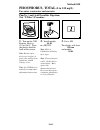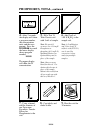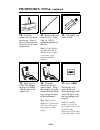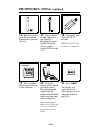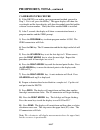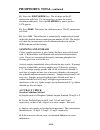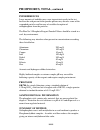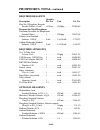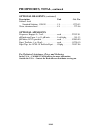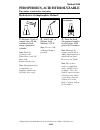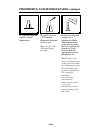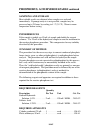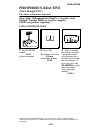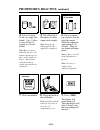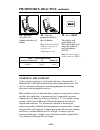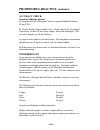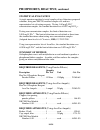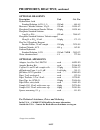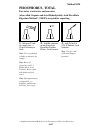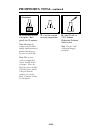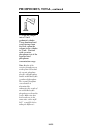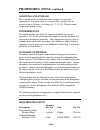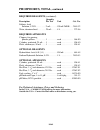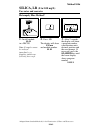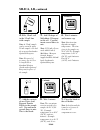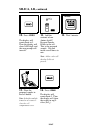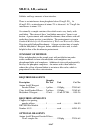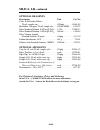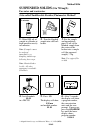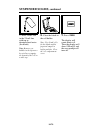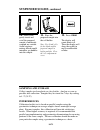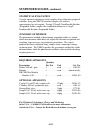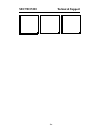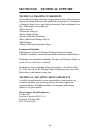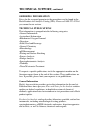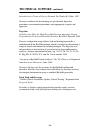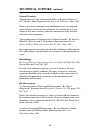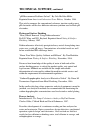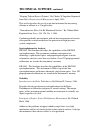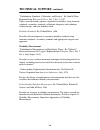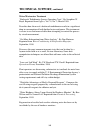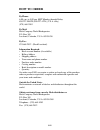- DL manuals
- Hach
- Measuring Instruments
- DR/700
- Procedures Manual
Hach DR/700 Procedures Manual
Summary of DR/700
Page 1
©hach company, 1990-2001. All rights reserved. Printed in u.S.A. 7-30-96-9ed rev. 2b, 11/01 dr/700 colorimeter procedures manual 46014-88.
Page 2
Ii.
Page 3: Table Of Contents
Iii table of contents introduction trademarks of hach company . . . . . . . . . . . . . . . . . . . . . . . . . . . . . . . .V sample procedure explained . . . . . . . . . . . . . . . . . . . . . . . . . . . . . . . Vii section i chemical analysis information abbreviations and conversions. . . . . ....
Page 4: Contents,
Iv contents, continued distillation . . . . . . . . . . . . . . . . . . . . . . . . . . . . . . . . . . . . . . . . . . 1-48 sampling and storage . . . . . . . . . . . . . . . . . . . . . . . . . . . . . . . . . . . . 1-49 taking water samples . . . . . . . . . . . . . . . . . . . . . . . . . . . . ...
Page 5: Introduction
V introduction this manual is divided into three sections: section i chemical analysis information this section relates to all of the procedures. It provides excellent background information or review material for the technician or chemist. Commonly-used procedure steps are explained in detail. Sect...
Page 6
Vi.
Page 7
Vii sample procedure name of used method 8048 phosphorus, reactive (0 to 2.50 mg/l po 4 3- ) for water, wastewater, seawater (also called: orthophosphate) phosver 3 (ascorbic acid) method* (powder pillows or accuvac ampuls), usepa accepted for reporting** using powder pillows 1. Install dr/700 modul...
Page 8
Viii 81-48 phosphorus, reactive, continued 4. Fill a 10-ml cell to the 10-ml line with sample. Note: for proof of accuracy, use a 1.0 mg/l phosphate (0.33 mg/l p) standard solution (listed under optional reagents) following these steps, in place of the sample. Note: run a reagent blank for this test...
Page 9
Ix table 1. Conversion factors to convert reading from to multiply by mg/l po 4 mg/l p 2 o 5 0.747 mg/l po 4 mg/l p 0.326 phosphorus, reactive, continued 81-49 7. Fill a 10-ml cell to the 10-ml line with sample (the blank). 8. Place the blank in the cell holder. Note: in bright sunlight it may be ne...
Page 10
X phosphorus, reactive, continued using accuvac ampuls 81-50 1. Install dr/700 module 81.01 in the instrument. 2. Press: l/o the display will show 810 nm and module number 81.01 3. After 2 seconds, the display will show a program number, concentration units, decimal position and the zero prompt. If ...
Page 11
Xi phosphorus, reactive, continued 81-51 4. Fill a cell with 10 ml of sample (the blank). Cap. Collect at least 40 ml of sample in a 50-ml beaker. Note: run a reagent blank for this test. Use deionized water in place of the sample in step 4. Subtract this result from all test results run with this l...
Page 12
Xii phosphorus, reactive, continued 10. Insert the accuvac vial adapter into the cell holder. 11. Place the prepared sample in the cell holder. Note: in bright sunlight it may be necessary to close the cell compartment cover. 12. Press: read the display will count down to 0. Then the display will sh...
Page 13
Xiii phosphorus, reactive, continued accuracy check standard additions method a) snap the neck off a phosphate voluette ampule standard solution, 50 mg/l po 4 - . B) use the tensette pipet to add 0.1 ml, 0.2 ml and 0.3 ml of standard, respectively, to three 25-ml water sample. Mix each thoroughly. (...
Page 14
Xiv phosphorus, reactive, continued statistical evaluation a single operator repetitively tested samples of two laboratory prepared solutions, using one dr/700, matched sample cells and two representative lots of testing reagents. Testing 1.60 mg/l po 4 3- concentration samples, the standard deviati...
Page 15
Xv phosphorus, reactive, continued optional reagents description unit cat. No. Hydrochloric acid standard solution, 6.0 n (1:1) . . . . . . . . . . . 500 ml . . . . . . . . . . 884-49 mercuric chloride solution, 10 g/l . . . . . . . . . 100 ml . . . . . . . . 14994-42 phosphate pretreatment powder p...
Page 16
Xvi.
Page 17
Section i chemical analysis information 1-a.
Page 18
1-b.
Page 19
1-1 section i chemical analysis information abbreviations and conversions abbreviations the following abbreviations are used throughout the text of the procedure section: °c degree(s) celsius (centigrade) °f degree(s) fahrenheit acs american chemical society reagent grade purity a/f acid/fluoride ex...
Page 20
1-2 conversions conversion factors for many of the commonly used units of measure have been included to make the use of this manual more universal and to simplify calculations. Conversions are categorized by test. Nitrogen nitrite (no 2 ) = nitrogen (n) x 3.28 nitrate (n0 3 ) = nitrogen (n) x 4.42 a...
Page 21
1-3 oxygen, dissolved the following table lists the mg/l dissolved oxygen in water at saturation for various temperatures and atmospheric pressures. The table was formulated in a laboratory using pure water; thus, the values given should be considered as only approximations when estimating the oxyge...
Page 22
1-4 accuracy and precision accuracy is the nearness of a test result to the true value. Precision refers to the agreement of a set of replicate results or repeatability. Although good precision suggests good accuracy, precise results can be inaccurate. The following paragraphs describe techniques to...
Page 23
1-5 approach whether the fault lies in the reagent, the instrument and apparatus, the test procedure or an interfering substance present in the test sample. A decision tree, such as the one in figure 1, establishes a systematic method for identifying the problem. Request hach publication 7004 for ad...
Page 24
1-6 branch a suppose a single standard addition to the sample did not give the correct concentration increase. A possible cause could be interferences. Other causes could be defective reagents, an incorrect procedure, a defective instrument and apparatus or a defective standard used for standard add...
Page 25
1-7 if the results of multiple standard additions gave the correct increments between additions, proceed to branch c. If the results of multiple standard additions gave other than the correct increments between additions, proceed to branch d. Branch c if interfering ions are present, the analysis ma...
Page 26
1-8 given in your instrument manual. Check glassware used in the procedure, making sure that it is scrupulously clean. Dirty pipets and graduated cylinders are sources of contamination and will not deliver the correct volumes. Hach's tensette pipet for dispensing standards and standards sealed in vo...
Page 27
1-9 graph as a and b show that the four data points do not lie on a straight line. Plot a illustrates an interference becoming progressively worse as the concentration of the standard increases. This type of interference is not common and may be caused by an error or malfunction of the procedure, re...
Page 28
1-10 the apparent interference in example b could be the result of an error made in the standard addition. The analysis should be repeated. The two examples illustrate chemical interferences which most certainly mean the result of the first analysis of the water sample was incorrect. When this type ...
Page 29
1-11 plot d illustrates a problem for the analyst. Increments found are uniform and the recovery of the standard was complete. The result of the first analysis was 0 mg/l and the graph plots back through 0 mg/l. If interferences are known to be present, the interference may be present in an amount e...
Page 30
1-12 adapting procedures adapting hach procedures for use with other photometers hach test procedures can be used with other instrumentation if calibration curves are established to convert test results from % transmittance or absorbance to the concentration of the constituent being measured. Regard...
Page 31
1-13 instrument reading was 46%, the 40 line and the 6 column would be selected. The test result would be 0.78 mg/l iron (fe). If in step 3, absorbance values are measured, plot the results on linear- linear paper. Plot the absorbance value on the vertical scale and the concentration values on the h...
Page 32
1-14 table 3 calibration table %t %t units tens 0 1 2 3 4 5 6 7 8 9 0 10 2.30 2.21 2.12 2.04 1.97 1.90 1.83 1.77 1.72 1.66 20 1.61 1.56 1.51 1.47 1.43 1.39 1.35 1.31 1.27 1.24 30 1.20 1.17 1.14 1.11 1.08 1.04 1.02 .99 .97 .94 40 .92 .89 .87 .84 .82 .80 .78 .77 .73 .71 50 .69 .67 .65 .64 .62 .60 .58 ...
Page 33
1-15 b. If the number of digits required is less than 70, increase the sample size to increase precision. C. If the sample size is altered, adjust the amount of buffering or indicating reagents by the same proportion. 4. When using the digital titrator for your buret method, note the number of digit...
Page 34
1-16 table 4. Titration cartridges description cat. No. Cdta, 0.0800 m, hexaver . . . . . . . . . . . . . . . . . . . . . . . . . . . . . . .14402-01 cdta, 0.800 m, hexaver . . . . . . . . . . . . . . . . . . . . . . . . . . . . . . . .14403-01 ceric standard solution, 0.5 n . . . . . . . . . . . . ...
Page 35
1-17 interference also may be caused by a high concentration of the constituent under analysis. For example, the presence of a larger excess of chlorine will cause the test to read less than full scale. Dilution of the sample to 5 mg/l will result in a reading higher than full scale. This indicates ...
Page 36
1-18 5. Compare the ph values of your analyzed sample with the reagent blank. 6. If there is no difference in the ph values of your analyzed sample and the reagent blank, then ph interference is not the problem. Follow the accuracy check given in the procedure to more clearly identify the problem. 7...
Page 37
1-19 solution to pass through. This is especially helpful when sample turbidity interferes with calorimetric analysis. Two general methods of filtration are gravity and vacuum. Gravity filtration uses the force of gravity to pull the sample though the filter paper. Vacuum filtration uses the pressur...
Page 38
1-20 required apparatus description unit cat. No. Filter discs, glass 47 mm . . . . . . . . . . . . . . . 100/pkg . . . . . . . . 2530-00 filter holder, membrane . . . . . . . . . . . . . . . . Each . . . . . . . . . . . 2340-00 flask, filter, 1000 ml . . . . . . . . . . . . . . . . . . Each . . . ....
Page 39
1-21 required apparatus description unit cat no. Cylinder, graduated, 100 ml. . . . . . . . . . . . . Each . . . . . . . . . . . . 508-42 funnel, poly, 65 mm . . . . . . . . . . . . . . . . . . . Each . . . . . . . . . . . 1083-67 filter paper, 12.5 cm . . . . . . . . . . . . . . . . . . . Each . . ...
Page 40
1-22 the test is performed. This is done by zeroing the instrument on deionized water and reagents. In most cases, the reagent blank is so small the instrument is zeroed on either an untreated portion of the original water sample or deionized water. This is done routinely without any significant los...
Page 41
1-23 warning labels also appear on some of the apparatus used with the test procedures. The protective shields with the cod reactor and the digesdahl digestion apparatus point out potential hazards. Be sure these shields are in place during use and observe the precautions they recommend. Wear protec...
Page 42
1-24 accuracy and precision, sample cells should be matched prior to use. Refer to matching sample cells in the instrument manual supplied with the colorimeter. Sample dilution techniques ten and twenty-five milliliter (ml) are the specified volumes for most colorimetric tests. However, in some test...
Page 43
1-25 the concentration of the sample is equal to the diluted sample reading times the multiplication factor. An example: a 2.5 ml sample was diluted with 22.5 ml of deionized water. The result was 0.35 mg/l. What is the concentration of the sample? 0.35 x 10 = 3.5 mg/l more accurate dilutions can be...
Page 44
1-26 temperature considerations for best results, most tests described in this manual should be performed with sample temperatures between 20 °c (68 °f) and 25 °c (77 °f). If certain tests require closer temperature control, that requirement will be indicated in notes following those procedures. Use...
Page 45
1-27 volumetric (transfer) pipets are long tubes with a bulb in the middle and a single ring above the bulb to indicate the volume of liquid to be delivered when it is filled to the mark. To discharge the sample from a volumetric pipet, hold the tip of the pipet at a slight angle against the contain...
Page 46
1-28 it about 1/4 inch out from the slot in the front side of the cell holder as in figure 8. Push the adapter against the slot sides to seat it. To be sure the adapter is seated, gently slide it upward. The adapter should stop about half way up and stay there. For measurements, leave the adapter in...
Page 47
1-29 use of reagent powder pillows dry powdered reagents are used when possible to minimize problems of leakage and deterioration. Powders are packaged in individual, pre- measured, polyethylene "powder pillows." each pillow contains enough reagent for one test and is opened easily with nail clipper...
Page 48
1-30 using the tensette pipet for best results, always use a new tip for each pipetting operation. After being used several times, the pipet tip may retain some liquid, causing an error in delivery, each pipet is supplied with 100 tips. Order hach replacements, for best results. Always use careful a...
Page 49
1-31 3. Press down on the turret cap with the thumb, using a smooth motion, until the turret reaches the stop. Immerse the tip about 5 mm (¼") below the surface of the solution to avoid drawing air into the tip. Do not insert the tip any deeper, or the delivery volume may be affected. 4. While maint...
Page 50
1-32 6. Use the thumb and forefinger to twist the turret cap to the next higher position on the volume-setting ring to assure full blowout and quantitative transfer of the sample. The "f" position provides full blowout for the 1.0-ml setting. 7. With the tip in contact with the side of the receiving...
Page 51
1-33 mixing water samples the following two methods may be helpful in tests that require mixing sample with chemicals (usually indicated by "swirl to mix" instructions). 1. A swirling motion is recommended when mixing sample in a graduated cylinder or a titration flask. In this case, grip the cylind...
Page 52
1-34 volume measurement accuracy sample cells supplied with the colorimeter are marked to indicate approximately 10 ml or 10, 20, and 25 ml. In most tests where volume measurements are critical, the procedure specifies the appropriate method. If a sample must be diluted, use a pipet for volume measu...
Page 53
1-35 sample pretreatment digestion digestion, required in several procedures, refers to the use of acid and heat to break down a substance into components that can be analyzed. This section has three different digestion procedures. The hach digesdahl system is an absolute process that yields a diges...
Page 54
1-36 6. Quantitatively transfer the sample with deionized water to a 100-ml volumetric flask and dilute to volume with deionized water. Continue with the procedure. This mild digestion may not suffice for all sample types. A reagent blank also should be carried through the digestion and measurement ...
Page 55
1-37 result by the correction factor in column 5 of the table below. A reagent blank also should be carried through the digestion and measurement procedures. Table 7. Vigorous digestion expected suggested suggested suggested correction metal sample for volume final volume factor concentration digest...
Page 56
1-38 water sample volume (ml) = 50 % solids general digesdahl digestion 1. Transfer a preweighed or a premeasured amount of sample into a 100-ml volumetric flask; see table 8. The amount transferred should not contain more than 0.5 g of solids or organic liquids. The maximum volume for water samples...
Page 57: Continued
1-39 general digesdahl digestion, continued 4. Place the flask weight followed by the fractionating column with funnel on the flask. Place the flask on the heater and heat until the boiling point of sulfuric acid is reached (refluxing sulfuric acid will be visible). Note: white acid vapors usually w...
Page 58: Continued
1-40 general digesdahl digestion, continued 8. Take the flask off the heater and allow the flask to cool. Remove the fractionating column from the digestion flask. Note: use finger cots to remove the digestion flask. Place it on a cooling pad for at least one minute. Then remove the column. Required...
Page 59: Continued
1-41 general digesdahl digestion, continued required apparatus (continued) quantity description per digestion unit cat. No. Safety glasses . . . . . . . . . . . . . 1 . . . . . . . . . . . Each. . . . . . . . 18421-00 safety shield, for digesdahl . . 1 . . . . . . . . . . . Each. . . . . . . . 20974...
Page 60: Continued
1-42 general digesdahl digestion, continued optional apparatus (continued) description unit cat. No. Ph meter, ec10, portable . . . . . . . . . . . . . . . Each. . . . . . . . 50050-00 pipet, pasteur, disposable, 229 mm . . . . . . . . . . 250/pkg . . . . . 21234-01 safety glasses . . . . . . . . . ...
Page 61
1-43 table 8. Digestion guidelines for specific sample types sample sample amount preheat amount of special type weight of acid time peroxide instructions plant 0.25 to 5 g 4 ml 4 min. 10 ml use n-free paper tissue to weigh sample meat & 0.5 g or 4 ml or as 4 min. 10 ml may use poultry predigestion ...
Page 62
1-44 table 8. Digestion guidelines for specific sample types (continued) sample sample amount preheat amount of special type weight of acid time peroxide instructions edible 0.25 to 0.5 g 4-6 ml 4 min. 5 ml weigh sample into oils immediately flask and record and 5 ml exact weight. Later ion equivale...
Page 63
1-45 •always wear safety glasses. •always perform digestion behind a safety shield or in a closed fume hood. •if the sample goes to dryness, remove immediately and cool. Repeat procedure with smaller sample volume or more acid. The following additional specific safety precautions are appropriate whe...
Page 64
1-46 3. Hold the parts exposed to the digestion mixture under running water, avoiding getting water or the digestion mixture into the heater base. If the aspirator fails during a digestion, immediately turn the heater off. Do not breathe any fumes that may be expelled from the manifold. After the fl...
Page 65
1-47 metallic ions, or alkali. Accelerated decomposition from contamination will result in the significant production of oxygen and liberation of heat. These products will support combustion and will cause pressure bursts in confined spaces. Commercial grades of hydrogen peroxide contain small quant...
Page 66
1-48 do not use unapproved materials (brass, copper, carbon steel, rubber, etc.) for transfer or storage systems. Caps on the reagent bottles are made with a special porous liner that allows venting of gas. The venting cap always must be used on the bottle of hydrogen peroxide. As a precaution, the ...
Page 67
1-49 sampling and storage correct sampling and storage are critical to the accuracy of each test. For greatest accuracy minimize contamination from the sampling device, remove residues of previous samples from sample container and preserve the sample properly, if necessary. Taking water samples coll...
Page 68
1-50 taken near the center of the vessel or duct and below the surface. Use only clean containers (bottles, beakers) for collecting samples. Rinse the container several times first with the water to be sampled. Take samples as closely as possible to the source of the supply to minimize the effects o...
Page 69
1-51 glassware must be rinsed thoroughly with distilled water. For ammonia and kjeldahl nitrogen, the glassware must be rinsed with ammonia-free water. Storage and preservation the most cost-effective sample containers are made of polypropylene or polyethylene. The best and most expensive containers...
Page 70
1-52 table 9. Required containers, preservation techniques and holding times 1 maximum parameter no./name container 2 preservation 3,4 holding time 5 table 1a-bacterial tests: 1-4. Coliform, fecal p g cool, 4°c, 0.008% 6 hours. And total na 2 s 2 o 3 6 5. Fecal streptococci p, g do do. Table 1b-inor...
Page 71
1-53 table 9 required containers, preservation techniques and holding times 1 (continued) maximum parameter no./name container 2 preservation 3,4 holding time 5 metals (continued): 35. Mercury p, g hno 3 to ph 28 days. 3, 5-8, 10, 12, 13, 19, 20, p, g do 6 months. 22, 26, 29, 30, 32-34, 36, 37, 45, ...
Page 72
1-54 table 9 required containers, preservation techniques and holding times 1 (continued) maximum parameter no./name container 2 preservation 3,4 holding time 5 metals (continued): 61. Silica p do 28 days. 64. Specific conductance p, g do do. 65. Sulfate p, g do do. 66. Sulfide p, g cool, 4 °c add 7...
Page 73
1-55 volume additions, correction for when significant amounts of preservative are used, a volume correction should be made. This will account for the acid added to preserve the sample and the base used to adjust the ph to the range of the procedure. This correction is made as follows: 1. Determine ...
Page 74
1-56.
Page 75
Section ii procedures 2-a.
Page 76
2-b.
Page 77
2-1 dr/700 module selection guide parameters and ranges (alphabetical) module number reagent description range (cat. No.) package aluminum, aluminon method . . . . . . . . . . . . . . 0-1.0 mg/l . . . . 52.01 (46252-00). . . . 22420-00 aluminum, eriochrome cyanine r method . . . 0-0.25 mg/l . . . 52...
Page 78
2-2 module number reagent description range (cat. No.) package nitrogen, ammonia, salicylate method . . . . . . 0-0-1.00 mg/l. . 61.01 (46261-00). . . . 22437-00 oxygen, dissolved, high range . . . . . . . . . . . 0-10 mg/l . . . . . 52.01 (46252-00). . . . 25150-25 oxygen, dissolved, low range. . ....
Page 79
2-3 420-nm filter module (42.01) cat. No. 46000-10 parameter. . . . . . . . . . . . . . . . . . . . . . . . . . . . . . . . . . . . . . . . .Range benzotriazole, tolytriazole. . . . . . . . . . . . . . . . . . . . . . . . . . . . . . . . . . . 15 mg/l copper, porphyrin . . . . . . . . . . . . . . . ...
Page 80
2-4 525-nm filter module (52.01) cat. No. 46000-14 parameter. . . . . . . . . . . . . . . . . . . . . . . . . . . . . . . . . . . . . . . . .Range aluminum, aluminon . . . . . . . . . . . . . . . . . . . . . . . . . . . . . . . . . . . . . . .1.0 mg/l aluminum, erichrome cyanine r . . . . . . . . . ...
Page 81
2-5 610-nm filter module (61.01) cat. No. 46000-17 (continued) parameter. . . . . . . . . . . . . . . . . . . . . . . . . . . . . . . . . . . . . . . . .Range oxygen dissolved, lrdo accuvac . . . . . . . . . . . . . . . . . . . . . . . . . . .800 ug/l oxygen demand, chemical, high range and high ran...
Page 82
2-6.
Page 83: Module 42.01
Module 42.01 420 nm hach warrants equipment it manufactures against defective materials or workmanship for at least one year from the shipping date. Warranties do not apply to limited-life electrical components such as batteries. Full warranty information is located on the reverse side of hach invoi...
Page 84
Table of contents for 420-nm parameters benzotriazole, tolyltriazole . . . . . . . . . . . . . . . . . . . . . . . . . . . . . . . 42-1 copper, porphyrin . . . . . . . . . . . . . . . . . . . . . . . . . . . . . . . . . . . . . . . 42-9 molybdenum, molybdate, high range. . . . . . . . . . . . . . . ...
Page 85
42-1 method 8079 benzotriazole or tolyltriazole (0 to 15.0 mg/l benzotriazole; 0 to 20.0 mg/l tolyltriazole) for cooling and boiler water uv photolysis method* 1. Install module 42.01 in a dr/700. Note: the most reliable results are obtained when samples are analyzed as soon as possible after collec...
Page 86
42-2 benzotriazole and tolyltriazole, continued 4. Fill a square mixing bottle with 25 ml of sample. Note: for proof of accuracy, use a 5.0 mg/l benzotriazole standard solution (preparation given in accuracy check) in place of the sample. Note: sample temperature should be between 20 to 25 o c (68 t...
Page 87: 10.
42-3 benzotriazole and tolyltriazole, continued 7. Turn the uv lamp on. Note: a yellow color will develop if triazole is present. 8. Wait 5 minutes. 9. Turn the lamp off. Remove lamp from the bottle swirl to mix thoroughly. Note: low results will occur if photolysis (lamp on) takes place for more or...
Page 88: 13.
42-4 benzotriazole and tolyltriazole, continued 13. Press: zero the display will count down to 0. Then the display will show 0.00 mg/l and the zero prompt will turn off. 14. Place the prepared sample in the cell holder. Note: in bright sunlight it may be necessary to close the cell compartment cover...
Page 89
42-5 benzotriazole and tolyltriazole, continued b) analyze according to the above procedure. If the result is significantly below 5.0 mg/l, replace the lamp. Statistical evaluation a single operator repetitively tested samples of two laboratory prepared solutions, using one dr/700, matched sample ce...
Page 90
42-6 benzotriazole and tolyltriazole, continued summary of method benzotriazole or tolyltriazole, used in many applications as corrosion inhibitors for copper and copper alloys, are determined by a proprietary catalytic ultraviolet (uv) photolysis procedure requiring less than 10 minutes to perform....
Page 91
42-7 benzotriazole and tolyltriazole, continued optional apparatus (continued) description unit cat. No. Pipet, tensette, 0.1 to 1.0 ml . . . . . . . . . . . . . . Each. . . . . . . . 19700-01 pipet tips, for 19700-01 tensette pipet . . . . . . 50/pkg . . . . . . 21856-96 pipet, volumetric, class b,...
Page 92
42-8.
Page 93: Copper
42-9 method 8143 copper (0 to 250 µg/l) for water, wastewater and seawater porphyrin method* 1. Install module 42.01 in a dr/700. Note: if samples cannot be analyzed immediately, see sampling and storage following these steps. Adjust the ph of stored samples before analysis. 2. Press: i/o the displa...
Page 94: Copper,
42-10 copper, continued 4. Fill two 25-ml cells to the 25-ml line with sample. Note: wash all glassware with detergent. Rinse with tap water. Rinse again with nitric acid solution, 1:1. Rinse a third time with copper- free, demineralized water. Note: for proof of accuracy, use a 100 µg/l copper stan...
Page 95: Copper,
42-11 copper, continued 7. Add the contents of one porphyrin 2 reagent powder pillow to each sample cell. Cap and invert several times to mix. Note: the yellow color will turn blue momentarily. If any copper is present, the sample will return to yellow. 8. Wait 3 minutes. 9. Place the blank in the c...
Page 96: Copper,
42-12 copper, continued 10. Press: zero the display will count down to 0. Then the display will show 0 µg/l and the zero prompt will turn off. 11. Place the prepared sample in the cell holder. Note: typical indoor lighting permits the dr/700 to operate with the cell compartment open. In bright sunli...
Page 97: Copper,
42-13 copper, continued sampling and storage collect samples in acid-washed plastic bottles. To preserve, adjust the ph to 2 or less with nitric acid (about 5 ml per liter). Store preserved samples up to six months at room temperature. Before testing, adjust the ph of the sample to between 2 and 6. ...
Page 98: Copper,
42-14 copper, continued testing zero concentration samples, the limit of detection was 1.7 µ g/l cu. The limit of detection was calculated as three times the standard deviation when testing zero concentration samples (adapted from analytical chemistry, 1980, 52, 2242-2249). Interferences the followi...
Page 99: Copper,
42-15 copper, continued required reagents cat. No. Copper reagent set (100 tests) . . . . . . . . . . . . . . . . . . . . . . . 22427-00 includes: (2) 21873-66, (4) 21874-66, (2) 21875-69 quantity description per test unit cat. No. Copper masking reagent powder pillows . . . . . . . . . . . 1 pillow...
Page 100: Copper,
42-16 copper, continued optional apparatus (continued) description unit cat. No. Sample cell, 25-ml with screw cap . . . . . . . . . 6/pkg . . . . . . . 24019-06 watch glass . . . . . . . . . . . . . . . . . . . . . . . . . . . . Each. . . . . . . . . . 578-70 for technical assistance, prices and or...
Page 101: Molybdenum, Molybdate, Hr
42-17 method 8036 molybdenum, molybdate, hr (0 to 40 mg/l) for water and wastewater mercaptoacetic acid method* 1. Install module 42.01 in a dr/700. Note: collect samples in glass or plastic bottles. 2. Press: i/o the display will show 420 nm and module number 42.01 3. After 2 seconds, the display w...
Page 102
42-18 molybdenum, molybdate, hr, continued 4. Fill a 25-ml cell to the 25-ml line with sample. Note: for proof of accuracy, use a 10.0 mg/l molybdenum standard solution (listed under optional reagents) in place of the sample. Note: filter turbid samples using the labware listed under optional appara...
Page 103: 10.
42-19 molybdenum, molybdate, hr, continued 10. Place the blank in the cell holder. Note: typical indoor lighting permits the dr/700 to operate with the cell compartment cover open. In bright sunlight, it may be necessary to close the cell compartment cover. Transfer 10 ml of the blank solution to a ...
Page 104
42-20 molybdenum, molybdate, hr, continued accuracy check standard additions method a) snap the neck off a molybdenum voluette ampule standard solution, 500 mg/l mo 6+ . B) use the tensette pipet to add 0.1, 0.2 and 0.3 ml of standard to three 25-ml samples, mix thoroughly. C) analyze the spiked sam...
Page 105
42-21 molybdenum, molybdate, hr, continued highly buffered samples or extreme sample ph may exceed the buffering capacity of the reagents and require sample pretreatment; see interferences, ph (section i). Summary of method molyver 1 and 2 reagents are added to buffer and condition the sample. Molyv...
Page 106
42-22 molybdenum, molybdate, hr, continued optional apparatus description unit cat. No. Cap for 10- and 25-ml sample cells . . . . . . . . . 12/pkg . . . . . . 24018-12 filter paper, folded, 12.5 cm . . . . . . . . . . . . . . . 100/pkg . . . . . 1894-57 flask, erlenmeyer, 250 ml . . . . . . . . . ....
Page 107: Nickel
42-23 method 8037 nickel (0 to 1.80 mg/l ni) for water, wastewater and seawater heptoxime method*; epa accepted for reporting (digestion is required; see section 1)** 1. Measure 300 ml of sample in a 500-ml graduate cylinder. Pour into a 500-ml separatory funnel. Note: if sample cannot be analyzed i...
Page 108: Nickel,
42-24 nickel, continued 4. Add the contents of one nickel 2 reagent powder pillow to the funnel. Stopper and shake to mix. 5. Wait five minutes. 6. Add 10 ml of chloroform. Stopper and shake gently. Holding the stopper in, invert the funnel and slowly open the stopcock to vent the pressure buildup. ...
Page 109: Nickel,
42-25 nickel, continued 10. Press: i/o the display will show 420 nm and module number 42.01 11. After 2 seconds, the display will show a program number, the concentration units, decimal position and the zero prompt. If necessary, press the up arrow key until the lower display shows program number 42...
Page 110: Nickel,
42-26 nickel, continued 13. Repeat steps 6 to 8 and step 12 two additional times with 10-ml portions of chloroform. Drain the chloroform layer into the same sample cell. Note: the five-minute reaction period is not necessary for the second and third extractions. Shake with chloroform; wait for layer...
Page 111: Nickel,
42-27 nickel, continued 16. Place the prepared sample in the cell holder. Note: typical indoor lighting permits the dr/700 to operate with the cell compartment cover open, in bright sunlight, it may be necessary to close the cell compartment cover. Transfer 10 ml of the blank solution to a 10-ml cel...
Page 112: Nickel,
42-28 nickel, continued sampling and storage collect samples in acid-washed plastic bottles. Adjust the sample ph to 2 or less with nitric acid (about 5 ml per liter). Preserved samples can be stored up to six months at room temperature. Before analysis, adjust the sample ph to between 3 and 8 with ...
Page 113: Nickel,
42-29 nickel, continued testing zero concentration samples, the limit of detection was 0.013 mg/l ni. The limit of detection was calculated as three times the standard deviation when testing zero concentration samples (adapted from analytical chemistry, 1980, 52, 2242-2249). Interferences cobalt, co...
Page 114: Nickel,
42-30 nickel, continued required reagents cat. No. Nickel reagent set (50 tests) . . . . . . . . . . . . . . . . . . . . . . . . . 22435-00 includes: (3) 14458-49, (2) 2123-68, (2) 2124-68 quantity description per test unit cat. No. Chloroform, acs . . . . . . . . . . . . 55 ml . . . . . 500 ml . . ...
Page 115: Nickel,
42-31 nickel, continued optional apparatus (continued) description unit cat. No. Pipet, serological, 1 ml. . . . . . . . . . . . . . . . . . . Each. . . . . . . . . 532-35 pipet, serological, 5 ml. . . . . . . . . . . . . . . . . . . Each. . . . . . . . . 532-37 pipet, tensette, 0.1 to 1.0 ml . . . ...
Page 116
42-32.
Page 117: Nitrogen, Ammonia
42-33 method 8038 nitrogen, ammonia (0 to 3.00 mg/l nh 3 -n) for water, wastewater*, seawater* nessler method**, epa accepted for reporting (distillation required)† 2. Press: i/o the display will show 420 nm and module number 42.01 3. After 2 seconds, the display will show a program number, the conc...
Page 118: Nitrogen, Ammonia,
42-34 nitrogen, ammonia, continued 4. Fill a 25-ml sample cell to the 25-ml mark with sample (the prepared sample). Note: for proof of accuracy, use a 1.0 mg/l ammonia nitrogen standard solution (listed under optional reagents) in place of the sample. 5. Fill another 25-ml sample cell with demineral...
Page 119: Nitrogen, Ammonia,
42-35 mg/l nh 3 - n mg/l nh 3 1.22 mg/l nh 3 - n mg/l nh 4 + 1.29 nitrogen, ammonia, continued 10. Place the blank in the cell holder. Note: typical indoor lighting permits the dr/700 to operate with the cell compartment cover open. In bright sunlight, it may be necessary to close the cell compartme...
Page 120: Nitrogen, Ammonia,
42-36 nitrogen, ammonia, continued sampling and storage collect samples in clean glass or plastic bottles. If chlorine is present, add one drop of sodium thiosulfate, 0.1 n, for each 0.3 mg/l cl 2 in a 1-liter sample. Preserve the sample by reducing the ph to 2 or less with sulfuric acid (at least 2...
Page 121: Nitrogen, Ammonia,
42-37 nitrogen, ammonia, continued interferences a solution containing a mixture of 500 mg/l caco 3 and 500 mg/l mg as caco 3 does not interfere. If the hardness concentration exceeds these concentration, extra mineral stabilizer should be added. Iron and sulfide interfere by causing a turbidity wit...
Page 122: Nitrogen, Ammonia,
42-38 nitrogen, ammonia, continued e) turn on the heater power switch. Set the stir control to 5 and the heat control to 10. Turn on the water and adjust to maintain a constant flow through the condenser. F) turn off the heater after collecting 150 ml of distillate. Immediately remove the collection...
Page 123: Nitrogen, Ammonia,
42-39 nitrogen, ammonia, continued optional reagents description unit cat. No. Borate buffer solution . . . . . . . . . . . . . . . . 946 ml . . . . . . . 14709-16 boric acid powder pillows . . . . . . . . . . . . . 50/pkg . . . . . . . . 14817-66 nitrogen, ammonia standard solution, 1 mg/l nh 3 -n ...
Page 124
42-40
Page 125: (0 to 150 Mg/l)
42-41 digestion method 8000 oxygen demand, chemical (cod) (0 to 150 mg/l) for water, wastewater and seawater reactor digestion method*; usepa approved for reporting† 1. Homogenize 100 ml sample for 2 minutes in a blender. Note: for samples with high solid content, blending ensures distribution of so...
Page 126: Oxygen Demand, Chemical,
42-42 oxygen demand, chemical, continued 4. Hold the vial at a 45-degree angle. Pipet 2.00 ml of sample into the vial. Note: to ensure a uniform sample aliquot, stir sample with magnetic stirrer while drawing sample aliquot into the pipet. Note: for greater accuracy, three replicates should be analy...
Page 127: Oxygen Demand, Chemical,
42-43 oxygen demand, chemical, continued 7. Prepare a blank by repeating steps 3 to 6, substituting 2.00 ml demineralized water for the sample. Note: be sure the pipet is well rinsed or use a clean pipet. Note: one blank must be run with each set of samples. All tests (samples and blanks) should be ...
Page 128: Oxygen Demand, Chemical,
42-44 oxygen demand, chemical, continued 10. Invert each vial several times while still warm. Place the vials into a rack. Wait until the vials have cooled to room temperature. Note: if a pure green color appears in the reacted sample, the reagent capacity may have been exceeded. For most accurate r...
Page 129: Oxygen Demand, Chemical,
42-45 oxygen demand, chemical, continued 1. Install module 42.01 in a dr/700. 2. Press: i/o the display will show 420 nm and module number 42.01 3. After 2 seconds, the display will show a program number, concentration units and the zero prompt. If necessary, press the up arrow key until the lower d...
Page 130: Oxygen Demand, Chemical,
42-46 oxygen demand, chemical, continued 7. Press: zero the display will count down to 0. Then the display will show 0.00 mg/l, and the zero prompt will turn off. 8. Clean the outside of the sample vial with a towel. 9. Place the sample vial into the adapter with the hach logo facing the front of th...
Page 131: Oxygen Demand, Chemical,
42-47 oxygen demand, chemical, continued sampling and storage collect samples in glass bottles. Use plastic bottles only if they are known to be free of organic contamination. Test biologically active samples as soon as possible. Homogenize samples containing solids to assure representative samples....
Page 132: Oxygen Demand, Chemical,
42-48 oxygen demand, chemical, continued blanks for colorimetric determination the blank may be used repeatedly for measurements using the same lot of vials. Store it in the dark. Monitor decomposition by measuring the absorbance. Zero the instrument in the absorbance mode, using a vial containing 5...
Page 133: Oxygen Demand, Chemical,
42-49 oxygen demand, chemical, continued optional reagents description unit cat. No. Cod digestion reagent vials, 0 to 150 mg/l cod. . . . . . . . . . . . . . . . . . . . 150/pkg . . . . . . . . .21258-15 cod standard solution, 1000 mg/l . . . . . . . . . . . . . . . . . . . . . . . . . . . 236 ml ....
Page 134
42-50
Page 135: Palladium
42-51 method 8144 palladium (0 to 250 mg/l) for palladium-tin activator baths n,n'-dimethyldithiooxamide method 1. Install module 42.01 in a dr/700. 2. Press: i/o the display will show 420 nm and module number 42.01 3. After 2 seconds, the display will show a program number, the concentration units ...
Page 136: Palladium,
42-52 palladium, continued 7. Add 0.5 ml of the palladium activator sample to one of the mixing cylinders (the prepared sample). The other cylinder will be the blank. Note: use a tensette pipet or 0.5 volumetric pipet. 8. Add the contents of one chromium 1 reagent powder pillow to each cylinder. Sto...
Page 137: Palladium,
42-53 palladium, continued 13. Fill a 10-ml cell to the 10-ml line with the blank. Cap. 14. Place the blank in the cell holder. Note: in bright light, it may be necessary to close the cell compartment cover. 15. Press: zero the display will count down to 0. Then the display will show 0 mg/l and the ...
Page 138: Palladium,
42-54 palladium, continued sampling and storage collect samples in clean plastic or glass bottles. Analyze activator bath samples as soon as possible after collection. Mix well before pipetting the sample. Statistical evaluation a single operator repetitively tested samples of two laboratory prepare...
Page 139: Palladium,
42-55 palladium, continued required reagents (continued) quantity description per test unit cat. No. 2,2'bipyridine . . . . . . . . . . . . . 0.2 g . . . . . . 5 g . . . . . . . . . . . . . 116-22 chromium 1 reagent powder pillows . . . . . . . . . 2 pillows . . . 100/pkg . . . . . . . . 2043-99 hyd...
Page 140
42-56.
Page 141
42-57 method 8180 phosphorus, acid hydrolyzable for water, wastewater, seawater hydrolysis to orthophosphate method* 1. Measure 25 ml of sample into a 50-ml erlenmeyer flask using a graduated cylinder. Note: wash all glassware with hydrochloric acid, 6 n. Rinse with demineralized water. Note: if pro...
Page 142: Continued
42-58 phosphorus, acid hydrolyzable, continued 4. Cool the prepared sample to room temperature. 5. Add 2.0 ml of 5.0 n sodium hydroxide solution. Swirl to mix. Note: use the 1-ml calibrated dropper provided. 6. Pour the prepared sample into a graduated cylinder. Add demineralized water rinsings from...
Page 143: Continued
42-59 phosphorus, acid hydrolyzable continued sampling and storage most reliable results are obtained when samples are analyzed immediately. If prompt analysis is not possible, samples may be preserved up to 24 hours by cooling to 4 °c (39 °f). Warm to room temperature before testing. Interferences ...
Page 144: Continued
42-60 phosphorus, acid hydrolyzable continued optional reagents description unit cat. No. Hydrochloric acid, 6 n . . . . . . . . . . . . . . . . 500 ml . . . . . . . . . 884-49 water, demineralized . . . . . . . . . . . . . . . . . . 4 l . . . . . . . . . . . . 272-56 optional apparatus cylinder, gr...
Page 145: Phosphorus, Reactive
42-61 method 8114 phosphorus, reactive (0 to 20 mg/l po 4 3- ) for water and wastewater (also called orthophosphate) molybdovanadate method* 1. Install module 42.01 in a dr/700. Note: if samples cannot be analyzed immediately, see sampling and storage, below. 2. Press: i/o the display will show 420 ...
Page 146: Phosphorus, Reactive,
42-62 phosphorus, reactive, continued 7. Wait 3 minutes. Note: if the sample concentration is greater than 24 mg/l, read at exactly 3 minutes or make a 1:1 dilution. 8. Place the blank in the cell holder. Note: typical indoor lighting permits the dr/700 to operate with the cell compartment cover ope...
Page 147: Phosphorus, Reactive,
42-63 phosphorus, reactive, continued 10. Place the prepared sample in the cell holder. Note: typical indoor lighting permits the dr/700 to operate with the cell compartment cover open. In bright sunlight, it may be necessary to close the cell compartment cover. Transfer 10 ml of the blank solution ...
Page 148: Phosphorus, Reactive,
42-64 phosphorus, reactive, continued sampling and storage collect samples in clean plastic or glass bottles that have been cleaned with 1:1 hydrochloric acid solution and rinsed with demineralized water. Do not use a commercial detergent because the phosphate content will contaminate the sample. If...
Page 149: Phosphorus, Reactive,
42-65 phosphorus, reactive, continued statistical evaluation a single operator repetitively tested samples of two laboratory prepared solutions, using one dr/700, matched sample cells and representative lots of testing reagents. Testing 20.00 mg/l po 4 3- concentration samples, the standard deviatio...
Page 150: Phosphorus, Reactive,
42-66 phosphorus, reactive, continued summary of method in the molybdovanadate method, orthophosphate reacts with molybdate in an acid medium to produce a phosphomolybdate complex. In the presence of vanadium, yellow vanadomolybdophosphoric acid is formed. The intensity of the yellow color is propor...
Page 151: Phosphorus, Reactive,
42-67 phosphorus, reactive, continued optional apparatus (continued) description per test units cat. No. Pipet, serological, 2.0 ml . . . . . . . . . . . . . . . Each . . . . . . . . . . . . 532-36 pipet, tensette, 0.1 to 1.0 ml . . . . . . . . . . . Each . . . . . . . . . . 19700-01 pipet tips, for...
Page 152
42-68.
Page 153: Phosphorus, Total
42-69 method 8190 phosphorus, total for water, wastewater and seawater (also called organic and acid hydrolyzable) acid persulfate digestion method*; usepa accepted for reporting 1. Measure 25 ml of sample into a 50-ml erlenmeyer flask. Note: use a graduated cylinder to measure the sample. Note: rin...
Page 154: Phosphorus, Total,
42-70 phosphorus, total, continued 4. Place the flask on a hot plate. Boil gently for 30 minutes. Note: maintain the volume near 20 ml by adding small amounts of demineralized water. Do not exceed 20 ml. Note: this is more easily accomplished with a "double-boiler" technique. Place the flask in a pa...
Page 155: Phosphorus, Total,
42-71 phosphorus, total, continued 7. Pour the sample into a 25-ml graduated cylinder. Using demineralized water rinsings from the flask, return the volume in the cylinder to 25 ml. Proceed with a reactive phosphorus test of the expected total phosphorus concentration range. Note: results of the rea...
Page 156: Phosphorus, Total,
42-72 phosphorus, total, continued sampling and storage most reliable results are obtained when samples are analyzed immediately. If prompt analysis is not possible, samples may be preserved up to 24 hours by cooling to 4 ° c (39 ° f). Warm to room temperature before testing. Interferences for turbi...
Page 157: Phosphorus, Total,
42-73 phosphorus, total, continued required reagents (continued) quantity description per test unit cat. No. Sulfuric acid solution, 5.25 n . . . . . . . . . 2 ml . . . . . . . 100 ml*mdb . . . 2449-32 water, demineralized . . . . . . . . 25 ml . . . . . 4 l . . . . . . . . . . . . 272-56 required a...
Page 158
42-74.
Page 159: Rhodium
42-75 method 8134 rhodium (0 to 14 g/gal) for surface finishing solutions n,n'-dimethyldithiooxamide method* 1. Dilute the rhodium bath solution by pipetting 1.0 ml of bath solution into a 250-ml volumetric flask. Fill the flask to the mark with demineralized water. Cap and invert at least 10 times ...
Page 160: Rhodium,
42-76 rhodium, continued 4. Carefully add 15.0 ml of concentrated hydrochloric acid to each cylinder. Stopper and invert to mix. Note: use a pipet bulb and mohr pipet. 5. Using the 1.0 ml calibrated dropper, add 1.0 ml of n,n'- dimethyldithiooxamide indicator solution to each cylinder. Stopper and i...
Page 161: Rhodium,
42-77 rhodium, continued 10. After 2 seconds, the display will show a program number, concentration units and the zero prompt. Press program until the display shows program number 42.000 the upper display will show the s1 concentration. 11. Fully insert a cod vial adapter into the cell holder with t...
Page 162: Rhodium,
42-78 rhodium, continued 13. Press: zero the display will count down to 0. Then the display will show 0.00 and the zero and s1 prompts will turn off. 14. Grasp the prepared sample by the cap and place it in the adapter with the hach logo facing to the front of the instrument note: measurements in br...
Page 163: Rhodium,
42-79 rhodium, continued calibration if a 1.0 to 250 ml dilution is used in step 1, calibrating with a 15.0 mg/l rhodium standard is proportional to having 3750 mg/l, 3.765 g/l or 14.2 g/gal of rhodium in the original bath. When analyzing samples, the dr/700 can display the diluted bath concentratio...
Page 164: Rhodium,
42-80 rhodium, continued required reagents quantity description per test unit cat no. Hydrochloric acid, acs . . . . . 30.0 ml . . . . 2.8 kg . . . . . . . . . . . 134-06 n-n’-dimethyldithiooxamide indicator solution . . . . . . . . 2.0 ml . . . . . 100 ml mdb . . 23807-32 rhodium standard solution ...
Page 165: Silica, Hr
42-81 method 8185 silica, hr (0 to 40 mg/l) for water and wastewater silicomolybdate method* 1. Install module 42.01 in a dr/700. Note: if samples cannot be analyzed immediately, see sampling and storage following these steps. 2. Press: i/o the display will show 420 nm and module number 42.01 3. Aft...
Page 166: Silica, Hr,
42-82 silica, hr, continued 4. Fill a 10-ml cell to the 10-ml line with sample. Note: a 25-ml sample can be tested by using 25-ml sample cells and optional reagents. Note: for proof of accuracy, use a 50 mg/l silica standard solution (listed under optional reagents) in place of the sample. Note: sam...
Page 167: Silica, Hr,
42-83 silica, hr, continued 10. Fill a second 10-ml cell to the 10-ml line with sample (the blank). 11. Place the blank in the cell holder. Note: in bright sunlight it may be necessary to close the cell compartment cover. 12. Press: zero the display will count down to 0. Then the display will show 0...
Page 168: Silica, Hr,
42-84 silica, hr, continued sampling and storage collect samples in clean plastic or glass bottles. Analyze samples as soon as possible after collection. Store samples up to seven days at 4 °c (39 °f) or below. Warm samples to room temperature before analyzing. Accuracy check standard additions meth...
Page 169: Silica, Hr,
42-85 silica, hr, continued occasionally a sample contains silica which reacts very slowly with molybdate. The nature of these "molybdate-unreactive" forms is not known. A pretreatment with sodium bicarbonate, then sulfuric acid will make these forms reactive to molybdate. The pretreatment is given ...
Page 170: Silica, Hr,
42-86 silica, hr, continued optional reagents quantity description per test unit cat. No silica standard solution, 50 mg/l. . . . . . . . . . . . . . . . . . . 237 ml . . . . . . . 1117-31 acid reagent powder pillows for high range silica (25 ml sample) . . . . . . . . . 1 pillow . . . . 100/pkg . ....
Page 171: Module 45.01
Module 45.01 450 nm hach warrants equipment it manufactures against defective materials or workmanship for at least one year from the shipping date. Warranties do not apply to limited-life electrical components such as batteries. Full warranty information is located on the reverse side of hach invoi...
Page 172
Table of contents for 450-nm parameters barium (user calibration), sample cell and accuvac ampul . . . . . 45-1 chloride . . . . . . . . . . . . . . . . . . . . . . . . . . . . . . . . . . . . . . . . . . . . . . 45-13 color, true and apparent . . . . . . . . . . . . . . . . . . . . . . . . . . . . ...
Page 173: Barium
45-1 method 8014 barium (0 to 300 mg/l) for water, wastewater, oil-field water and seawater turbidimetric method* (powder pillows or accuvac ampuls) using powder pillows 1. Install module 45.01 in a dr/700. Note: if sample cannot be analyzed immediately, see sampling and storage following these step...
Page 174: Barium,
45-2 barium, continued 4. Prepare the displayed standard. For each 10 mg/l displayed, pipet 1.00 ml from a 5000-mg/l barium voluette ampule into a 500- ml volumetric flask. Add demineralized water to the mark. Cap and invert 10 times to mix. Example: to make a 50 mg/l standard, pipet 5.00 ml into th...
Page 175: Barium,
45-3 barium, continued 7. Add the contents of one bariver 4 barium reagent powder pillow to each sample cell. Cap and invert several times to mix. Note: a white turbidity will develop if barium is present. Note: if the bariver 4 reagent does not dissolve readily, use a 25-ml graduated mixing cylinde...
Page 176: Barium,
45-4 barium, continued 10. Press: zero the display will count down to 0. Then the display will show 0.00 g/l and the zero prompt will turn off. Note: this step adjusts the dr/700 to the calibration curve previously entered. 11. Place the prepared sample in the cell holder. Note: typical indoor light...
Page 177: Barium,
45-5 barium, continued using accuvac ampuls 1. Install module 45.01 in a dr/700. 2. Press: i/o the display will show 450 nm and module number 45.01 3. After 2 seconds, the display will show a program number, the concentration units and the zero prompt. Press program until the display shows program n...
Page 178: Barium,
45-6 barium, continued 4. Prepare the displayed standard. For each 10 mg/l displayed, pipet 1.00 ml from a 5000-mg/l barium voluette ampule into a 500-ml volumetric flask. Add demineralized water to the mark. Cap and invert 10 times to mix. Example: to make a 50 mg/l standard, pipet 5.00 ml into the...
Page 179: Barium,
45-7 barium, continued 10. Within five minutes after the five minute development time, place the blank in the cell holder. Note: in bright sunlight, it may be necessary to close the cell compartment cover. 11. Press: zero the display will count down to 0. Then the display will show the concentration...
Page 180: Barium,
45-8 barium, continued sampling and storage collect samples in an acid cleaned glass or plastic container. Adjust the ph to 2 or less with nitric acid (about 2 ml per liter). Preserved samples can be stored up to six months at room temperature. Adjust the ph to 5 with 5.0 n sodium hydroxide before a...
Page 181: Barium,
45-9 barium, continued interferences the following may interfere when present in concentrations exceeding those listed below: silica 500 mg/l sodium chloride 130,000 mg/l as nacl magnesium 100,000 mg/l as caco 3 calcium 10,000 mg/l as caco 3 strontium interferes at any level if strontium is known to...
Page 182: Barium,
45-10 barium, continued required apparatus (using powder pillows) (cont.) quantity description per test unit cat. No. Flask, volumetric, 500 ml . . . 1 . . . . . . . . . Each . . . . . . . . . . 14574-49 pipet, mohr, 25 ml . . . . . . . . . 1 . . . . . . . . . Each . . . . . . . . . . 20934-40 pipet...
Page 183: Barium,
45-11 barium, continued required apparatus (using accuvac ampuls) (cont.) quantity description per test unit cat. No. Pipet, volumetric, 10.00 ml, class a . . . . . . . 1 . . . . . . . . . Each . . . . . . . . . . 14515-38 optional reagents barium standard solution, 50 mg/l ba . . . . 500 ml . . . ....
Page 184
45-12.
Page 185: Chloride
45-13 method 8113 chloride (0 to 20.0 mg/l cl - ) for water and wastewater mercuric thiocyanate method* 1. Install module number 45.01 in a dr/700. Note: samples can be stored for at least 28 days at room temperature in glass or plastic bottles. 2. Press: i/o the display will show 455 nm and module ...
Page 186: Chloride,
45-14 chloride, continued 7. Pipet 1.0 ml of ferric ion solution into each cell. Cap each cell and invert several times to mix. Note: an orange color will develop if chloride is present. 8. Wait 2 minutes. 9. Place the blank in the cell holder. Note: typical indoor lighting permits the dr/700 to ope...
Page 187: Chloride,
45-15 chloride, continued accuracy check standard additions method a) use the tensette pipet to add 0.1 ml, 0.2 ml and 0.3 ml of chloride standard solution, 1000 mg/l as cl - , to each of three 25-ml water samples. Mix each thoroughly. B) analyze each sample as described above. C) the chloride conce...
Page 188: Chloride,
45-16 chloride, continued the amount of this complex is proportional to the chloride concentration. Chloride at these levels also can be determined directly using the chloride ion selective electrode (cat. No. 50255-00) required reagents cat. No. Chloride reagent set (50 tests*) . . . . . . . . . . ...
Page 189: Chloride,
45-17 chloride, continued optional apparatus (continued) description unit cat. No. Ph paper, 1 to 11 ph . . . . . . . . . . . . . . . . . . . 5 rolls/pkg . . . . . . . 391-33 pipet, volumetric, class a, 5.00 ml . . . . . . . Each . . . . . . . . . . 14515-37 sample cell, 10-ml with screw cap . . . ....
Page 190
45-18.
Page 191: Color, True And Apparent
45-19 method 8025 color, true and apparent (0 to 500 units) for water, wastewater and seawater apha platinum-cobalt method* 1. Assemble the filtering apparatus (membrane filter, filter holder, filter flask and aspirator). Note: to test for apparent color, do not filter; omit steps 1 to 3. Note: if s...
Page 192: Color, True and Apparent,
45-20 color, true and apparent, continued 7. After 2 seconds, the display will show a program number, the concentration units and the zero prompt. If necessary, press the up arrow key until the lower display shows program number 45.03.1 8. Pour about 50 ml of sample through the filter. 9. Fill a sec...
Page 193: Color, True and Apparent,
45-21 color, true and apparent, continued 13. Press: read the display will count down to 0. Then the display will show the results in ptco color units. Sampling and storage collect samples in clean plastic or glass bottles. Most reliable results are obtained when samples are analyzed as soon as poss...
Page 194: Color, True and Apparent,
45-22 color, true and apparent, continued summary of method color may be expressed as "apparent" or "true" color. The apparent color includes that from dissolved materials plus that from suspended matter. By filtering or centrifuging out the suspended materials, the true color can be determined. The...
Page 195: Color, True and Apparent,
45-23 color, true and apparent, continued optional apparatus (continued) description units cat. No. Sample cell, 25-ml with screw cap . . . . . . . 6/pkg . . . . . . . . . 24019-06 for technical assistance, prices and ordering in the u.S.A. - call 800-227-4224 toll-free for more information. Outside...
Page 196
45-24.
Page 197: Hydrazine
45-25 method 8141 hydrazine (0 to 400 µg/l) for boiler water/feedwater, water and seawater p-dimethylaminobenzaldehyde method* 1. Install module 45.01 in a dr/700. Note: samples must be analyzed immediately and cannot be preserved for later analysis. 2. Press: i/o the display will show 450 nm and mo...
Page 198: Hydrazine,
45-26 hydrazine, continued 4. Pour 10.0 ml of demineralized water into a 10-ml sample cell (the blank) using a graduated cylinder. 5. Pour 10.0 ml of sample into a second 10-ml sample cell (the prepared sample) using a graduated cylinder. Note: for proof of accuracy, use a 100 µg/l hydrazine standar...
Page 199: Hydrazine,
45-27 hydrazine, continued 10. Place the prepared sample in the cell holder. Cap. Note: in bright sunlight it may be necessary to close the cell compartment cover. 11. Immediately after the 12-minute period press: read the display will count down to 0. Then the display will show the results in µg/l ...
Page 200: Hydrazine,
45-28 hydrazine, continued representative lots of testing reagents. Testing 300 µg/l n 2 h 4 concentration samples, the standard deviation was ±3.4 µg/l n 2 h 4 . Testing zero concentration samples, the limit of detection was 2.4 µg/l n 2 h 4 . The limit of detection was calculated as three times th...
Page 201: Hydrazine,
45-29 hydrazine, continued optional apparatus cap for 10- and 25-ml sample cells . . . . . . . 12/pkg . . . . . . . . 24018-12 cylinder, graduated, mixing, 25 ml . . . . . . Each . . . . . . . . . . 1896-40 flask, volumetric, 100 ml . . . . . . . . . . . . . . Each . . . . . . . . . . . 547-42 flask...
Page 202
45-30
Page 203: Phenols
45-31 method 8047 phenols (0 to 0.200 mg/l) for water, wastewater and seawater 4-aminoantipyrine method*, usepa accepted for reporting (distillation is required; see section 1)** 1. Measure 300 ml of demineralized water in a 500-ml graduated cylinder. Note: analyze samples within four hours to avoid...
Page 204: Phenols,
45-32 phenols, continued 7. Add the contents of one phenol 2 reagent powder pillow to each separatory funnel. Stopper. Shake to dissolve. 8. Add 30 ml of chloroform to each separatory funnel. Stopper each funnel. Caution: use chloroform only with proper ventilation. 9. Holding the stopper in, invert...
Page 205: Phenols,
45-33 phenols, continued 10. Remove the stoppers. Allow both funnels to stand until the chloroform settles to the bottom of the funnel. Note: the chloroform will be yellow to amber if phenol is present. 11. Insert a pea-size cotton plug into the delivery tube of each funnel. 12. Drain the chloroform...
Page 206: Phenols,
45-34 phenols, continued 13. Install module 45.01 in a dr/700. 14. Press: i/o the display will show 450 nm and module number 45.01 15. After 2 seconds, the display will show a program number, the concentration units and the zero prompt. If necessary, press the up arrow key until the lower display sh...
Page 207: Phenols,
45-35 phenols, continued 19. Press: read the display will count down to 0. Then the display will show the results in mg/l phenols. Sampling and storage most reliable results are obtained when samples are analyzed within four hours after collection. The following storage instructions are necessary on...
Page 208: Phenols,
45-36 phenols, continued three separate 500-ml volumetric flasks. Dilute each to the mark with demineralized water. D) perform the procedure with each of the three standard solutions and verify that the test results are correct. Statistical evaluation a single operator repetitively tested samples of...
Page 209: Phenols,
45-37 phenols, continued necessary to elevate the flask with a laboratory jack. Place a stirring bar into the distillation flask. B) measure 300 ml of sample in a 500-ml graduated cylinder. Pour it into the distillation flask. C) using a serological pipet, add 1 ml of methyl orange indicator solutio...
Page 210: Phenols,
45-38 phenols, continued required reagents cat. No. Phenols reagent set (100 tests) . . . . . . . . . . . . . . . . . . . . . . . . 22439-00 includes: (3) 424-49, (2) 14458-17, (4) 1836-66, (8) 872-68 quantity description per test unit cat. No. Buffer solution, hardness 1 . . . 10 ml . . . . . 500 m...
Page 211: Phenols,
45-39 phenols, continued optional apparatus (continued) description unit cat. No. Distillation apparatus heater, 115 v . . . . . . Each . . . . . . . . . . 22744-00 distillation apparatus heater, 230 v . . . . . . Each . . . . . . . . . . 22744-02 filter paper, 12.5 cm folded . . . . . . . . . . . ....
Page 212
45-40
Page 213: Potassium
45-41 method 8049 potassium (0 to 8.0 mg/l) for water, wastewater and seawater tetraphenylborate method* 1. Fill a graduated mixing cylinder with 25 ml of sample. Note: filter highly turbid or colored samples. Note: if samples cannot be analyzed immediately, see sampling and storage following these ...
Page 214: Potassium, Continued
45-42 potassium, continued 4. After 2 seconds, the display will show a program number, the concentration units, decimal position and the zero prompt. Press program once or twice until the lower display shows program number 45.000 the upper display will show the concentration of a previous calibratio...
Page 215: Potassium, Continued
45-43 potassium, continued 10. Pour the solutions from each cylinder into separate 25-ml sample cells. Cap each cell. 11. Place the treated standard in the cell holder. Note: typical indoor lighting permits the dr/700 to operate with the cell compartment cover open. In bright light, it may be necess...
Page 216: Potassium, Continued
45-44 calibration a new calibration is needed for each new lot of potassium 3 reagent powder pillows. A new calibration is also needed when the expected potassium concentration of the water sample to be tested is not between the standards last used to calibrate the dr/700. To perform a calibration, ...
Page 217: Potassium, Continued
45-45 potassium, continued used as standard 1 or standard 2. Complete the calibration within 7 minutes after the 3-minute period. Sampling and storage collect samples in acid-washed plastic bottles. Adjust the ph to 2 or less with nitric acid (about 2 ml per liter). Preserved samples may be stored a...
Page 218: Potassium, Continued
45-46 potassium, continued required reagents quantity description per test unit cat. No. Potassium 1 reagent pillows . . 1 pillow . . . . 25/pkg . . . . . . . . 14321-98 potassium 2 reagent pillows . . 1 pillow . . . . 25/pkg . . . . . . . . 14322-98 potassium 3 reagent pillows . . 1 pillow . . . . ...
Page 219: Potassium, Continued
45-47 potassium, continued optional apparatus (continued) description unit cat. No. Sample cell, 10-ml with screw cap . . . . . . . 6/pkg . . . . . . . . . 24278-06 sample cell, 25-ml with screw cap . . . . . . . 6/pkg . . . . . . . . . 24019-06 for technical assistance, prices and ordering in the u...
Page 220
45-48.
Page 221: Sodium Chromate
45-49 method 8022 sodium chromate (0 to 1,000 mg/l) for water, wastewater and seawater direct colorimetric method 1. Install module 45.01 in a dr/700. Note: if samples cannot be analyzed immediately, see sampling and storage, below. 2. Press: i/o the display will show 450 nm and module 45.01 3. Afte...
Page 222: Sodium Chromate,
45-50 sodium chromate, continued 7. Place the blank in the cell holder. Note: typical indoor lighting permits the dr/700 to operate with the cell compartment cover open. In bright sunlight, it may be necessary to close the cell compartment cover. Transfer 10-ml of the blank solution to a 10-ml cell....
Page 223: Sodium Chromate,
45-51 sodium chromate, continued sampling and storage collect samples in clean glass or plastic bottles. Accuracy check standard additions method a) snap the neck off a sodium chromate voluette ampule standard solution, 25,000 mg/l na 2 cro 4 . B) use a tensette pipet to add 0.1, 0.2 and 0.3 ml of s...
Page 224: Sodium Chromate,
45-52 sodium chromate, continued required reagents quantity description per test unit cat. No neutralizing reagent powder pillows . . . . . . . . . . 1 pillow . . . . 100/pkg . . . . . . . . 2127-99 water, demineralized . . . . . . . . 25 ml . . . . . 4 l . . . . . . . . . . . . . 272-56 required ap...
Page 225: Sulfate
45-53 method 8051 sulfate (0 to 100 mg/l so 4 2- ) for water, wastewater and seawater sulfaver 4 method*‡ (powder pillows or accuvac ampuls), usepa accepted for reporting** using powder pillows 1. Install module 45.01 in a dr/700. Note: if samples cannot be analyzed immediately, see sampling and sto...
Page 226: Sulfate,
45-54 sulfate, continued 4. Prepare the displayed standard. For each mg/l displayed, pipet 1.00 ml of 1000 mg/l of sulfate standard solution into a 1000-ml volumetric flask. Add demineralized water to the mark. Cap and invert 10 times to mix. Note: for example: to make a 50 mg/l standard, pipet 50.0...
Page 227: Sulfate,
45-55 sulfate, continued 7. Add the contents of one sulfaver 4 sulfate reagent powder pillow to each sample cell. Cap and invert several times to mix. Note: a white turbidity will develop if sulfate is present. Note: accuracy is not affected by undissolved powder. 8. Wait 5 minutes. Note: allow cell...
Page 228: Sulfate,
45-56 sulfate, continued using accuvac ampuls 1. Install module 45.01 in a dr/700. Note: if sample cannot be analyzed immediately, see sampling and storage, below. Note: the dr/700 must be calibrated before sample analysis. See calibration following these steps. 2. Press: i/o the display will show 4...
Page 229: Sulfate,
45-57 sulfate, continued 4. Prepare the displayed standard. For each mg/l displayed, pipet 1.00 ml of 1000 mg/l of sulfate standard solution into a 1000-ml volumetric flask. Add demineralized water to the mark. Cap and invert 10 times to mix. Note: for example: to make a 50 mg/l standard, pipet 50.0...
Page 230: Sulfate,
45-58 sulfate, continued 7. Fill a sulfaver 4 sulfate accuvac ampul with displayed standard. Fill a second accuvac ampul with sample. Note: keep tip immersed while the ampul fills completely. 8. Quickly invert the sample several time to mix. Wipe off any liquid or fingerprints. Note: a white turbidi...
Page 231: Sulfate,
45-59 sulfate, continued 13. Place the prepared sample in the cell holder. Note: in bright sunlight it may be necessary to close the cell compartment cover. 14. Within five minutes after the five- minute waiting period, press: read the display will count down to 0. Then the display will show the res...
Page 232: Sulfate,
45-60 sulfate, continued also needed when the water sample to be tested has an expected sulfate concentration which is not between that of the standards last used to calibrate the dr/700 module. Perform the calibration as follows. Make 2 sulfate standards using the technique described in step 4 of t...
Page 233: Sulfate,
45-61 sulfate, continued required apparatus (using powder pillows) quantity description per test unit cat. No brush . . . . . . . . . . . . . . . . . . . . 1 . . . . . . . . . Each . . . . . . . . . . . 690-00 clippers, for opening powder pillows . . . . . . . . . . 1 . . . . . . . . . Each . . . . ...
Page 234: Sulfate,
45-62 sulfate, continued required apparatus (for accuvac ampuls) (continued) quantity description per test unit cat. No pipet, volumetric, 50.00 ml . . 1 . . . . . . . . . Each . . . . . . . . . . 14515-41 pipet, volumetric, 100.00 ml . 1 . . . . . . . . . Each . . . . . . . . . . 14515-42 optional ...
Page 235: Module 48.01
Module 48.01 480 nm hach warrants equipment it manufactures against defective materials or workmanship for at least one year from the shipping date. Warranties do not apply to limited-life electrical components such as batteries. Full warranty information is located on the reverse side of hach invoi...
Page 236
Table of contents for 480-nm parameters lead, leadtrak . . . . . . . . . . . . . . . . . . . . . . . . . . . . . . . . . . . . . . . . . 48-1.
Page 237: Lead
48-1 method 8317 lead (0 to 150 µ g/l) for drinking water leadtrak ® fast column extraction method 1. Fill a 100-ml plastic graduated cylinder with 100 ml of the water to be tested. Pour the measured sample into a 250-ml plastic beaker. Note: the sampling requirements for "first- draw" analysis are ...
Page 238: Lead,
48-2 lead, continued 4. Use a second 1-ml plastic dropper to add 2.0 ml of ppb-2 fixer solution to the sample. Swirl to mix and proceed quickly to the next step. Note: field samples that have been acid- preserved with nitric acid or samples that have been digested may exceed the buffer capacity of t...
Page 239: Lead,
48-3 lead, continued 7. After the flow has stopped, fully compress the adsorbent pad in the extractor with the plunger. Discard the contents of the beaker. Withdraw the plunger slowly from the extractor. Note: the adsorbent pad should remain at the bottom of the extractor when the plunger is removed...
Page 240: Lead,
48-4 lead, continued 10. Using a 1-ml plastic dropper, add 1.0 ml of ppb-4 neutralizer solution to the sample cell. Cap and invert several times to mix. Proceed quickly to the next step. 11. Add the contents of one ppb-5 indicator powder pillow to the sample. Cap and invert several times to mix. Not...
Page 241: Lead,
48-5 lead, continued 16. Place the sample in the cell holder. Note: typical indoor lighting permits the dr/700 to operate with the cell compartment cover open. In bright sunlight it may be necessary to close the cell compartment cover. Transfer 10 ml of the blank solution to a 10- ml cell. If the 10...
Page 242: Lead,
48-6 lead, continued 19. Replace the sample cell in the cell holder. Note: typical indoor lighting permits the dr/700 to operate with the cell compartment cover open. In bright sunlight it may be necessary to close the cell compartment cover. Transfer 10 ml of the blank solution to a 10- ml cell. If...
Page 243: Lead,
48-7 lead, continued apparatus/sample preparation because lead is very common to our environment, care must be taken to prevent sample contamination. Follow these steps for greatest test accuracy: a) lead-free water is necessary to minimize sample contamination when rinsing apparatus or diluting sam...
Page 244: Lead,
48-8 lead, continued c) after two minutes the sample is ready for analysis. Steps 2 and 3 are skipped in the analysis procedure. Use 100 ml of this preserved sample directly in step 7. Sampling for lead contamination from drinking water sources such as well water or water from main supply lines a) a...
Page 245: Lead,
48-9 lead, continued b) swirl the sample to mix. Then test the sample as described in the procedure. Each 0.1-ml of standard added should increase the lead concentration determined in step 20 by 10 µg/l. Standard solution method a 50-µg/l lead standard solution can be prepared by first pipetting 1.0...
Page 246: Lead,
48-10 lead, continued samples containing levels exceeding these concentration values may be diluted 1:1 and re-analyzed. Multiply the value obtained by 2 to determine the lead present in the original sample. Every effort has been made to prevent contamination in packaging the reagents. Use of black ...
Page 247: Lead,
48-11 lead, continued required reagents quantity description per test unit cat. No. Leadtrak, reagent set . . . . . . . 1 . . . . . . . . . 20 tests/pkg . . . . 23750-00 required apparatus beaker, polypropylene, 250 ml . . . . . . . . . . . . . . . . 1 . . . . . . . . . Each . . . . . . . . . . . 10...
Page 248: Lead,
48-12 lead, continued optional apparatus (continued) description unit cat. No. Bottle, sampling, 1000 ml . . . . . . . . . . . . . . Each . . . . . . . . . . 23242-53 bottle, sampling, 1000 ml . . . . . . . . . . . . . . 24/pkg . . . . . . . . 23242-83 cap for 10- and 25-ml sample cells . . . . . . ...
Page 249: Module 50.01
Module 50.01 500 nm hach warrants equipment it manufactures against defective materials or workmanship for at least one year from the shipping date. Warranties do not apply to limited-life electrical components such as batteries. Full warranty information is located on the reverse side of hach invoi...
Page 250
Table of contents for 500-nm parameters cyanuric acid (user calibration) . . . . . . . . . . . . . . . . . . . . . . . . . . . . 50-1 iron, ferrous, sample cell and accuvac ampul . . . . . . . . . . . . . . . 50-7 iron, total, ferrover, sample cell and accuvac ampul. . . . . . . . 50-15 nitrogen, ni...
Page 251: Cyanuric Acid
50-1 method 8139 cyanuric acid (0 to 50 mg/l) for water turbidimetric method* 1. Fill a 25-ml cell to the 25-ml line with sample. Note: filtering is required for highly colored or turbid samples. Use the labware listed under optional apparatus. Large amounts of color or turbidity will interfere and ...
Page 252: Cyanuric Acid,
50-2 cyanuric acid, continued 4. After 2 seconds, the display will show a program number, the concentration units and the zero prompt. Press the program key until the lower display shows program number 50.000 the upper display will show the s1 concentration. If desired, press the up arrow key to dis...
Page 253: Cyanuric Acid,
50-3 cyanuric acid, continued 7. Add the contents of one cyanuric acid 2 reagent powder pillow to each cell. Cap and invert several times to mix. Note: a white turbidity will form if cyanuric acid is present. 8. Wait 3 minutes. Note: complete steps 9-12 within 5 minutes after the 3-minute waiting pe...
Page 254: Cyanuric Acid,
50-4 cyanuric acid, continued 10. Press: zero the display will count down to 0. Then the display will show the concentration of the standard and the zero prompt will turn off. 11. Place the prepared sample in the cell holder. Note: typical indoor lighting permits the dr/700 to operate with the cell ...
Page 255: Cyanuric Acid,
50-5 cyanuric acid, continued b) make 2 cyanuric acid standards using the technique described in step 5 of the procedure. Make one slightly less concentrated and the other slightly more concentrated than the anticipated concentration of the water sample. C) perform steps 6-8 with both these standard...
Page 256: Cyanuric Acid,
50-6 cyanuric acid, continued required apparatus (continued) quantity description per test unit cat. No. Pipet, volumetric, class a, 3.00 ml . . . . . . . . 1 . . . . . . . . . Each . . . . . . . . . . 14515-03 pipet, volumetric, class a, 4.00 ml . . . . . . . . 1 . . . . . . . . . Each . . . . . . ...
Page 257: Iron, Ferrous
50-7 method 8146 iron, ferrous (0 to 5.00 mg/l) for water, wastewater and seawater 1,10 phenanthroline method* (powder pillows or accuvac ampuls) using powder pillows 1. Install module 50.01 in a dr/700. Note: analyze samples as soon as possible to prevent air oxidation of ferrous iron to ferric iro...
Page 258: Iron, Ferrous, Continued
50-8 iron, ferrous, continued 4. Fill a 25-ml cell to the 25-ml line with sample. Note: for proof of accuracy, use a 1.00 mg/l ferrous standard solution (preparation given in accuracy check) in place of the sample. 5. Add the contents of one ferrous iron reagent powder pillow to the sample cell (the...
Page 259: Iron, Ferrous, Continued
50-9 iron, ferrous, continued 10. Place the prepared sample in the cell holder. Note: in bright light, put 10 ml in a 10-ml cell, insert it and close the cell compartment cover. 11. Press: read the display will count down to 0. Then the display will show the results in mg/l ferrous iron (fe 2+ )..
Page 260: Iron, Ferrous, Continued
50-10 iron, ferrous, continued using accuvac ampuls 1. Install module 50.01 in a dr/700. Note: analyze samples as soon as possible to prevent air oxidation of ferrous iron to ferric iron, which is not measured. 2. Press: i/o the display will show 500 nm and module number 50.01 3. After 2 seconds, th...
Page 261: Iron, Ferrous, Continued
50-11 7. Wait 3 minutes. 8. Place the blank in the cell holder. Note: in bright light close the cell compartment cover. 9. Press: zero the display will count down to 0. Then the display will show 0.00 mg/l and the zero prompt will turn off. Iron, ferrous, continued 10. Insert the accuvac vial adapte...
Page 262: Iron, Ferrous, Continued
50-12 iron, ferrous, continued accuracy check standard solution method prepare a ferrous iron stock solution (100 mg/l fe 2+ ) by dissolving 0.7022 grams of ferrous ammonium sulfate, hexahydrate, in demineralized water. Dilute to 1 liter. Prepare immediately before use. Dilute 1.0 ml of this solutio...
Page 263: Iron, Ferrous, Continued
50-13 iron, ferrous, continued required reagents (using accuvac ampuls) quantity description per test unit cat. No. Ferrous iron reagent accuvac ampuls . . . . . . . . 1 ampul . . . . 25/pkg . . . . . . . . 25140-25 required apparatus (using accuvac ampuls) beaker, 50 ml . . . . . . . . . . . . . 1 ...
Page 264
50-14.
Page 265: Iron, Total
50-15 method 8008 iron, total (0 to 5.00 mg/l) for water, wastewater and seawater ferrover method* (powder pillows or accuvac ampuls), usepa approved for reporting (digestion - see section 1)** using powder pillows 1. Install module 50.01 in a dr/700. Note: if samples cannot be analyzed immediately,...
Page 266: Iron, Total,
50-16 iron, total, continued 4. Fill a 10-ml cell to the 10-ml line with sample. Note: a 25-ml sample can be tested by using 25-ml sample cells and optional reagents. Note: for proof of accuracy, use a 1.0 mg/l iron standard solution (preparation given in the accuracy check) in place of the sample. ...
Page 267: Iron, Total,
50-17 iron, total, continued 10. Place the prepared sample in the cell holder. Note: in bright sunlight it may be necessary to close the cell compartment cover. 11. Press: read the display will count down to 0. Then the display will show the results in mg/l iron (fe)..
Page 268: Iron, Total,
50-18 iron, total, continued using accuvac ampuls 1. Install module 50.01 in a dr/700. Note: if samples cannot be analyzed immediately, see sampling and storage following these steps. Adjust ph of stored samples before analysis. 2. Press: l/o the display will show 500 nm and module number 50.01 note...
Page 269: Iron, Total,
50-19 iron, total, continued 7. Wait 3 minutes. Note: samples containing visible rust should be allowed to react at least five minutes. 8. Within 30 minutes after the 3-minute period, place the blank in the cell holder. Note: in bright light close the cell compartment cover. 9. Press: zero the displ...
Page 270: Iron, Total,
50-20 iron, total, continued sampling and storage collect samples in acid-cleaned glass or plastic containers. No acid addition is necessary if analyzing the sample immediately. To preserve samples, adjust the ph to 2 or less with concentrated nitric acid (about 2 ml per liter). Preserved samples ma...
Page 271: Iron, Total,
50-21 iron, total, continued standard deviation when testing zero concentration samples (adapted from analytical chemistry, 1980, 52, 2242-2249). Using two representative lots of ferrover iron accuvac ampuls, the standard deviation was ±0.012 mg/l fe 3+ and the limit of detection was 0.014 mg/l fe 3...
Page 272: Iron, Total,
50-22 iron, total, continued summary of method ferrover iron reagent reacts with all soluble iron and most insoluble forms of iron in the sample, to produce soluble ferrous iron. This reacts with the 1,10 phenanthroline indicator in the reagent to form an orange color in proportion to the iron conce...
Page 273: Iron, Total,
50-23 iron, total, continued optional reagents description unit cat no. Sodium hydroxide standard solution, 5.0 n . . . . . . . . . . . . . 105 ml mdb . . . 2450-32 water, demineralized . . . . . . . . . . . . . . . . . . . 4 l . . . . . . . . . . . . 272-56 optional apparatus accuvac snapper kit . ...
Page 274
50-24.
Page 275: Nitrate, Hr
50-25 method 8039 nitrate, hr (0 to 30.0 mg/l no 3 - -n) for water, wastewater and seawater* cadmium reduction method (powder pillows or accuvac ampuls) using powder pillows 1. Install module number 50.01 in a dr/700. Note: if sample cannot be analyzed immediately, see sampling and storage following...
Page 276: Nitrate, Hr,
50-26 nitrate, hr, continued 4. Fill a 10-ml cell to the 10-ml line with sample. 5. Add the contents of one nitraver 5 reagent powder pillow to the cell (the prepared sample). Cap. 6. Shake the cell vigorously for one minute. Note: a deposit of unoxidized metal will remain after the nitraver 5 nitra...
Page 277: Nitrate, Hr,
50-27 nitrate, hr, continued 7. Set the cell down and wait 5 minutes. Note: do not wait more then 15 minutes before completing steps 8-12. 8. Fill a 10-ml cell to the 10-ml line with sample (the blank). 9. Place the blank in the cell holder. Note: in bright sunlight it may be necessary to close the ...
Page 278: Nitrate, Hr,
50-28 nitrate, hr, continued 10. Press: zero the display will count down to 0. Then the display will show 0.0 mg/l and the zero prompt will turn off. 11. Place the prepared sample in the cell holder. Note: in bright sunlight it may be necessary to close the cell compartment cover. 12. Press: read th...
Page 279: Nitrate, Hr,
50-29 nitrate, hr, continued using accuvac ampuls 1. Install module number 50.01 in a dr/700. Note: if sample cannot be analyzed immediately, see sampling and storage following these steps. Adjust the ph of stored samples before analysis. 2. Press: i/o the display will show 500 nm and module number ...
Page 280: Nitrate, Hr,
50-30 nitrate, hr, continued 7. Wait 5 minutes. Note: a deposit of unoxidized metal will remain after the nitraver 5 nitrate reagent powder dissolves. The deposit will not affect test results. Note: an amber color will develop if nitrate nitrogen is present. 8. Place the blank in the cell holder. No...
Page 281: Nitrate, Hr,
50-31 nitrate, hr, continued 10. Place the accuvac vial adapter into the cell holder. 11. Place the prepared sample in the cell holder. Note: in bright sunlight it may be necessary to close the cell compartment cover. Sampling and storage collect samples in clean plastic or glass bottles. Store at 4...
Page 282: Nitrate, Hr,
50-32 nitrate, hr, continued accuracy check standard additions method a) snap the neck off a fresh high range nitrate nitrogen voluette ampule standard, 500 mg/l no 3 - -n. B) use the tensette pipet to add 0.1, 0.2, and 0.3 ml of standard to three 25-ml samples. Mix each thoroughly. (for accuvac amp...
Page 283: Nitrate, Hr,
50-33 nitrate, hr, continued a) add bromine water, 30 g/l, drop-wise to the sample in step 4 until a yellow color remains. B) add one drop of phenol solution, 30 g/l, to destroy the color. C) proceed with step 4. Report results as total nitrate and nitrite. Strong oxidizing and reducing substances w...
Page 284: Nitrate, Hr,
50-34 nitrate, hr, continued required apparatus (using powder pillows) quantity description per test unit cat. No. Dr/700 filter module number 50.01. . . . . . . . . . . 1 . . . . . . . . . Each . . . . . . . . . . 46250-00 required apparatus (using accuvac ampuls) beaker, 50 ml . . . . . . . . . . ...
Page 285: Nitrate, Lr
50-35 method 8192 nitrate, lr (0 to 0.5 mg/l no 3 - n) for water, wastewater and seawater* cadmium reduction method 1. Install module number 50.01 in a dr/700. Note: if samples cannot be analyzed immediately, see sampling and storage following these steps. Adjust the ph of stored samples before anal...
Page 286: Nitrate, Lr,
50-36 nitrate, lr, continued 4. Fill a 50-ml graduated mixing cylinder to the 30-ml line with sample. Note: for proof of accuracy, use a 0.20 mg/l nitrate nitrogen standard solution (preparation given in accuracy check) in place of the sample. 5. Add the contents of one nitraver 6 nitrate reagent po...
Page 287: Nitrate, Lr,
50-37 nitrate, lr, continued 7. Wait 2 minutes. Note: a two-minute period allows cadmium to settle. 8. Fill a 10-ml cell to the 10-ml line with the prepared sample. Note: take care not to transfer any cadmium particles. Note: a 25-ml sample can be tested by using 25-ml sample cells and optional nitr...
Page 288: Nitrate, Lr,
50-38 nitrate, lr, continued 13. Press: zero the display will count down to 0. Then the display will show 0.00 mg/l and the zero prompt will turn off. 14. Place the prepared sample in the cell holder. Note: in bright sunlight, it may be necessary to close the cell compartment cover. 15. Press: read ...
Page 289: Nitrate, Lr,
50-39 nitrate, lr, continued sampling and storage collect samples in clean plastic or glass bottles. Store at 4 °c (39 °f) or lower if the sample is to be analyzed within 24 to 48 hours. Warm to room temperature before running the test. For longer storage periods, adjust sample ph to 2 or less with ...
Page 290: Nitrate, Lr,
50-40 nitrate, lr, continued testing zero concentration samples, the limit of detection was 0.024 mg/l no 3 - n. The limit of detection was calculated as three times the standard deviation when testing zero concentration samples (adapted from analytical chemistry, 1980, 52, 2242-2249). Interferences...
Page 291: Nitrate, Lr,
50-41 nitrate, lr, continued required reagents quantity description per test unit cat. No. Nitriver 3 nitrite reagent powder pillows . . . . . . . . . . 1 pillow . . . . 100/pkg . . . . . . . 21071-69 nitraver 6 nitrate reagent powder pillows . . . . . . . . . . 1 pillow . . . . 50/pkg . . . . . . ....
Page 292: Nitrate, Lr,
50-42 nitrate, lr, continued optional apparatus (continued) description unit cat. No. Pipet, volumetric, class a, 2.00 ml . . . . . . . Each . . . . . . . . . . 14515-36 pipet filler, safety bulb . . . . . . . . . . . . . . . . . Each . . . . . . . . . . 14651-00 sample cell, 10-ml with screw cap . ...
Page 293: Nitrite, Lr
50-43 method 8507 nitrite, lr (0 to 0.350 mg/l no 2 - - n) for water, wastewater and seawater diazotization method (powder pillows or accuvac ampuls); usepa accepted for reporting* using powder pillows 1. Install module number 50.01 in a dr/700 note: if sample cannot be analyzed immediately, see sam...
Page 294: Nitrite, Lr,
50-44 nitrite, lr, continued 4. Fill a 10-ml cell to the 10-ml line with sample (the blank). Note: for proof of accuracy, use a 0.10 mg/l nitrite nitrogen standard solution (preparation given in accuracy check) in place of the sample. Note: a 25-ml sample can be tested by using 25-ml sample cells an...
Page 295: Nitrite, Lr,
50-45 nitrite, lr, continued 10. Place the prepared sample in the cell holder. Note: in bright sunlight it may be necessary to close the cell compartment cover. 11. Press: read the display will count down to 0. Then the display will show the results in mg/l nitrite as nitrogen (no 2 - -n). Note: to ...
Page 296: Nitrite, Lr,
50-46 nitrite, lr, continued using accuvac ampuls 1. Install module 50.01 in a dr/700. Note: if sample cannot be analyzed immediately, see sampling and storage following these steps. 2. Press: i/o the display will show 500 nm and module number 50.01 3. After 2 seconds, the display will show a progra...
Page 297: Nitrite, Lr,
50-47 nitrite, lr, continued 7. Wait 10 minutes. 8. Place the blank in the cell holder. Note: in bright sunlight it may be necessary to close the cell compartment cover. 9. Press: zero the display will count down to 0. Then the display will show 0.000 mg/l and the zero prompt will turn off. 10. Inse...
Page 298: Nitrite, Lr,
50-48 nitrite, lr, continued sampling and storage collect samples in clean plastic or glass bottles. Store at 4 °c (39 °f) or lower if the sample is to be analyzed within 24 to 48 hours. Warm to room temperature before running the test. For longer storage periods, add 4.0 ml of mercuric chloride sol...
Page 299: Nitrite, Lr,
50-49 nitrite, lr, continued very high levels of nitrate (100 mg/l nitrate as n or more) appear to undergo a slight amount of reduction to nitrite, either spontaneously or during the course of the test. A small amount of nitrite will be found at these levels. Summary of method nitrite in the sample ...
Page 300: Nitrite, Lr,
50-50 nitrite, lr, continued optional apparatus (continued) description unit cat. No. Accuvac snapper kit . . . . . . . . . . . . . . . . . . Each . . . . . . . . . . 24052-00 adapter, accuvac vial, dr/700 . . . . . . . . . . Each . . . . . . . . . . 46025-00 balance, analytical . . . . . . . . . . ...
Page 301: Platinum
50-51 method 8133 platinum (0 to 10 g/l) for surface finishing solutions n,n'-dimethyldithiooxamide method* 1. Dilute the platinum bath solution (sample) by pipetting 1.0 ml of the bath solution into a 1000-ml volumetric flask. Fill the flask to the mark with demineralized water. Cap and invert at l...
Page 302: Platinum,
50-52 platinum, continued 4. Add the contents of one chromium 1 reagent powder pillow to each bottle. Swirl to dissolve. Place a hollow polyethylene stopper loosely in to each bottle. 5. Place both bottles in a boiling water bath for five minutes. Note: the sample may become turbid upon heating. The...
Page 303: Platinum,
50-53 platinum, continued 10. Wait 5 minutes. 11. Install module 50.01 in a dr/700. 12. Press: i/o the display will show 500 nm and module number 50.01 13. After 2 seconds, the display will show a program number, the concentration units and the zero prompt. Press the program key once or twice until ...
Page 304: Platinum,
50-54 platinum, continued 16. Place the blank in the cell holder. Note: in bright light it may be necessary to close the cell compartment cover. 17. Press: zero the display will count down to 0. Then the display will show zero concentration and the zero and s1 prompt will turn off. 18. Place the pre...
Page 305: Platinum,
50-55 platinum, continued sampling and storage several locations within the bath should be sampled and combined to obtain a representative sample of bath solution. Store the samples in clean plastic or glass bottles. Analyze as soon as possible after collection. Interferences palladium and copper wi...
Page 306: Platinum,
50-56 platinum, continued required reagents (continued) quantity description per test unit cat. No. Platinum standard solution, 1000 mg/l . . . . . . . . . . . . . 10 ml . . . . . 100 ml . . . . . . . 23208-42 sodium metabisulfite reagent powder pillows . . . . . . . . . . 2 . . . . . . . . . 100/pk...
Page 307: Polyacrylic Acid
50-57 method 8107 polyacrylic acid (0 to 20.0 mg/l) for water and brines adsorption-colorimetric method (as acrysol ® lmw-20, -45) sample preparation 1. Remove the syringe plunger. Attach the prefilter to the syringe barrel, twisting to lock it on. Note: samples should be analyzed promptly. See samp...
Page 308: Polyacrylic Acid,
50-58 polyacrylic acid, continued 7. Assemble the syringe apparatus as shown. Place the long end of the lc cartridge on the male tip of the three-way valve. Turn the valve to the aspirate (down) position. Draw about 5 cc of blank through the tubing into the syringe. Draw in air to the 30-cc mark. 8....
Page 309: Polyacrylic Acid,
50-59 polyacrylic acid, continued 13. Rinse the syringe by shaking. Discard the eluant through the tubing. Note: move the plunger up and down several times to clear the tubing. 14. Draw at least 10 cc of eluant into the syringe through the tubing followed by air past the 25-cc mark. 15. Push the plu...
Page 310: Polyacrylic Acid,
50-60 polyacrylic acid, continued 19. Repeat, discarding the water through the cartridge with the valve in the pump (left) position. Note: the cartridge must be rinsed to remove any traces of eluant, which would affect adsorption of paa from the next sample. 20. Return the valve to the aspirate (dow...
Page 311: Polyacrylic Acid,
50-61 polyacrylic acid, continued colorimetric analysis 1. Install module number 50.01 in a dr/700. 2. Press: i/o the display will show 500 nm and module number 50.01 3. After 2 seconds, the display will show a program number, the concentration units, decimal position and the zero prompt. If necessa...
Page 312: Polyacrylic Acid,
50-62 polyacrylic acid, continued 7. Immediately place the cylinders in the dark. Begin timing a 5-minute period. 8. After the 5- minute period, fill a 10-ml cell to the 10-ml line with the blank. Cap and label the cell "reagent blank". Fill a 10-ml cell to the 10-ml line with the prepared sample. C...
Page 313: Polyacrylic Acid,
50-63 polyacrylic acid, continued 10. Press: zero the display will count down to 0. Then the display will show 0.0 mg/l and the zero prompt will turn off. 11. Place the cell labeled "sample" in the cell holder. Note: in bright sunlight, it may be necessary to close the cell compartment cover. Statis...
Page 314: Polyacrylic Acid,
50-64 polyacrylic acid, continued interferences filter turbid or oily samples through glass wool or a moderately rapid paper, such as s&s no. 560, before beginning the test. If the sample is laden with oil, do a preliminary extraction of the oil with 1,1,2-trichloro-1,2,2-trifluoroethane (freon 113)...
Page 315: Polyacrylic Acid,
50-65 polyacrylic acid, continued and haas company. After separation from the sample, the paa is eluted off the column and the concentration is determined colorimetrically. Calibrations are based on rohm and haas company acrysol lmw (low molecular weight) polyacrylic acid products. Because commercia...
Page 316: Polyacrylic Acid,
50-66 polyacrylic acid, continued required apparatus (continued) quantity description per test unit cat. No. Polyacrylic acid apparatus set (continued) ph paper . . . . . . . . . . . . . . . . . . . . . . . . 5 rolls/pkg . . . . . . . 391-33 prefilter, 5 µm, 25 mm . . . . . . . . . . . . . . Each . ...
Page 317: Volatile Acids
50-67 method 8196 volatile acids (0 to 2500 mg/l) for digestor sludges esterification method* 1. Pipet 0.5 ml of demineralized water into a dry 25-ml square mixing bottle (the blank). Note: if samples cannot be analyzed immediately, see sampling and storage following these steps. Adjust the ph of st...
Page 318: Volatile Acids,
50-68 volatile acids, continued 7. Wait 3 minutes. 8. Cool solutions to 25 o c (until the cell feels cold) with running tap water. 9. Pipet 0.5 ml of hydroxylamine hydrochloride solution into each cell. Swirl to mix. 10. Pipet 2.0 ml of 4.5 n sodium hydroxide solution into each cell. Swirl to mix. 1...
Page 319: Volatile Acids,
50-69 volatile acids, continued 13. Wait 3 minutes. Note: during the 3- minute period, complete step 14-20 so the prepared sample is read when the timer stops. 14. Install module 50.01 in a dr/700. 15. Press: i/o the display will show 500 nm and module number 50.01 16. After 2 seconds, the display w...
Page 320: Volatile Acids,
50-70 volatile acids, continued 19. Press: zero the display will count down to 0. Then the display will show 0 mg/l and the zero prompt will turn off. 20. Pour 10 ml of the prepared sample into a 10-ml round sample cell. Cap. 21. Place the prepared sample in the cell holder. Note: in bright light, i...
Page 321: Volatile Acids,
50-71 volatile acids, continued sampling and storage collect samples in plastic or glass bottles. Analyze sample as soon as possible after collection. Samples can be stored up to 24 hours by cooling to 4 °c (39 °f) or below. Warm to room temperature before running the test. Accuracy check standard a...
Page 322: Volatile Acids,
50-72 volatile acids, continued summary of method the volatile acids test is designed specifically for the determination of volatile acids in digestor sludges. The method is based on esterification of the carboxylic acids present and determination of the esters by the ferric hydroxamate reaction. Al...
Page 323: Volatile Acids,
50-73 volatile acids, continued optional reagents description unit cat. No. Volatile acids standard solution, voluette ampule, 62,500 mg/l as acetic acid, 10 ml . . . . . . . . . . . . . . . . 16/pkg . . . . . . . . 14270-10 water, demineralized . . . . . . . . . . . . . . . . . . . 4 l . . . . . . ...
Page 324
50-74.
Page 325: Module 52.01
Module 52.01 525 nm hach warrants equipment it manufactures against defective materials or workmanship for at least one year from the shipping date. Warranties do not apply to limited-life electrical components such as batteries. Full warranty information is located on the reverse side of hach invoi...
Page 326
Table of contents for 525-nm parameters aluminum, aluminon . . . . . . . . . . . . . . . . . . . . . . . . . . . . . . . . . . . . 52-1 aluminum, ecr . . . . . . . . . . . . . . . . . . . . . . . . . . . . . . . . . . . . . . . 52-11 arsenic (user calibration) . . . . . . . . . . . . . . . . . . . ....
Page 327: Aluminum
52-1 method 8012 aluminum (0 to 1.00 mg/l) for water and wastewater aluminon method* 1. Fill a 50-ml graduated mixing cylinder to the 50-ml mark with sample. Note: if samples cannot be analyzed immediately, see sampling and storage, following these steps. Note: rinse cylinder with 6n (1:1) hydrochlo...
Page 328: Aluminum,
52-2 aluminum, continued 4. Fill a 25-ml cell to the 25-ml line with the mixture (the prepared sample). Cap. 5. Add the contents of one bleaching 3 reagent powder pillow to the remaining 25 ml in the graduated mixing cylinder. Stopper and shake vigorously for 30 seconds (the blank). Note: this solut...
Page 329: Aluminum,
52-3 aluminum, continued 7. Begin timing a 15 minute period. 8. During the waiting period, install module 52.01 in a dr/700. 9. Press: i/o the display will show 525 nm and module number 52.01 10. After 2 seconds, the display will show a program number, the concentration units and the zero prompt. If...
Page 330: Aluminum,
52-4 aluminum, continued 13. Immediately place the prepared sample in the cell holder. Note: typical indoor lighting permits the dr/700 to operate with the cell compartment open. In bright sunlight, it may be necessary to close the cell compartment cover. Transfer 10 ml of the blank and 10 ml of the...
Page 331: Aluminum,
52-5 aluminum, continued sampling and srorage collect samples in a cleaned glass or plastic container. To preserve the sample adjust the ph to 2 or less with nitric acid (about 1.5 ml per liter). Preserved samples can be stored up to six months at room temperature. Before analysis, adjust the ph to ...
Page 332: Aluminum,
52-6 aluminum, continued 0.008 mg/l al. The limit of detection was calculated as three times the standard deviation when testing zero concentration samples (adapted from analytical chemistry, 1980, 52, 2242-2249). Interferences the following do not interfere up to the indicated concentrations. Alkal...
Page 333: Aluminum,
52-7 displayed dr/700 value (mg/l al 3+ ) mg/l al 3+ true aluminum value fluoride interference graph aluminum, continued fluoride interferes at all levels by complexing with aluminum. The actual aluminum concentration can be determined using the fluoride interference graph when the fluoride concentr...
Page 334: Aluminum,
52-8 aluminum, continued required reagents cat. No. Aluminum reagent set (100 tests).. . . . . . . . . . . . . . . . . . . . . 22420-00 includes: (4) 14290-68, (1) 14577-99, (1) 14294-99 quantity description per test unit cat. No. Aluver 3 aluminum reagent powder pillow . . . . . . . 1 pillow . . . ...
Page 335: Aluminum,
52-9 aluminum, continued optional apparatus (continued) description unit cat. No. Ph meter, ec10, portable . . . . . . . . . . . . . . . . . . Each . . . . . . 50050-00 pipet filler, 3-valve . . . . . . . . . . . . . . . . . . . . . . . Each . . . . . . 12189-00 pipet filler, safety bulb . . . . . ....
Page 336
52-10
Page 337: Aluminum
52-11 method 8326 aluminum (0 to 0.25 mg/l) for water eriochrome cyanine r method* 1. Install module 52.01 in a dr/700. Note: if samples cannot be analyzed immediately, see sampling and storage, following these steps. 2. Press: i/o the display will show 525 nm and module 52.01 3. After 2 seconds, th...
Page 338: Aluminum,
52-12 aluminum, continued 4. Fill a 50-ml graduated mixing cylinder to the 50-ml mark with sample. Note: rinse the cylinder with 6n (1:1) hydrochloric acid and demineralized water before use to avoid errors due to contaminants adsorbed on the glass. Note: the sample temperature must be 20-25 o c (68...
Page 339: Aluminum,
52-13 aluminum, continued 7. Put 1 drop of ecr masking reagent solution into a 10-ml sample cell. 8. Fill the sample cell to the 10-ml mark with the solution from the cylinder (the blank). Cap and invert several times to mix. Note: the solution will start to turn yellow. 9. Wait 5 minutes. 10. Fill ...
Page 340: Aluminum,
52-14 aluminum, continued 13. Place the prepared sample in the cell holder. Note: in bright light, it may be necessary to close the cell compartment cover. 14. Press: read the display will count down to 0. Then the display will show the results in mg/l aluminum. Note: if fluoride is present, it must...
Page 341: Aluminum,
52-15 aluminum, continued sampling and storage collect samples in a clean glass or plastic container. Preserve samples by adjusting the ph to 2 or less with nitric acid (about 1.5 ml per liter). Preserved samples can be stored up to six months at room temperature. Before analysis, adjust the ph to 2...
Page 342: Aluminum,
52-16 aluminum, continued table 1. Common interferences with the eriochrome cyanine r method constituent concentration error acidity 0-62 mg/l as caco 3 0% alkalinity 0-750 mg/l as caco 3 0% ca 2+ 0-1000 mg/l as caco 3 0% cl - 0-1000 mg/l 0% cr 6+ 0.2 mg/l -5% of reading cu 2+ 2 mg/l -5% of reading ...
Page 343: Aluminum,
52-17 aluminum, continued used in the following pretreatment are replaced, even if the new reagent has a matching lot number. When the pretreated sample has been analyzed, subtract the aluminum concentration of the reagent blank from the sample results. C) measure 50 ml of sample into the 125-ml erl...
Page 344: Aluminum,
52-18 aluminum, continued table 2. True aluminum concentration (mg/l) vs. Dr/700 reading (mg/l) and fluoride concentration (mg/l) with the eriochrome cyanine r method dr/700 fluoride concentration (mg/l) reading (mg/l) 0.00 0.20 0.40 0.60 0.80 1.00 1.20 1.40 1.60 1.80 2.00 0.000 0.000 0.000 0.000 0....
Page 345: Aluminum,
52-19 aluminum, continued summary of method eriochrome cyanine r combines with aluminum in a sample to produce an orange-red color. The intensity of color is proportional to the aluminum concentration. Required reagents quantity description per test unit cat. No. Ecr reagent powder . . . . . . . . ....
Page 346: Aluminum,
52-20 aluminum, continued optional apparatus description unit cat. No. Brush . . . . . . . . . . . . . . . . . . . . . . . . . . . . . . . . . . Each . . . . . . . . 690-00 cap for 10- and 25-ml sample cells . . . . . . . . . . 12/pkg. . . . . 24018-12 flask, erlenmeyer, glass, 125 ml . . . . . . . ...
Page 347: Arsenic
52-21 method 8013 arsenic (0 to 0.200 mg/l) for water, wastewater and seawater silver diethyldithiocarbamate method†*; usepa accepted for reporting (distillation is required)** 1. Prepare the distillation apparatus for arsenic recovery. Place it under a fume hood to vent toxic fumes. Note: if sample...
Page 348: Arsenic,
52-22 arsenic, continued 4. Measure 250 ml of sample into the distillation flask using a graduated cylinder. 5. Turn on the power switch. Set the stir control to 5. Set the heat control to 0. 6. Measure 25 ml of hydrochloric acid, acs, into the flask using a graduated cylinder. 7. Measure 1 ml of st...
Page 349: Arsenic,
52-23 arsenic, continued 10. Add 6.0 g of 20-mesh zinc to the flask. Cap immediately. Note: use an analytical balance to weigh the zinc metal. 11. Set the heat control to 3. Wait 15 minutes. 12. Set the heat control to 1. Wait 15 minutes. 13. Turn the heat off. Remove the cylinder/gas bubbler assemb...
Page 350: Arsenic,
52-24 arsenic, continued 16. Fill a 25-ml cell to the 25-ml line with unreacted arsenic absorber solution (the blank). Cap the cell. 17. Install module 52.01 in a dr/700. 18. Press: i/o the display will show 525 nm and module number 52.01 19. After 2 seconds, the display will show a program number, ...
Page 351: Arsenic,
52-25 arsenic, continued 22. Place the prepared sample in the cell holder. Note: typical indoor lighting permits the dr/700 to operate with the cell compartment open. In bright sunlight, it may be necessary to close the cell compartment cover. Transfer 10 ml of the blank and 10 ml of the sample to a...
Page 352: Arsenic,
52-26 arsenic, continued a) prepare a 10.0-mg/l arsenic working standard by pipetting 1.00 ml of arsenic standard solution, 1000 mg/l as, into a 100-ml volumetric flask. Dilute to volume with demineralized water. Cap and invert 10 times to mix. B) prepare a 0.20 -mg/l arsenic working solution by usi...
Page 353: Arsenic,
52-27 arsenic, continued required reagents quantity description per test unit cat. No. Arsenic standard solution, 1000 mg/l as . . . . . . . . . . Varies . . . . . . 100 ml . . . . . . . 14571-42 hydrochloric acid, acs . . . . . 25 ml . . . . . 500 ml . . . . . . . . . 134-49 lead acetate solution, ...
Page 354: Arsenic,
52-28 arsenic, continued optional reagents description unit cat. No. Hydrochloric acid, acs . . . . . . . . . . . . . . . . 2.8 kg . . . . . . . . . . . 134-06 nitric acid, acs . . . . . . . . . . . . . . . . . . . . . . 500 ml . . . . . . . . . 152-49 nitric acid solution, 1:1 . . . . . . . . . . ....
Page 355: Bromine
52-29 method 8016 bromine (0 to 8.00 mg/l) for water, wastewater and seawater dpd method* (powder pillows or accuvac ampuls) using powder pillows 1. Install module 52.01 in a dr/700. Note: samples must be analyzed immediately and cannot be preserved for later analysis. 2. Press: i/o the display will...
Page 356: Bromine,
52-30 bromine, continue d 4. Fill a 10-ml sample cell to the 10-ml line with sample. Note: a 25-ml sample can be tested by using 25-ml sample cells and optional reagents. 5. Add the contents of one dpd total chlorine powder pillow to the sample cell (the prepared sample). Cap and shake the cell for ...
Page 357: Bromine,
52-31 bromine, continue d 7. Fill a 10-ml cell to the 10-ml line with sample (the blank). Cap. 8. Place the blank in the cell holder. Note: in bright light it may be necessary to close the cell compartment cover. 9. Press: zero the display will count down to 0. Then the display will show 0.00 mg/l a...
Page 358: Bromine,
52-32 bromine, continue d using accuvac ampuls 1. Install module 52.01 in a dr/700. Note: sample must be analyzed immediately and cannot be preserved for later analysis. 2. Press: i/o the display will show 525 nm and module number 52.01 3. After 2 seconds, the display will show a program number, the...
Page 359: Bromine,
52-33 bromine, continue d 7. Wait 3 minutes. 8. Place the blank in the cell holder. Note: in bright light it may be necessary to close the cell compartment cover. 9. Press: zero the display will count down to 0. Then the display will show 0.00 mg/l and the zero prompt will turn off. 10. Insert the a...
Page 360: Bromine,
52-34 bromine, continue d accuracy check standard additions method a) snap the top off a chlorine voluette ampule standard solution. B) use the tensette pipet to add 0.1, 0.2, and 0.3 ml of standard to three 25-ml samples. Swirl gently to mix. (for accuvac ampuls, use 50-ml beakers.) c) analyze each...
Page 361: Bromine,
52-35 bromine, continue d chlorine, iodine, ozone and oxidized forms of manganese and chromium also may react and show as bromine. Compensate for the effects of manganese (mn 4+ ) or chromium (cr 6+ ), by adjusting the ph to 6 to 7 as described above. Add 3 drops of 30-g/l potassium iodide to 25 ml ...
Page 362: Bromine,
52-36 bromine, continued optional reagents description unit cat. No. Chlorine standard solution, voluette ampule, 50-75 mg/l, 10 ml . . . 16/pkg . . . . . . . . 14268-10 dpd total chlorine powder pillows, 25 ml . . . . . . . . . . . . . . 100/pkg . . . . . . . 14064-99 potassium iodide solution, 30 ...
Page 363: Cadmium
52-37 method 8017 cadmium (0 to 80 µg/l) for water and wastewater dithizone method* 1. Install module 52.01 in a dr/700 note: if samples cannot be analyzed immediately, see sampling and storage following these steps. Adjust the ph of stored samples before analysis. Note: total cadmium determination ...
Page 364: Cadmium,
52-38 cadmium, continued 4. Fill a 250-ml graduated cylinder to the 250-ml mark with sample. Pour the sample into a 500-ml separatory funnel. Note: clean all glassware with nitric acid solution, 1:1. Rinse with demineralized water. Note: cloudy and turbid samples may require filtering before running...
Page 365: Cadmium,
52-39 cadmium, continued 7. Add 20 ml of 50% sodium hydroxide solution and the a 0.1-g scoop of potassium cyanide to the funnel. Shake vigorously for 15 seconds. Remove the stopper and let stand for one minute. Note: spilled reagent will affect test accuracy and is hazardous to skin and other materi...
Page 366: Cadmium,
52-40 cadmium, continued 10. Insert a pea- sized cotton plug into the delivery tube and slowly drain the bottom layer into a dry 25-ml sample cell (the prepared sample). Cap. Note: the cadmium- dithizone complex is stable for hours if the sample cell is kept tightly capped and out of direct sunlight...
Page 367: Cadmium,
52-41 cadmium, continued 13. Press: zero the display will count down to 0. Then the display will show 0 mg/l and the zero and s1 prompts will turn off. 14. Place the prepared sample in the cell holder. Note: typical indoor lighting permits the dr/700 to operate with the cell compartment open. In bri...
Page 368: Cadmium,
52-42 cadmium, continued accuracy check standard additions method a) snap the neck off a cadmium voluette ampule standard solution, 25 mg/l cd. B) use the tensette pipet to add 0.1 ml, 0.2 ml, and 0.3 ml of standard, respectively, to three 250-ml samples. Mix each thoroughly. C) analyze each sample ...
Page 369: Cadmium,
52-43 cadmium, continued h) for standard 1, use the blank from the cadmium procedure and make the display show 0000 µg/l. I) for standard 2, use the prepared sample from the cadmium procedure and make the display show 0080 µg/l. Interferences the following do not interfere: aluminum lead antimony ma...
Page 370: Cadmium,
52-44 cadmium, continued c) extract the solution with several 2 or 3 ml portions of pure chloroform to remove any remaining dithiver, again discarding the bottom layer each time. D) continue with step 7. E) in step 8, substitute 28.5 ml of dithiver solution for the 30 ml. F) continue with step 9. Hi...
Page 371: Cadmium,
52-45 cadmium, continued required reagents (continued) quantity description per test unit cat. No. Buffer powder pillows, citrate for heavy metals . . . . . . . . . 1 pillow . . . . 100/pkg . . . . . . . 14202-99 cadmium standard solution, 100 mg/l cd. . . . . . . . . . . . 5 ml . . . . . . 100 ml ....
Page 372: Cadmium,
52-46 cadmium, continued optional reagents (continued) description unit cat. No. Sodium hydroxide standard solution, 5.0 n . . . . . . . . . . . . . . . . . . . . . 100 ml mdb . . . 2450-32 optional apparatus ampule breaker kit . . . . . . . . . . . . . . . . . . . Each . . . . . . . . . . 21968-00 ...
Page 373: Chlorine, Free
52-47 method 8021 chlorine, free (0 to 2.00 mg/l) for water, wastewater and seawater dpd method* (powder pillows or accuvac ampuls), usepa accepted for reporting** using powder pillows 1. Install module 52.01 in a dr/700. Note: samples must be analyzed immediately and cannot be preserved for later a...
Page 374: Chlorine, Free,
52-48 chlorine, free, continued 7. Fill a 10-ml cell to the 10-ml line with sample. 8. Add the contents of one dpd free chlorine powder pillow to the cell (the prepared sample). Cap the cell and shake for 20 seconds. Note: a pink color will develop if free chlorine is present. Note: accuracy is not ...
Page 375: Chlorine, Free,
52-49 chlorine, free, continued 10. Press: read the display will count down to 0. Then the display will show the results in mg/l free chlorine (cl 2 ) note: if the sample temporarily turns yellow after reagent addition, or flashes the upper range limit, dilute a fresh sample and repeat the test. A s...
Page 376: Chlorine, Free,
52-50 chlorine, free, continued using accuvac ampuls 1. Install module 52.01 in a dr/700. Note: samples must be analyzed immediately and cannot be preserved for later analysis. 2. Press: i/o the display will show 525 nm and module number 52.01 3. After 2 seconds, the display will show a program numb...
Page 377: Chlorine, Free,
52-51 chlorine, free, continued 7. Insert the accuvac vial adapter into the cell holder. 8. Fill a dpd free chlorine reagent accuvac ampul with sample. Note: keep the tip immersed while the ampul fills completely. 9. Quickly invert the ampul several times to mix. Wipe off any liquid or fingerprints....
Page 378: Chlorine, Free,
52-52 chlorine, free, continued 10. Immediately (within 1 minute of sample addition) place the accuvac ampul into the cell holder. Note: in bright light it may be necessary to close the cell compartment cover. 11. Press: read the display will count down to 0. Then the display will show the results i...
Page 379: Chlorine, Free,
52-53 chlorine, free, continued accuracy check standard additions method a) snap the top off a chlorine voluette ampule standard solution. B) use the tensette pipet to add 0.1, 0.2 and 0.3 ml of standard to three 25-ml samples. Swirl gently to mix. (for accuvac ampuls, use 50-ml beakers.) c) analyze...
Page 380: Chlorine, Free,
52-54 chlorine, free, continued bromine, iodine, ozone and oxidized forms of manganese and chromium also may react and show as chlorine. To compensate for the effects of manganese (mn 4+ ) or chromium (cr 6+ ), adjust ph to 6 to 7 as described above, then add 3 drops of potassium iodide, 30 g/l, to ...
Page 381: Chlorine, Free,
52-55 chlorine, free, continued optional reagents description unit cat. No. Chlorine standard solution, voluette ampule, 50-75 mg/l, 10 ml . . . 16/pkg . . . . . . . . 14268-10 dpd free chlorine reagent, with dispensing cap . . . . . . . . . . . . . . . . . 250 tests. . . . . . . 21055-29 dpd free c...
Page 382
52-56.
Page 383: Chlorine, Total
52-57 method 8167 chlorine, total (0 to 3.50 mg/l) for water, wastewater and seawater dpd method* (powder pillows or accuvac ampuls), usepa accepted for reporting** using powder pillows 1. Install module 52.01 in a dr/700. Note: samples must be analyzed immediately and cannot be preserved for later ...
Page 384: Chlorine, Total, Continued
52-58 chlorine, total, continued 4. Fill a 10-ml cell to the 10-ml line with sample. Note: a 25-ml sample can be tested by using 25-ml sample cells and optional reagents. 5. Add the contents of one dpd total chlorine powder pillow to the sample cell (the prepared sample). Cap the sample cell and sha...
Page 385: Chlorine, Total, Continued
52-59 chlorine, total, continued 7. Fill a 10-ml cell to the 10-ml line with sample (the blank). Cap. 8. Place the blank in the cell holder. Note: in bright light it may be necessary to close the cell compartment cover. 9. Press: zero the display will count down to 0. Then the display will show 0.00...
Page 386: Chlorine, Total, Continued
52-60 chlorine, total, continued using accuvac ampuls 1. Install the dr/700 module number 52.01 in the dr/700. Note: samples must be analyzed immediately and cannot be preserved for later analysis. 2. Press: i/o the display will show 525 nm and module number 52.01 3. After 2 seconds the display will...
Page 387: Chlorine, Total, Continued
52-61 chlorine, total, continued 7. Wait 3 minutes. 8. Place the blank in the cell holder. Note: in bright light it may be necessary to close the cell compartment cover. 9. Press: zero the display will count down to 0. Then the display will show 0.00 mg/l and the zero prompt will turn off. 10. Inser...
Page 388: Chlorine, Total, Continued
52-62 chlorine, total, continued accuracy check standard additions method a) snap the top off the chlorine voluette ampule standard solution. B) use the tensette pipet to add 0.1, 0.2, and 0.3 ml of standard to three 25-ml samples. Swirl gently to mix. (for accuvac ampuls, use 50-ml beakers.) c) ana...
Page 389: Chlorine, Total, Continued
52-63 chlorine, total, continued 5 g/l, and mix. Analyze this sample as described above. (if chromium is present, allow exactly the same reaction period with the dpd for both analyses). Subtract the result of this test from the original analysis to obtain the accurate chlorine result. Dpd total chlo...
Page 390: Chlorine, Total, Continued
52-64 chlorine, total, continued required apparatus (using accuvac ampuls) quantity description per test unit cat. No. Beaker, 50 ml . . . . . . . . . . . . 1 . . . . . . . . . Each . . . . . . . . . . . . 500-41 dr/700 filter module number 52.01. . . . . . . . . . . 1 . . . . . . . . . Each . . . ....
Page 391: Hardness
52-65 method 8030 hardness (0 to 2.00 mg/l mg as caco 3 ; 0 to 2.7 mg/l ca as caco 3 ) for water, wastewater, seawater calcium and magnesium; calmagite colorimetric method 1. Pour 100 ml of water sample into a 100-ml graduated mixing cylinder. Note: for most the most accurate magnesium test results,...
Page 392: Hardness,
52-66 hardness, continued 7. Install module number 52.01 in a dr/700. 8. Press: i/o the display will show 525 nm and module number 52.01 9. After 2 seconds, the display will show a program number, the concentration units, decimal position and the zero prompt. If necessary, press the up arrow key unt...
Page 393: Hardness,
52-67 hardness, continued 10. Place the blank in the cell holder. Note: typical indoor lighting permits the dr/700 to operate with the cell compartment cover open. In bright sunlight, it may be necessary to close the cell compartment cover. Transfer 10 ml of the blank solution to a 10- ml cell. If t...
Page 394: Hardness,
52-68 hardness, continued 16. Place the third sample cell in the cell holder. Note: typical indoor lighting permits the dr/700 to operate with the cell compartment cover open. In bright sunlight, it may be necessary to close the cell compartment cover. Transfer 10 ml of the blank solution to a 10- m...
Page 395: Hardness,
52-69 hardness, continued interferences for the most accurate calcium test result, the test should be rerun on a diluted sample if the calcium is over 1.0 and the magnesium is over 0.25 mg/l as caco 3 . No retesting is needed if either is below those respective concentrations. The following cause a ...
Page 396: Hardness,
52-70 hardness, continued required reagents cat. No. Hardness reagent set (100 tests) . . . . . . . . . . . . . . . . . . . . . . . 23199-00 includes: (1) 22417-37, (1) 22418-37, (1) 22419-26, (1) 22297-26 quantity description per test unit cat. No. Alkali solution for calcium and magnesium test . ....
Page 397: Iodine
52-71 method 8031 iodine (0 to 12.50 mg/l) for water, wastewater and seawater dpd method* (powder pillows or accuvac ampuls) using powder pillows 1. Install module 52.01 in a dr/700. Note: samples must be analyzed immediately and cannot be preserved for later analysis. 2. Press: i/o the display will...
Page 398: Iodine,
52-72 iodine, continued 4. Fill a 10-ml cell to the 10-ml line with sample. Note: a 25-ml sample can be tested by using 25-ml sample cells and optional reagents. 5. Add the contents of one dpd total chlorine powder pillow to the sample cell (the prepared sample). Cap and shake the cell for 20 second...
Page 399: Iodine,
52-73 iodine, continued 10. Within 3 minutes after the 3- minute period, place the prepared sample in the cell holder. Note: in bright sunlight it may be necessary to close the cell compartment cover. 11. Press: read the display will count down to 0. Then the display will show the results in mg/l io...
Page 400: Iodine,
52-74 iodine, continued using accuvac ampuls 1. Install module 52.01 in a dr/700. Note: sample must be analyzed immediately and cannot be preserved for later analysis. 2. Press: i/o the display will show 525 nm and module number 52.01 3. After 2 seconds, the display will show a program number, the c...
Page 401: Iodine,
52-75 iodine, continued 7. Wait 3 minutes. 8. Place the blank in the cell holder. Note: in bright sunlight it may be necessary to close the cell compartment cover. 9. Press: zero the display will count down to 0. Then the display will show 0.00 mg/l and the zero prompt will turn off. 10. Insert the ...
Page 402: Iodine,
52-76 iodine, continued accuracy check standard additions method a) snap the top off the chlorine voluette ampule standard solution, 50 to 75 mg/l cl 2 . B) use the tensette pipet to add 0.1, 0.2 and 0.3 ml of standard to three 25-ml water samples. Swirl gently to mix. (for accuvac ampuls, use 50-ml...
Page 403: Iodine,
52-77 iodine, continued bromine, chlorine, ozone and oxidized forms of manganese and chromium also may react and read as iodine. To compensate for the effects of manganese (mn 4+ ) or chromium (cr 6+ ), adjust ph to 6 to 7 as described above. Add three drops of potassium iodide, 30 g/l, to 25 ml of ...
Page 404: Iodine,
52-78 iodine, continued optional reagents description unit cat. No. Chlorine standard solution volutte ampule, 50 to 75 mg/l cl 2 , 10 ml . . . . . . . . . . . . 16/pkg . . . . . . . . 14268-10 dpd total chlorine reagent powder pillows, 25 ml . . . . . . . . . . . . . . 100/pkg . . . . . . . 14064-9...
Page 405: Lead
52-79 method 8033 lead (0 to 140 µ g/l) for water and wastewater dithizone method†*; usepa accepted for reporting digestion is required (see section 1)** 1. Fill a 250-ml graduated cylinder to the 250-ml mark with sample. Note: if samples cannot be analyzed immediately, see sampling and storage foll...
Page 406: Lead,
52-80 lead, continued 4. Add 50 ml of chloroform to a graduated mixing cylinder. Add the contents of one dithiver metals reagent powder pillow. Stopper and invert repeatedly to mix. This is dithiver solution. Note: use adequate ventilation. The dithiver powder will not dissolve completely in the chl...
Page 407: Lead,
52-81 lead, continued 7. Add 2 heaping 1.0 g scoops of potassium cyanide, acs, to the funnel. Stopper and shake vigorously until the potassium cyanide is all dissolved (about 15 seconds). Let the funnel stand undisturbed for 1 minute. Note: after the addition of cyanide the bottom layer will be pink...
Page 408: Lead,
52-82 lead, continued 10. Install module 52.01 in a dr/700 11. Press: i/o the display will show 525 nm and module 52.01 12. After 2 seconds, the display will show a program number, the concentration units, decimal position and the zero prompt. Press program once of twice until the display shows prog...
Page 409: Lead,
52-83 lead, continued 13. Place the blank in the cell holder. Note: typical indoor lighting permits the dr/700 to operate with the cell compartment cover open. In bright sunlight, it may be necessary to close the cell compartment cover. Transfer 10 ml of the prepared sample to a 10-ml cell. If a 10-...
Page 410: Lead,
52-84 lead, continued 16. Press: read the display will count down to 0. Then the display will show the results in µ g/l lead (pb). Note: for best results, a reagent blank should be determined for each new lot of dithiver metals reagent powder pillows. Use demineralized water in place of the sample i...
Page 411: Lead,
52-85 lead, continued result for volume additions; see sampling and storage, volume additions, (section i) for more information. Accuracy check standard additions method a) snap the neck off a lead voluette ampule standard solution, 50 mg/l as pb. B) use the tensette pipet to add 0.1 ml, 0.2 ml, and...
Page 412: Lead,
52-86 lead, continued interferences the following do not interfere. Aluminum cobalt antimony iron arsenic magnesium cadmium manganese calcium nickel chromium zinc the following interfere. Bismuth silver copper tin mercury eliminate interference from these metals by the following treatment, beginning...
Page 413: Lead,
52-87 lead, continued highly buffered samples or extreme sample ph may exceed the buffering capacity of the reagents and require sample pretreatment; see interferences, ph (section i). Waste disposal disposal of cyanide-containing wastes by following the steps below. A) use good ventilation or a fum...
Page 414: Lead,
52-88 lead, continued required apparatus quantity description per test units cat. No. Clippers, for opening powder pillows . . . . . . . . . . 1 . . . . . . . . . Each . . . . . . . . . . . . 968-00 cotton balls, absorbent . . . . . . 1 . . . . . . . . . 100/pkg . . . . . . . 2572-01 cylinder, mixin...
Page 415: Lead,
52-89 lead, continued optional apparatus description units cat. No. Flask, volumetric, 100 ml . . . . . . . . . . . . . . Each . . . . . . . . . . . 547-42 membrane filter holder, graduated, 500 ml . . . . . . . . . . . . . . . . . . Each . . . . . . . . . . . 2340-00 ph indicator paper, 1 to 11 ph ...
Page 416
52-90
Page 417: Manganese, Hr
52-91 method 8034 manganese, hr (0 to 20.0 mg/l) for water and wastewater periodate oxidation method*; usepa approved for reporting† digestion is required; see section 1. 1. Install module number 52.01 in a dr/700. Note: if samples cannot be analyzed immediately, see sampling and storage following t...
Page 418: Manganese, Hr,
52-92 manganese, hr, continued 4. Fill a 10-ml cell to the 10 ml line with sample. Note: a 25-ml sample can be tested by using 25-ml sample cells and optional reagents. 5. Add the contents of one buffer powder pillow, citrate type. Swirl to mix. Note: for proof of accuracy, use a 5.0 mg/l manganese ...
Page 419: Manganese, Hr,
52-93 manganese, hr, continued 10. Press: zero the display will count down to 0. Then the display will show 0.0 mg/l and the zero prompt will turn off. 11. Within eight minutes after the 2- minute period, place the prepared sample in the cell holder. Note: in bright sunlight it may be necessary to c...
Page 420: Manganese, Hr,
52-94 manganese, hr, continued sampling and storage collect samples in acid-washed plastic bottles. Manganese may be lost by adsorption to glass container walls. Adjust the ph to 2 or less with nitric acid (about 2 ml per liter). Preserved samples may be stored at room temperature for 6 months. Adju...
Page 421: Manganese, Hr,
52-95 manganese, hr, continued iron 5 mg/l magnesium 100,000 mg/l highly buffered samples or extreme sample ph may exceed the buffering capacity of the reagents and require sample pretreatment; see interferences, ph (section i). Statistical evaluation a single operator repetitively tested samples of...
Page 422: Manganese, Hr,
52-96 manganese, hr, continued optional reagents (continued) description unit cat. No. Manganese standard solution, 1000 mg/l mn . . . . . . . . . . . . . . . . . . . . . 100 ml* . . . . . . 12791-42 manganese standard solution, voluette ampule, high range, 250 mg/l mn, 10 ml . . . . . . . . . . . ....
Page 423: Oxygen, Dissolved, Hr
52-97 method 8166 oxygen, dissolved, hr (0 to 14.0 mg/l o 2 ) for water and wastewater hrdo method 1. Install module number 52.01 in a dr/700. Note: samples must be analyzed on site and cannot be stored; see sampling and storage following these steps. 2. Press: i/o the display will show 525 nm and m...
Page 424: Oxygen, Dissolved, Hr,
52-98 oxygen, dissolved, hr, continued 4. Fill a blue ampul cap with sample. Fill a 10-ml cell with 10 ml of sample. Collect at least 40 ml of sample in a 50-ml beaker. 5. Fill a high range dissolved oxygen accuvac ampul with sample (the prepared sample). Note: keep the tip immersed while the ampul ...
Page 425: Oxygen, Dissolved, Hr,
52-99 oxygen, dissolved, hr, continued 10. Press: zero the display will count down to 0. Then the display will show 0.0 mg/l and the zero prompt will turn off. 11. Insert the accuvac vial adapter into the cell holder. 12. Wipe dry and place the prepared sample in the cell holder. Note: in bright sun...
Page 426: Oxygen, Dissolved, Hr,
52-100 oxygen, dissolved, hr, continued sampling and storage the foremost consideration in sampling with the high range dissolved oxygen ampul is to prevent the sample from becoming contaminated with atmospheric oxygen. This is accomplished by capping the ampul with an ampul cap in the interval betw...
Page 427: Oxygen, Dissolved, Hr,
52-101 oxygen, dissolved, hr, continued summary of method the high range dissolved oxygen accuvac ampul contains reagent that is vacuum sealed in a 12-ml ampul. When the accuvac ampul is broken open in a sample containing dissolved oxygen, it forms a yellow color which turns purple. The purple color...
Page 428
52-102.
Page 429
52-103 method 8180 phosphorus, acid hydrolyzable for water, wastewater, seawater hydrolysis to orthophosphate method* 1. Measure 25 ml of sample into a 50-ml erlenmeyer flask using a graduated cylinder. Note: wash all glassware with hydrochloric acid, 6 n. Rinse with demineralized water. Note: if pr...
Page 430: Continued
52-104 phosphorus, acid hydrolyzable, continued 4. Cool the prepared sample to room temperature. 5. Add 2.0 ml of 5.0 n sodium hydroxide solution. Swirl to mix. Note: use the 1-ml calibrated dropper provided. 6. Pour the prepared sample into a graduated cylinder. Add demineralized water rinsings fro...
Page 431: Continued
52-105 phosphorus, acid hydrolyzable continued sampling and storage most reliable results are obtained when samples are analyzed immediately. If prompt analysis is not possible, samples may be preserved up to 24 hours by cooling to 4 °c (39 °f). Warm to room temperature before testing. Interferences...
Page 432: Continued
52-106 phosphorus, acid hydrolyzable continued optional reagents description unit cat. No. Hydrochloric acid, 6 n . . . . . . . . . . . . . . . . 500 ml . . . . . . . . . 884-49 water, demineralized . . . . . . . . . . . . . . . . . . 4 l . . . . . . . . . . . . 272-56 optional apparatus cylinder, g...
Page 433: Phosphorus, Reactive
52-107 method 8178 phosphorus, reactive (0 to 30.00 mg/l po 4 3- ) for water, wastewater, seawater (also called orthophosphate) amino acid method* 1. Install module number 52.01 in a dr/700. Note: if samples cannot be analyzed immediately, see sampling and storage following these steps. 2. Press: i/...
Page 434: Phosphorus Reactive,
52-108 phosphorus reactive, continued 4. Fill a 25-ml graduate mixing cylinder with 25 ml of sample. Note: for proof of accuracy, use a 10.0 mg/l as po 4 3- (3.3 mg/l as p) phosphorus standard solution (preparation given in accuracy check) in place of the sample. Note: run a reagent blank with each ...
Page 435: Phosphorus Reactive,
52-109 phosphorus reactive, continued 10. Press: zero the display will count down to 0. Then the display will show 0.00 mg/l and the zero prompt will turn off. 11. Fill a 10-ml cell to the 10-ml line with prepared sample. 12. Place the prepared sample in the cell holder. Note: in bright sunlight, it...
Page 436: Phosphorus Reactive,
52-110 phosphorus reactive, continued sampling and storage collect samples in plastic or glass bottles that have been acid cleaned with 1:1 hydrochloric acid solution and rinsed with demineralized water. Do not use commercial detergents containing phosphate for cleaning glassware used in this test. ...
Page 437: Phosphorus Reactive,
52-111 phosphorus reactive, continued statistical evaluation a single operator repetitively tested samples of two laboratory prepared solutions, using one dr/700, matched sample cells and two representative lots of testing reagents. Testing 15.0 mg/l po 4 3- concentration samples, the standard devia...
Page 438: Phosphorus Reactive,
52-112 phosphorus reactive, continued when phosphate is determined in waters containing high salt levels, low results may occur. To eliminate this interference, dilute the sample until two successive dilutions yield approximately the same results. As the concentration of phosphate increases, the col...
Page 439: Phosphorus Reactive,
52-113 phosphorus reactive, continued optional reagents (continued) description units cat. No. Phosphate standard solution, voluette ampule, 500 mg/l po 4 3- , 10 ml . . . . . . . 16/pkg . . . . . . . . 14242-10 sodium chloride standard solution, 10,246 mg/l nacl . . . . . . . . . . . . . . . . . . ...
Page 440
52-114.
Page 441: Phosphorus, Total
52-115 method 8190 phosphorus, total for water, wastewater and seawater (also called organic and acid hydrolyzable) acid persulfate digestion method*; usepa accepted for reporting 1. Measure 25 ml of sample into a 50-ml erlenmeyer flask. Note: use a graduated cylinder to measure the sample. Note: ri...
Page 442: Phosphorus, Total,
52-116 phosphorus, total, continued 4. Place the flask on a hot plate. Boil gently for 30 minutes. Note: maintain the volume near 20 ml by adding small amounts of demineralized water. Do not exceed 20 ml. Note: this is more easily accomplished with a "double-boiler" technique. Place the flask in a p...
Page 443: Phosphorus, Total,
52-117 phosphorus, total, continued 7. Pour the sample into a 25-ml graduated cylinder. Using demineralized water rinsings from the flask, return the volume in the cylinder to 25 ml. Proceed with a reactive phosphorus test of the expected total phosphorus concentration range. Note: results of the re...
Page 444: Phosphorus, Total,
52-118 phosphorus, total, continued sampling and storage most reliable results are obtained when samples are analyzed immediately. If prompt analysis is not possible, samples may be preserved up to 24 hours by cooling to 4 ° c (39 ° f). Warm to room temperature before testing. Interferences for turb...
Page 445: Phosphorus, Total,
52-119 phosphorus, total, continued required reagents (continued) quantity description per test unit cat. No. Sulfuric acid solution, 5.25 n . . . . . . . . . 2 ml . . . . . . . 100 ml*mdb . . . 2449-32 water, demineralized . . . . . . . . 25 ml . . . . . 4 l . . . . . . . . . . . . 272-56 required ...
Page 446
52-120
Page 447: Module 55.01
Module 55.01 550 nm hach warrants equipment it manufactures against defective materials or workmanship for at least one year from the shipping date. Warranties do not apply to limited-life electrical components such as batteries. Full warranty information is located on the reverse side of hach invoi...
Page 448
Table of contents for 550-nm parameters chromium, hexavalent, sample cell and accuvac ampul . . . . . . . 55-1 chromium, total . . . . . . . . . . . . . . . . . . . . . . . . . . . . . . . . . . . . . . . 55-11 copper, bicinchoninate, sample cell and accuvac ampul . . . . . 55-19 deha . . . . . . . ...
Page 449: Chromium, Hexavalent
55-1 method 8023 chromium, hexavalent (0 to 1.000 mg/l cr 6+ ) for water and wastewater 1,5-diphenylcarbohydrazide method* (powder pillows or accuvac ampuls), usepa accepted for reporting** using powder pillows 1. Install module 55.01 in a dr/700. 2. Press: i/o the display will show 550 nm and modul...
Page 450: Chromium, Hexavalent,
55-2 chromium, hexavalent, continued 4. Fill a 10-ml cell to the 10-ml line with sample. Note: a 25-ml sample can be tested by using 25-ml sample cells and optional reagents. Note: for proof of accuracy, use a 0.25 mg/l hexavalent chromium standard solution (preparation given in the accuracy check) ...
Page 451: Chromium, Hexavalent,
55-3 chromium, hexavalent, continued 7. Fill a 10-ml cell to the 10-ml line with the sample (the blank). Cap. Note: for turbid samples, treat 25 ml of the blank with the contents of one acid reagent powder pillow. This will ensure any turbidity dissolved by the acid in the chromaver 3 chromium reage...
Page 452: Chromium, Hexavalent,
55-4 chromium, hexavalent, continued 10. Place the prepared sample in the cell holder. Note: in bright light it may be necessary to close the cell compartment cover. 11. Press: read the display will count down to 0. Then the display will show the results in mg/l hexavalent chromium. Note: to convert...
Page 453: Chromium, Hexavalent,
55-5 chromium, hexavalent, continued using accuvac ampuls 1. Install module 55.01 in a dr/700. 2. Press: i/o the display will show 550 nm and module number 55.01 3. After 2 seconds, the display will show a program number, concentration units and the zero prompt. If necessary, press the up arrow key ...
Page 454: Chromium, Hexavalent,
55-6 chromium, hexavalent, continued 4. Fill a cell with 10 ml of sample (the blank). Cap. Collect at least 40 ml of sample in a 50-ml beaker. Note: for turbid samples, treat 25 ml of the blank with the contents of one acid reagent powder pillow. This will ensure any turbidity dissolved by the acid ...
Page 455: Chromium, Hexavalent,
55-7 chromium, hexavalent, continued 7. Wait 5 minutes. 8. Place the blank in the cell holder. Note: in bright light it may be necessary to close the cell compartment cover. 9. Press: zero the display will count down to 0. Then the display will show 0.000 mg/l and the zero prompt will turn off. 10. ...
Page 456: Chromium, Hexavalent,
55-8 chromium, hexavalent, continued sampling and storage collect samples in a cleaned glass or plastic container. Adjust the ph to 2 or less with nitric acid (about 2 ml per liter). Preserved samples can be stored for at least 6 months at room temperature. Before analysis, adjust the ph to 4 with 5...
Page 457: Chromium, Hexavalent,
55-9 chromium, hexavalent, continued interferences the following do not interfere in the test up to the following concentration: mercurous & mercuric ions interfere slightly iron 1 mg/l vanadium 1 mg/l vanadium interference can be overcome by waiting ten minutes before reading. Highly buffered sampl...
Page 458: Chromium, Hexavalent,
55-10 chromium, hexavalent, continued optional reagents description unit cat. No. Acid reagent powder pillows . . . . . . . . . . . . . . . . . . . . 50/pkg . . . . . . . . . 2126-66 chromium, hexavalent, standard solution, 50 mg/l cr 6+ . . . . . . . . . . . . . . . . . . . . . . 100 ml . . . . . ....
Page 459: Chromium, Total
55-11 method 8024 chromium, total (0 to 0.700 mg/l) for water and wastewater alkaline hypobromite oxidation method* 1. Fill a clean 25-ml mixing bottle with 25 ml of sample. Note: if sample cannot be analyzed immediately, see sampling and storage following these steps. Adjust the ph of stored sample...
Page 460: Chromium, Total,
55-12 chromium, total, continued 7. Add the contents of one acid reagent powder pillow. Swirl to mix. 8. Pour the prepared sample into a 25-ml cell. Note: a 10-ml sample can be tested by using 10-ml sample cells and optional reagents. 9. Add the contents of one chromaver 3 chromium reagent powder pi...
Page 461: Chromium, Total,
55-13 chromium, total, continued 13. After 2 seconds, the display will show a program number, the concentration units and the zero prompt. If necessary, press the up arrow key until the lower display shows program number 55.03.1 14. Fill a 25-ml cell to the 25-ml line with sample (the blank). Cap. N...
Page 462: Chromium, Total,
55-14 chromium, total, continued 16. Press: zero the display will count down to 0. Then the display will show 0.000 mg/l and the zero prompt will turn off. 17. Place the prepared sample in the cell holder. Note: typical indoor lighting permits the dr/700 to operate with the cell compartment open. In...
Page 463: Chromium, Total,
55-15 chromium, total, continued accuracy check standard additions method a) snap the top off a trivalent chromium voluette ampule standard, 12.5 mg/l as cr 3+ . B) use the tensette pipet to add 0.1, 0.2, and 0.3 m/l of standard to three 25-ml water samples. Mix each thoroughly. C) analyze each samp...
Page 464: Chromium, Total,
55-16 chromium, total, continued summary of method trivalent chromium in the sample is oxidized to the hexavalent form by hypobromite ion under alkaline conditions. The sample is acidified. The total chromium content is determined by the 1,5-diphenylcarbohy- drazide method. Determine trivalent chrom...
Page 465: Chromium, Total,
55-17 chromium, total, continued optional reagents (continued) description unit cat. No. Chromium, trivalent, standard solution, 50 mg/l cr 3+ . . . . . . . . . . . . . . . . . . . . . . 100 ml . . . . . . . 14151-42 chromium, trivalent standard solution, voluette ampule, 12.5 mg/l, cr 3+ , 10 ml. ....
Page 466
55-18.
Page 467: Copper
55-19 method 8506 copper (0 to 5.00 mg/l) for water, wastewater and seawater** bicinchoninate method* (powder pillows or accuvac ampuls), usepa approved for reporting** (digestion required; see section 1)† using powder pillows 1. Install module 55.01 in a dr/700. Note: if samples cannot be analyzed ...
Page 468: Copper,
55-20 copper, continued 4. Fill a 10-ml sample cell to the 10-ml line with sample. Note: a 25-ml sample can be tested by using 25-ml sample cells and optional reagents. Note: for proof of accuracy, use a 1.00 mg/l copper standard solution (preparation in accuracy check) in place of the sample. 5. Ad...
Page 469: Copper,
55-21 copper, continued 10. Place the prepared sample in the cell holder. Note: in bright light it may be necessary to close the cell compartment cover. 11. Press: read the display will count down to 0. Then the display will show the results in mg/l copper (cu). Note: determine a reagent blank for e...
Page 470: Copper,
55-22 copper, continued using accuvac ampuls 1. Install module 55.01 in a dr/700. Note: if samples cannot be analyzed immediately, see sampling and storage following these steps. Adjust the ph of stored samples before analysis. 2. Press: i/o the display will show 550 nm and module number 55.01 3. Af...
Page 471: Copper,
55-23 copper, continued 7. Wait 2 minutes. 8. Place the blank in the cell holder. Note: in bright light it may be necessary to close the cell compartment cover. 9. Press: zero the display will count down to 0. Then the display will show 0.00 mg/l and the zero prompt will turn off. 10. Insert the acc...
Page 472: Copper,
55-24 copper, continued sampling and storage collect samples in acid-cleaned glass or plastic containers. Adjust the ph to 2 or less with nitric acid (about 2 ml per liter). Store preserved samples up to six months at room temperature. Before analysis, adjust the ph to 4 to 6 with 8 n potassium hydr...
Page 473: Copper,
55-25 copper, continued using two representative lots of accuvacs, the standard deviation was ±0.011 mg/l cu. And the limit of detection was 0.022 mg/l cu. Interferences (using powder pillows) if the sample is extremely acidic (ph 2 or less) a precipitate may form. Add 8 n potassium hydroxide standa...
Page 474: Copper,
55-26 copper, continued if the sample is very acidic, adjust to a ph greater than 4 before analysis. If a turbidity forms and turns black, silver interference is likely. This can be eliminated by adding 10 drops of saturated potassium chloride solution to 75 ml of sample, followed by filtration thro...
Page 475: Copper,
55-27 copper, continued optional reagents description unit cat. No. Copper standard solution, 100 mg/l . . . . . . 100 ml . . . . . . . . . 128-42 copper standard solution, voluette ampule, 75 mg/l . . . . . . . . . . . . 16/pkg . . . . . . . . 14247-10 cuver 1 reagent powder pillows, 25-ml size. . ...
Page 476
55-28.
Page 477: Deha
55-29 method 8140 deha (n,n-diethylhydroxylamine) (0 to 600 µg/l) for boiler water iron reduction method for oxygen scavengers 1. Install module number 55.01 in a dr/700. Note: samples must be analyzed immediately and cannot be store for later analysis. Note: other oxygen scavengers may be determine...
Page 478: Deha,
55-30 deha, continued 4. Fill a 25-ml cell to the 25-ml line with sample. Note: rinse glassware with 1:1 hydrochloric acid solution. Rinse again with demineralized water. These two steps will remove iron deposits which can cause slightly high results. Note: the sample temperature should be 25 ±3 o c...
Page 479: Deha,
55-31 deha, continued 7. Add exactly 0.5 ml of deha reagent 2 solution to each sample cell. Cap and invert several times to mix. Immediately place the sample cells in the dark. Note: a purple color will slowly develop if deha is present. 8. Immediately begin timing a 10-minute period. Note: temperat...
Page 480: Deha,
55-32 deha, continued 10. Press: zero the display will count down to 0. Then the display will show 0 µg/l and the zero prompt will turn off. 11. Immediately place the prepared sample in the cell holder. Note: typical indoor lighting permits the dr/700 to operate with the cell compartment open. In br...
Page 481: Deha,
55-33 deha, continued statistical evaluation a single operator repetitively tested samples of two laboratory prepared solutions, using one dr/700, matched sample cells and two representative lots of reagent. Testing 200 µg/l deha concentration solutions, the standard deviation was ±2.4 µg/l deha. Te...
Page 482: Deha,
55-34 deha, continued required reagents quantity description per test unit cat. No. Deha reagent 1 powder pillows . . . . . . . . . 2 pillows . . . 100/pkg . . . . . . . 21679-69 deha reagent 2 solution . . . 1 ml . . . . . . 500 ml . . . . . . . 21680-49 water, demineralized . . . . . . . 5 ml . . ...
Page 483: Iron
55-35 method 8147 iron (0 to 1.400 mg/l) for water and seawater ferrozine method* 1. Install module 55.01 in a dr/700. Note: if samples cannot be analyzed immediately, see sampling and storage, following these steps. Adjust ph of stored samples before analysis. 2. Press: i/o the display will show 55...
Page 484: Iron,
55-36 iron, continued 4. Fill a 25-ml cell to the 25-ml line with sample. Note: rinse glassware with a 1:1 hydrochloric acid solution. Rinse again with demineralized water. These two steps will remove iron deposits which can cause slightly higher results. Note: for proof of accuracy, use a 0.4 mg/l ...
Page 485: Iron,
55-37 iron, continued 7. Fill a 25-ml cell to the 25-ml line with sample (the blank). Cap. 8. Place the blank in the cell holder. Note: typical indoor lighting permits the dr/700 to operate with the cell compartment cover open. In bright sunlight it may be necessary to close the cell compartment cov...
Page 486: Iron,
55-38 iron, continued 10. Place the prepared sample in the cell holder. Note: typical indoor lighting permits the dr/700 to operate with the cell compartment cover open. In bright sunlight it may be necessary to close the cell compartment cover. Transfer 10 ml of the blank solution to a 10- ml cell....
Page 487: Iron,
55-39 iron, continued accuracy check standard additions method a) snap the neck off an iron volute ampule standard, 25 mg/l fe. B) use the tensette pipet to add 0.1 ml of standard to the prepared sample measured in step 11. C) swirl to mix and allow another five-minute reaction period, then measure ...
Page 488: Iron,
55-40 iron, continued interferences copper and cobalt may interfere to give slightly high results. Edta interferes, use either the tptz or ferrover method. The tptz method is suggested for low concentrations. Any of the three digestions give in digestion (section i) used in place of the treatments g...
Page 489: Iron,
55-41 summary of method the ferrozine iron reagent forms a purple-colored complex with trace amounts of iron in samples that are buffered to a ph of 3.5. This method is applicable for determining trace levels of iron in chemical reagents and glycols and can be used to analyze samples containing magn...
Page 490: Iron,
55-42 iron, continued optional apparatus (continued) description unit cat. No. Pipet, serological, 2 ml. . . . . . . . . . . . . . . . . Each . . . . . . . . . . . 532-36 pipet, tensette, 0.1 to 1.0 ml . . . . . . . . . . . . Each . . . . . . . . . . 19700-01 pipet tips, for 19700-01 tensette pipet ...
Page 491: Manganese, Lr
55-43 method 8149 manganese, lr (0 to 0.800 mg/l) for water and wastewater pan method* (digestion required) 1. Install module 55.01 in a dr/700. Note: if samples cannot be analyzed immediately, see sampling and storage, below. Adjust the ph of stored samples before analysis. 2. Press: i/o the displa...
Page 492: Manganese, Lr,
55-44 manganese, lr, continued 4. Pour 25 ml of demineralized water into a sample cell (the blank). Note: rinse all glassware with 1:1 nitric acid solution. Rinse again with demineralized water. 5. Pour 25 ml of sample into another sample cell (the prepared sample). Note: for proof of accuracy, a 0....
Page 493: Manganese, Lr,
55-45 manganese, lr, continued 7. Add 1.0 ml of alkaline-cyanide reagent solution to each cell. Swirl to mix. Note: a cloudy or turbid solution may form in some samples after addition of the alkaline- cyanide reagent solution. The turbidity should dissipate after step 8. 8. Add 1.0 ml of 0.1% pan in...
Page 494: Manganese, Lr,
55-46 manganese, lr, continued 10. Place the blank in the cell holder. Note: typical indoor lighting permits the dr/700 to operate with the cell compartment cover open. In bright sunlight, it may be necessary to close the cell compartment cover. Transfer 10 ml of the blank solution to a 10-ml cell. ...
Page 495: Manganese, Lr,
55-47 manganese, lr, continued 13. Press: read the display will count down to 0. Then the display will show the results in mg/l manganese. Note: see waste disposal below for proper disposal of cyanide containing wastes. Note: to convert results to other units, see table. Sampling and storage collect...
Page 496: Manganese, Lr,
55-48 manganese, lr, continued d) if these increases do not occur, see standard additions (section i) for more information. Standard solution method prepare a 0.5 mg/l manganese standard solution as follows: a) pipet 5.00 ml of manganese standard solution, 1000 mg/l mn, into a 1000-ml volumetric fla...
Page 497: Manganese, Lr,
55-49 manganese, lr, continued magnesium 300 mg/l as caco 3 nickel 40 mg/l zinc 15 mg/l waste disposal dispose of all spent cyanide-containing wastes by following the steps below. A) pour the waste into a large beaker and make alkaline (ph 11) with calcium hypochlorite or sodium hypochlorite (bleach...
Page 498: Manganese, Lr,
55-50 manganese, lr, continued required apparatus (continued) quantity description per test unit cat. No. Dr/700 filter module number 55.01. . . . . . . . . . . 1 . . . . . . . . . Each . . . . . . . . . . 46255-00 optional reagents hydrochloric acid solution, 1:1 (6 n) . . . . . 500 ml . . . . . . ...
Page 499: Nickel
55-51 method 8150 nickel (0 to 1.000 mg/l) for water and wastewater 1-(2-pyridylazo)-2-naphthol (pan) method* 1. Measure 25 ml of sample in a mixing graduated cylinder. This will be the prepared sample. Note: if sample is less that 10 ° c (50 ° f), warm to room temperature before analysis. Note: if ...
Page 500: Nickel,
55-52 nickel, continued 4. Add 1.0 ml of pan indicator solution, 0.3%, to each cylinder. Stopper. Invert several times to mix. Note: use the plastic dropper provided. 5. Wait 15 minutes. Steps 6 through 8 can be performed during this waiting period. Note: during color development, the sample solutio...
Page 501: Nickel,
55-53 nickel, continued 10. Fill a 10 ml cell to the 10-ml line with the blank solution. 11. Place the blank in the cell holder. Note: in bright sunlight it may be necessary to close the cell compartment cover. 12. Press: zero the display will count down to 0. Then the display will show 0.000 mg/l a...
Page 502: Nickel,
55-54 nickel, continued sampling and storage collect samples in acid-washed plastic bottles. Adjust the sample ph to 2 or less with nitric acid (about 5 ml per liter). Preserved samples can be stored up to six months at room temperature. Before analysis, adjust the sample ph to between 3 to 8 with 5...
Page 503: Nickel,
55-55 nickel, continued cr 3+ 20 mg/l cr 6+ 40 mg/l cu 2+ 15 mg/l f - 20 mg/l fe 3+ 10 mg/l fe 2+ and co 2+ interferes directly and must not be present. K + 500 mg/l mg 2+ 400 mg/l mn 2+ 25 mg/l mo 6+ 60 mg/l na + 5000 mg/l pb 2+ 20 mg/l zn 2+ 30 mg/l highly buffered samples or extreme sample ph may...
Page 504: Nickel,
55-56 nickel, continued required reagents quantity description per test unit cat. No. P.A.N. Indicator solution, 0.3% . . . . . . . . . . 2 ml . . . . . . 100 ml . . . . . . . 21502-32 water, demineralized . . . . . . . . 25 ml . . . . . 3.78l . . . . . . . . . . . 272-17 required apparatus clippers...
Page 505: Module 57.01
Module 57.01 575 nm hach warrants equipment it manufactures against defective materials or workmanship for at least one year from the shipping date. Warranties do not apply to limited-life electrical components such as batteries. Full warranty information is located on the reverse side of hach invoi...
Page 506
Table of contents for 575-nm parameters fluoride, sample cell and accuvac ampul . . . . . . . . . . . . . . . . . . . 57-1 iron, total, tptz . . . . . . . . . . . . . . . . . . . . . . . . . . . . . . . . . . . . . . 57-11 nickel, autocatalytic. . . . . . . . . . . . . . . . . . . . . . . . . . . . ...
Page 507: Fluoride
57-1 method 8029 fluoride (0 to 2.0 mg/l f - ) for water, wastewater and seawater spadns method* (reagent or ampules); usepa accepted for reporting (distillation is required; see section 1)** using spadns reagent solution 1. Install module 57.01 in a dr/700. Note: if samples cannot be analyzed immed...
Page 508: Fluoride,
57-2 fluoride, continued 4. Using a graduated cylinder or pipet, measure 25.0 ml of sample into a dry 25-ml sample cell. Note: for proof of accuracy, use a 1.0 mg/l fluoride standard solution (listed under optional reagents) in place of the sample. 5. Using a graduated cylinder or pipet, measure 25....
Page 509: Fluoride,
57-3 fluoride, continued 10. Place the prepared sample in cell holder. Note: typical indoor lighting permits the dr/700 to operate with the cell compartment open. In bright sunlight, it may be necessary to close the cell compartment cover. Transfer 10 ml of the blank and 10 ml of the sample to a 10-...
Page 510: Fluoride,
57-4 fluoride, continued using accuvac ampuls 1. Install module 57.01 in a dr/700. Note: if samples cannot be analyzed immediately, see sampling and storage following these steps. 2. Press i/o the display will show 575 nm and module number 57.01 3. After 2 seconds, the display will show a program nu...
Page 511: Fluoride,
57-5 fluoride, continued 7. Wait 1 minute. 8. Insert the accuvac vial adapter into the cell holder. 9. Place the blank in the cell holder. Note: in bright light, it may be necessary to close the cell compartment cover. 10. Press: zero the display will count down to 0. Then the display will show 0.0 ...
Page 512: Fluoride,
57-6 fluoride, continued sampling and storage samples may be stored in glass or plastic bottles for at least seven days when cooled to 4 °c (39 °f) or lower. Warm samples to room temperature before analysis. Accuracy check standard solution method a variety of standard solutions covering the entire ...
Page 513: Fluoride,
57-7 fluoride, continued sodium hexametaphosphate 1.0 mg/l +0.1 mg/l f - sulfate 200 mg/l +0.1 mg/l f - spadns reagent contains enough arsenite to eliminate interference up to 5 mg/l chlorine. For higher chlorine levels, add one drop of sodium arsenite solution to 25 ml of sample for each 2 mg/l of ...
Page 514: Fluoride,
57-8 fluoride, continued required reagents (using solution) quantity description per test unit cat. No. Spadns reagent for fluoride. . . . . . . . . . . . . . 10 ml. . . . . . 500 ml . . . . . . . . . . 444-49 water, demineralized . . . . . . . 25 ml . . . . . 4 l . . . . . . . . . . . . . 272-56 re...
Page 515: Fluoride,
57-9 fluoride, continued optional reagents (continued) description unit cat. No. Silver sulfate, acs . . . . . . . . . . . . . . . . . . . 113 g . . . . . . . . . . . 334-14 sodium arsenite solution . . . . . . . . . . . . . . 100 ml mdb . . . 1047-32 stillver distillation solution . . . . . . . . ....
Page 516
57-10
Page 517: Iron, Total
57-11 method 8112 iron, total (0 to 1.00 mg/l) for water, wastewater and seawater tptz method* (powder pillows or accuvac ampuls) using powder pillows 1. Install module 57.01 in a dr/700. Note: if samples cannot be analyzed immediately, see sampling and storage, below. Adjust ph of stored samples be...
Page 518: Iron, Total,
57-12 iron, total, continued 4. Fill a 25-ml cell to the 25-ml line with sample. Note: for proof of accuracy, use a 0.4 mg/l iron standard solution (preparation given in the accuracy check) in place of the sample. Note: sample ph is important in this test, see ph discussion in interferences (section...
Page 519: Iron, Total,
57-13 iron, total, continued 7. Fill a 25-ml cell to the 25-ml line with demineralized water. 8. Add the contents of one tptz iron reagent powder pillow to the demineralized water (the blank). Cap. Shake for 30 seconds. 9. Place the blank in the cell holder. Note: typical indoor lighting permits the...
Page 520: Iron, Total,
57-14 iron, total, continued 10. Press: zero the display will count down to 0. Then the display will show 0.00 mg/l and the zero prompt will turn off. 11. Within 30 minutes after the 3- minute waiting period, place the prepared sample in the cell holder. Note: typical indoor lighting permits the dr/...
Page 521: Iron, Total,
57-15 iron, total, continued using accuvac ampuls 1. Install module 57.01 in a dr/700. Note: if sample cannot be analyzed immediately, see sampling and storage following these steps. Adjust ph of stored samples before analysis. 2. Press: i/o the display will show 575 nm and module number 57.01 note:...
Page 522: Iron, Total,
57-16 iron, total, continued 4. Fill a cell with 10 ml of sample (the blank). Cap. Collect at least 40 ml of sample in a 50 ml beaker. Note: for proof of accuracy, a 0.4 mg/l iron standard solution (preparation given in the accuracy check) can be used in place of the sample. Note: sample ph is impor...
Page 523: Iron, Total,
57-17 iron, total, continued 10. Insert the accuvac vial adapter into the cell holder. 11. Within 30 minutes after the 3- minute waiting period, place the prepared sample in the cell holder. Note: in bright sunlight it may be necessary to close the cell compartment cover. 12. Press: read the display...
Page 524: Iron, Total,
57-18 iron, total, continued accuracy check standard additions method using accuvac ampuls a) measure 25.0 ml of sample using a graduated cylinder into each of three 50-ml beakers. B) snap the neck off a volute ampule standard for iron, 25 mg/l fe. C) add 0.1, 0.2 and 0.3 ml of standard, respectivel...
Page 525: Iron, Total,
57-19 iron, total, continued interferences in the powder pillow procedure if the sample, (without tptz iron reagent) has a color or turbidity greater than the blank of step 8 (demineralized water plus tptz iron reagent), use the sample as the blank. A sample ph of less than 3 or greater than 4 after...
Page 526: Iron, Total,
57-20 iron, total, continued required reagents (using powder pillows) quantity description per test unit cat. No. Tptz iron reagent powder pillows . . . . . . . . . . 2 pillows . . . 25/pkg . . . . . . . . 22756-68 water, demineralized . . . . . . . . 25 ml . . . . . 4 l . . . . . . . . . . . . . 27...
Page 527: Iron, Total,
57-21 iron, total, continued optional apparatus (continued) description unit cat. No. Cylinder, graduated 25 ml . . . . . . . . . . . . . . Each . . . . . . . . . . . 1081-00 dropper, graduated, 0.5 and 1.0 ml marks . . Each . . . . . . . . . . 21247-10 flask, volumetric, class a, 25 ml . . . . . . ...
Page 528
57-22.
Page 529: Nickel, Autocatalytic
57-23 method 8118 nickel, autocatalytic (0 to 7.00 g/l) for finishing baths photometric method 1. Install module 57.01 in a dr/700. 2. Press: i/o the display will show 575 nm and module number 57.01 3. After 2 seconds, the display will show a program number, the concentration units, decimal position...
Page 530: Nickel, Autocatalytic,
57-24 nickel, autocatalytic, continued 7. Place the blank in the cell holder. Note: in bright sunlight it may be necessary to close the cell compartment cover. 8. Press: zero the display will count down to 0. Then the display will show 0.00 g/l and the zero prompt will turn off. 9. Place the prepare...
Page 531: Nickel, Autocatalytic,
57-25 nickel, autocatalytic, continued sampling and storage collect samples in clean plastic or glass bottles. Store at 4 °c (39 °f) or lower. Accuracy check standard solution method check accuracy with a nickel standard solution, 1000 mg/l (1.00 g/l), listed under optional reagents. This is used in...
Page 532: Nickel, Autocatalytic,
57-26 nickel, autocatalytic, continued optional reagents nickel standard solution, 1000 mg/l. . . . . . 100 ml . . . . . . . 14176-42 nickel standard solution, 1000 mg/l. . . . . . 500 ml . . . . . . . 14176-49 optional apparatus cap for 10- and 25-ml sample cells . . . . . . . 12/pkg . . . . . . . ...
Page 533: Nitrite, Hr
57-27 method 8153 nitrite, hr (0 to 150 mg/l no 2 - ) for water and wastewater ferrous sulfate method* 1. Install module 57.01 in a dr/700. Note: if sample cannot be analyzed immediately, see sampling and storage, below. 2. Press: i/o the display will show 575 nm and module 57.01 3. After 2 seconds,...
Page 534: Nitrite, Hr,
57-28 nitrite, hr, continued 4. Fill a 10-ml sample cell to the 10-ml line with sample. Note: a 25-ml sample can be tested using 25-ml sample cells and optional reagents. Note: for proof of accuracy, a 100 mg/l nitrite standard solution (preparation given in the accuracy check) can be used in place ...
Page 535: Nitrite, Hr,
57-29 nitrite, hr, continued 10. Invert the prepared sample twice. Then place the prepared sample in the cell holder. Note: in bright sunlight it may be necessary to close the cell compartment cover. 11. Press: read the display will count down to 0. Then the display will show the results in mg/l nit...
Page 536: Nitrite, Hr,
57-30 nitrite, hr, continued sampling and storage collect samples in clean plastic or glass bottles. The following storage instructions are necessary only when prompt analysis is not possible. Store at 4 °c (39 °f) or lower if the sample is to be analyzed within 24 to 48 hours. Warm to room temperat...
Page 537: Nitrite, Hr,
57-31 nitrite, hr, continued required reagents quantity description per test unit cat. No. Nitriver 2 nitrite reagent powder pillows . . . . . . . . . . 1 pillow . . . . 100/pkg . . . . . . . 21075-69 required apparatus clippers, for opening powder pillows . . . . . . . . . . 1 . . . . . . . . . Eac...
Page 538
57-32.
Page 539: (0 to 5.0 Mg/l)
57-33 method 8337 quaternary ammonium compounds (0 to 5.0 mg/l) for water, wastewater, cooling tower and pool/spa water direct binary complex method 1. Install module 57.01 in a dr/700. 2. Press: i/o the display will show 575 nm and module number 57.01 3. After 2 seconds, the display will show a pro...
Page 540: Continued
57-34 quaternary ammonium compounds, continued 7. Fill a 25-ml cell to the 25-ml line with sample. 8. Add the contents of one q.A.C. Reagent 1 powder pillow. Cap and invert to mix. Remove cap after mixing. Note: shaking the cell will cause air bubble turbidity which dissipates slowly and interferes ...
Page 541: Continued
57-35 quaternary ammonium compounds, continued 13. Place the prepared sample in the cell holder. Note: typical indoor lighting permits the dr/700 to operate with the cell compartment cover open. In bright sunlight it may be necessary to close the cell compartment cover. Transfer 10 ml of the blank s...
Page 542: Continued
57-36 quaternary ammonium compounds, continued c) analyze 25 ml of the 5 mg/l ctab standard solution according to the preceding procedure. The result should be 5.0 ±0.1 mg/l. Standard additions method a) use a tensette pipet to add 0.5, 1.0 and 1.5 ml of q.A.C. Standard solution, 100 mg/l as ctab, t...
Page 543: Continued
57-37 quaternary ammonium compounds, continued highly buffered samples or extreme sample ph may exceed the buffering capacity of the reagents and require sample pretreatment. Adjust the sample ph to between 3 and 5 by using a ph meter or ph paper and adding, dropwise, an appropriate amount of acid o...
Page 544: Continued
57-38 quaternary ammonium compounds, continued required apparatus quantity description per test unit cat. No. Clippers, for opening powder pillows . . . . . . . . . . 1 . . . . . . . . . Each . . . . . . . . . . . . 968-00 dr/700 filter module number 57.01. . . . . . . . . . . 1 . . . . . . . . . Ea...
Page 545: Silver
57-39 method 8120 silver (0 to 0.600 mg/l) for water and wastewater colorimetric method 1. Install module 57.01 in a dr/700. Note: if sample cannot be analyzed immediately, see sampling and storage below. Adjust the ph of stored samples before analysis. 2. Press: i/o the display will show 575 nm and...
Page 546: Silver,
57-40 silver, continued 4. Add the contents of one silver 1 powder pillow to a dry 50-ml mixing graduated cylinder. Note: if the silver 1 powder pillow is wetted with water at this point, the powder will not dissolve completely, and color development will be inhibited. 5. Add the contents of one sil...
Page 547: Silver,
57-41 silver, continued 10. Place the blank in the cell holder. Note: in bright sunlight it may be necessary to close the cell compartment cover. 11. Press: zero the display will count down to 0. Then the display will show 0.000 mg/l and the zero prompt will turn off. 12. Place the prepared sample i...
Page 548: Silver,
57-42 silver, continued sampling and storage collect samples in acid-cleaned plastic or glass bottles. Using ph paper, adjust the ph to 2 or less with nitric acid (about 2 ml/liter). Store preserved samples at room temperature for up to six months. Adjust the ph to 9 to 10 with 5.0 n sodium hydroxid...
Page 549: Silver,
57-43 silver, continued statistical evaluation a single operator repetitively tested samples of two laboratory prepared solutions, using one dr/700, matched sample cells and two representative lots of testing reagents. Testing 0.500 mg/l ag concentration samples the standard deviation was ± 0.0036 m...
Page 550: Silver,
57-44 silver, continued caution: poisonous hydrogen cyanide gas is generated during this digestion. Always wear safety glasses and use a safety shield, or operate the digesdahl within a closed fume hood. Additional safety precautions are given in general digesdahl digestion (section 1). A) add an ap...
Page 551: Silver,
57-45 silver, continued g) add another 3 ml of sulfuric acid via the capillary funnel. Add another 5 ml of hydrogen peroxide. Check the solution for digestion completion. If digestion is not complete, continue adding hydrogen peroxide in 5 to 10 ml portions. Several portions may be necessary. Note: ...
Page 552: Silver,
57-46 silver, continued required reagents cat. No. Silver reagent set (50 tests) . . . . . . . . . . . . . . . . . . . . . . . . . . . 22966-00 includes: (2) 22935-68, (2) 22936-68, (1) 22937-66 quantity description per test unit cat. No. Silver 1 powder pillow . . . . . . 1 pillow . . . . 25/pkg . ...
Page 553: Silver,
57-47 silver, continued optional apparatus (continued) description unit cat. No. Pipet, tensette, 0.1 to 1.0 ml . . . . . . . . . . . . Each . . . . . . . . . . 19700-01 pipet, tensette, 1.0 to 10.0 ml . . . . . . . . . . . Each . . . . . . . . . . 19700-10 pipet tips, for 19700-01 . . . . . . . . ....
Page 554
57-48.
Page 555: Module 61.01
Module 61.01 610 nm hach warrants equipment it manufactures against defective materials or workmanship for at least one year from the shipping date. Warranties do not apply to limited-life electrical components such as batteries. Full warranty information is located on the reverse side of hach invoi...
Page 556
Table of contents for 610-nm parameters boron . . . . . . . . . . . . . . . . . . . . . . . . . . . . . . . . . . . . . . . . . . . . . . . . . 61-1 cobalt . . . . . . . . . . . . . . . . . . . . . . . . . . . . . . . . . . . . . . . . . . . . . . . . 61-7 cyanide . . . . . . . . . . . . . . . . . ....
Page 557: Boron
61-1 method 8015 boron (0 to 14.0 mg/l) for water and wastewater carmine method* 1. Measure 75.0 ml of sulfuric acid, acs, using a 100-ml graduated cylinder, into a 250-ml erlenmeyer flask. Note: all glassware must be completely dry. Excess water will cause low results. 2. Add the contents of one bo...
Page 558: Boron,
61-2 boron, continued 4. Accurately pipet 2.0 ml of sample into another 125-ml erlenmeyer flask (the prepared sample). Note: for proof of accuracy, use a 4.0 mg/l boron standard solution (preparation given in accuracy check) in place of the sample. Warning: do not use a stoppered or capped vessel to...
Page 559: Boron,
61-3 boron, continued 10. Pour 10 ml of the blank and 10 ml of the prepared sample into separate sample cells. Label and cap the cells 11. Place the blank in the cell holder. Note: in bright light, it may be necessary to close the cell compartment cover. 12. Press: zero the display will count down t...
Page 560: Boron,
61-4 boron, continued sampling and storage collect samples in polyethylene bottles or alkali-resistant boron-free glass. Reagent preparation prepare additional borover 3/sulfuric acid solution by mixing one borover 3 reagent powder pillow per 75 ml of sulfuric acid, acs, adding the powder pillows in...
Page 561: Boron,
61-5 boron, continued statistical evaluation a single operator repetitively tested samples of two laboratory prepared solutions, using one dr/700, matched sample cells and two representative lots of reagent. Testing 8.0 mg/l b concentration solutions, the standard deviation was ±0.11 mg/l b. Testing...
Page 562: Boron,
61-6 boron, continued optional apparatus description unit cat. No. Ampule breaker kit . . . . . . . . . . . . . . . . . . . Each . . . . . . . . . . 21968-00 cap for 10- and 25-ml sample cells . . . . . . . 12/pkg . . . . . . . . 24018-12 cylinder, graduated, 500 ml. . . . . . . . . . . . . Each . ....
Page 563: Cobalt
61-7 method 8078 cobalt (0 to 2.00 mg/l) for water and wastewater 1-(2-pyridylazo)-2-naphthol (pan) method* 1. Install module 61.01 in a dr/700. Note: if samples cannot be analyzed immediately, see sampling and storage following these steps. Adjust the ph of stored samples before analysis. 2. Press:...
Page 564: Cobalt,
61-8 cobalt, continued 4. Measure 25 ml of sample in a 25-ml graduated mixing cylinder (the prepared sample). Note: if sample is less than 10 o c (50 o f), warm to room temperature prior to analysis. Note: for proof of accuracy, use a 1.0 mg/l cobalt standard solution (preparation given in accuracy ...
Page 565: Cobalt,
61-9 cobalt, continued 10. Fill a 10-ml cell to the 10-ml line with the blank. Cap. 11. Place the blank in the cell holder. Note: in bright light, it may necessary to close the cell compartment cover. 12. Press: zero the display will count down to 0. Then the display will show 0.00 mg/l and the zero...
Page 566: Cobalt,
61-10 cobalt, continued sampling and storage collect samples in acid-washed plastic bottles. Adjust the sample ph to 2 or less with nitric acid (about 5 ml per liter). Preserved samples can be stored up to six months at room temperature. Just before analysis, adjust the sample ph between 3 and 8 wit...
Page 567: Cobalt,
61-11 cobalt, continued fe 3+ 10 mg/l k + 500 mg/l mg 2+ 400 mg/l mn 2+ 25 mg/l mo 6+ 60 mg/l na + 5000 mg/l pb 2+ 20 mg/l zn 2+ 30 mg/l highly buffered samples or extreme sample ph may exceed the buffering capacity of the reagents and require sample pretreatment; see interferences, ph (section i). ...
Page 568: Cobalt,
61-12 cobalt, continued required apparatus quantity description per test unit cat. No. Dr/700 filter module number 61.01. . . . . . . . . . . 1 . . . . . . . . . Each . . . . . . . . . . 46261-00 optional reagents cobalt standard solution, 1000 mg/l co . . 100 m. . . . . . . . . 21503-42 nitric acid...
Page 569: Cyanide
61-13 method 8027 cyanide (0 to 0.200 mg/l) for water, wastewater and seawater pyridine-pyrazalone method* 1. Fill a 10-ml cell to the 10-ml line with sample. Note: if samples cannot be analyzed immediately, see sampling and storage following these steps. Adjust the ph of the stored samples before a...
Page 570: Cyanide,
61-14 cyanide, continued 4. Wait an additional 30 seconds, leaving the sample cell undisturbed. 5. Add the contents of one cyaniver 4 cyanide reagent powder pillow. Cap the sample cell. 6. Shake the sample cell for 10 seconds. Proceed immediately with step 7. Note: delaying the addition of cyaniver ...
Page 571: Cyanide,
61-15 cyanide, continued 10. Install module 61.01 in a dr/700. 11. Press: i/o the display will show 610 nm and module number 61.01 12. After 2 seconds, the display will show a program number, the concentration units and the zero prompt. If necessary, press the up arrow key until the lower display sh...
Page 572: Cyanide,
61-16 cyanide, continued 16. Place the prepared sample in the cell holder. Note: in bright light it may be necessary to close the cell compartment cover. 17. Press: read the display will count down to 0. Then the display will show the results in mg/l cyanide (cn - ). Sampling and storage samples col...
Page 573: Cyanide,
61-17 cyanide, continued or sample distillation procedures should be adjusted to approximately ph 7 with 2.5 n hydrochloric acid standard solution. When significant amounts of preservative are used, correct for volume additions; see sampling and storage, volume additions, (section i) for more inform...
Page 574: Cyanide,
61-18 cyanide, continued a) place a drop of sample on a disc of hydrogen sulfide test paper that has been wetted with ph 4 buffer solution. B) if the test paper darkens, add a 1-g measuring spoon of lead acetate to the sample. Repeat step a. C) if the test paper continues to turn dark, keep adding l...
Page 575: Cyanide,
61-19 cyanide, continued prepare a 100 mg/l cyanide stock solution weekly by dissolving 0.1884 grams of sodium cyanide in 10 ml of 5.0 n sodium hydroxide and diluting to 1000 ml with demineralized water. Immediately before use prepare a 0.10 mg/l cyanide working solution by diluting 1.00 ml of the 1...
Page 576: Cyanide,
61-20 cyanide, continued c) add sodium arsenite solution drop-wise until the sample turns colorless. Swirl the sample thoroughly after each drop. Count the number of drops. D) take another 25-ml sample and add the total number of drops of hydrochloric acid standard solution counted in step a. E) sub...
Page 577: Cyanide,
61-21 cyanide, continued acid distillation for usepa reporting purposes, samples must be distilled. All samples to be analyzed for cyanide should be treated by acid distillation except when experience has shown that there is no difference in results obtained with or without distillation. With most c...
Page 578: Cyanide,
61-22 cyanide, continued distillation procedure the following steps describe the distillation process using apparatus offered by hach: a) set up the distillation apparatus for cyanide recovery, leaving off the thistle tube. Refer to the hach distillation apparatus manual. Turn on the water and make ...
Page 579: Cyanide,
61-23 cyanide, continued to 0.3 scfh. If the contents of the distillation flask begin to back up through the thistle tube, increase the air flow by adjusting the flow meter until the contents do not back up through the thistle tube. Allow the sample to boil for one hour. L) when one hour is up, turn...
Page 580: Cyanide,
61-24 cyanide, continued optional reagents cat. No. Cyanide reagent set (100 tests) 25-ml sample size . . . . . . . 22428-00 includes: (1) 14039-69, (1) 14040-99, (1) 14041-69 description unit cat. No. Acetic acid solution, 10% . . . . . . . . . . . . . . 500 ml . . . . . . . 14816-49 ascorbic acid ...
Page 581: Cyanide,
61-25 cyanide, continued optional apparatus (continued) description unit cat. No. Distillation apparatus, cyanide accessories . . . . . . . . . . . . . . . . . Each . . . . . . . . . . 22658-00 distillation apparatus, general purpose accessories . . . . . . . . . . Each . . . . . . . . . . 22653-00 ...
Page 582
61-26.
Page 583: Formaldehyde
61-27 method 8110 formaldehyde (0 to 500 µ g/l) for water mbth method* 1. Install module 61.01 in a dr/700. Note: samples must be analyzed immediately and cannot be stored for later analysis. 2. Press: i/o the display will show 610 nm and module number 61.01 3. After 2 seconds, the display will show...
Page 584: Formaldehyde,
61-28 formaldehyde, continued 4. Accurately measure 25 ml of sample in a 50-ml mixing cylinder (the prepared sample). Note: wash glassware with chromic acid cleaning solution to remove trace contaminants. Note: time and temperature are very important in this test. The sample should be at 25 ±1 o c, ...
Page 585: Formaldehyde,
61-29 formaldehyde, continued 7. Set a timer for a 17-minute reaction period and proceed immediately to step 8. 8. Immediately shake the cylinder vigorously for 20 seconds. Note: important- begin this step immediately after setting the timer. 9. Wait 2 minutes (15 minutes remaining). Then add the co...
Page 586: Formaldehyde,
61-30 formaldehyde, continued 13. Just before 15 minutes has elapsed (2 minutes remaining), fill a 10-ml cell to the 10-ml line with the blank. Cap. Note: pouring the solution slowly into the cell will avoid bubble formation on the cell walls. If bubbles form, swirl the cell to dislodge them. 14. Af...
Page 587: Formaldehyde,
61-31 formaldehyde, continued accuracy check standard additions method a) snap the neck off a formaldehyde voluette ampule standard solution, 4000 mg/l. B) use the tensette pipet to add 0.2 ml of standard to a 100-ml volumetric flask. Dilute to volume with formaldehyde-free water. Mix well. Prepare ...
Page 588: Formaldehyde,
61-32 formaldehyde, continued iron (fe 3+ ) 12 mg/l lead 100 mg/l manganese 500 mg/l mercury 70 mg/l morpholine 0.36 mg/l nitrate 1000 mg/l nitrite 8 mg/l phenol 1050 mg/l phosphate 200 mg/l silica 40 mg/l sulfate 10000 mg/l urea 1000 mg/l zinc 1000 mg/l other aldehydes give a positive interference....
Page 589: Formaldehyde,
61-33 formaldehyde, continued required reagents (continued) quantity description per test unit cat. No. Mbth powder pillows . . . . . 2 pillow . . . . 100/pkg . . . . . . . 22571-69 required apparatus clippers, for opening powder pillows . . . . . . . . . . 1 . . . . . . . . . Each . . . . . . . . ....
Page 590
61-34.
Page 591: Molybdenum, Molybdate, Lr
61-35 method 8169 molybdenum, molybdate, lr (0 to 3.00 mg/l) for boiler and cooling tower waters ternary complex method 1. Install module 61.01 in a dr/700. Note: if samples cannot be analyzed immediately, see sampling and storage following these steps. 2. Press: l/o the display will show 610 nm and...
Page 592: Molybdenum, Molybdate, Lr
61-36 molybdenum, molybdate, lr continued 4. Fill a 25-ml sample cell to the 20-ml line with the sample. Note: for proof of accuracy, use a 2.0 mg/l molybdenum standard solution (preparation given in accuracy check) in place of the sample. Note: filter turbid samples using the labware listed under o...
Page 593: Molybdenum, Molybdate, Lr
61-37 molybdenum, molybdate, lr continued 10. Place the blank in the cell holder. Note: in bright sunlight it may be necessary to close the cell compartment cover. 11. Press: zero the display will count down to 0. Then the display will show 0.00 mg/l and the zero prompt will turn off. 12. Place the ...
Page 594: Molybdenum, Molybdate, Lr
61-38 molybdenum, molybdate, lr continued sampling and storage collect samples in glass or plastic bottles. Accuracy check standard additions method a) snap the neck off a molybdenum voluette ampule standard solution, 500 mg/l mo 6+ . B) use the tensette pipet to add 0.1, 0.2 and 0.3 ml of standard,...
Page 595: Molybdenum, Molybdate, Lr
61-39 molybdenum, molybdate, lr continued negative interference: level above which ion it interferes (mg/l) iron 200 copper 98 chromium (cr 6+ ) 4.5* chloride 1,400 amp (phosphonate) 15 phosphonohydroxyacetic acid 32 bisulfate 3,300 nitrite 350* aluminum 2 acrylates 790 alum 7 lignin sulfonate 105 o...
Page 596: Molybdenum, Molybdate, Lr
61-40 molybdenum, molybdate, lr continued the presence of the phosphonate hedp at concentrations up to 30 mg/l will increase the apparent molybdenum concentration reading by approximately 10% (positive interference). For these samples, multiply the value obtained in step 13 by 0.9 to obtain the actu...
Page 597: Molybdenum, Molybdate, Lr
61-41 molybdenum, molybdate, lr continued optional reagents description unit cat. No. Molybdenum 1 reagent for low range molybdate powder pillows, for 50-ml sample size . . . . . . . . . . . . . . . . . . 100/pkg . . . . . . . 23527-66 molybdenum 2 reagent for low range molybdate solution, for 50-ml...
Page 598
61-42.
Page 599: Nitrogen, Ammonia
61-43 method 8155 nitrogen, ammonia (0 to 1.00 mg/l nh 3 -n) for water, wastewater, seawater salicylate method* 1. Install module number 61.01 in a dr/700. Note: if samples cannot be analyzed immediately, see sampling and storage following these steps. Adjust the ph of stored samples before analysis...
Page 600: Nitrogen, Ammonia,
61-44 nitrogen, ammonia, continued 7. Wait 3 minutes. 8. Add the contents of one alkaline cyanurate reagent powder pillow to each cell. Cap and invert the cells several times to mix. Note: a green color will develop if ammonia nitrogen is present. 9. Wait 15 minutes. 10. Place the blank in the cell ...
Page 601: Nitrogen, Ammonia,
61-45 nitrogen, ammonia, continued 13. Press: read the display will count down to 0. Then the display will show the results in mg/l nh 3 as n. Note: to convert results to other units, see table 1. Sampling and storage collect samples in clean plastic or glass bottles. Most reliable results are obtai...
Page 602: Nitrogen, Ammonia,
61-46 nitrogen, ammonia, continued c) analyze each sample as described above. The ammonia nitrogen concentration should increase 0.08 mg/l for each 0.2 ml of standard added. D) if these increases do not occur, see standard additions (section i) for more information. Standard solution method prepare ...
Page 603: Nitrogen, Ammonia,
61-47 nitrogen, ammonia, continued b) add the contents of one sulfide inhibitor reagent powder pillow. Swirl to mix. C) filter the sample through a folded filter paper. D) use the filtered solution in step 4. Iron interferes with the test. Eliminate iron interference as follows: a) determine the amo...
Page 604: Nitrogen, Ammonia,
61-48 nitrogen, ammonia, continued required reagents cat. No. Nitrogen ammonia reagent set (100 tests) . . . . . . . . . . . . . . . . 22437-00 includes: (4) 23955-68, (4) 23953-68 quantity description per test unit cat.No. Ammonia cyanurate reagent powder pillows . . . . . . . . . . 2 pillows . . ....
Page 605: Nitrogen, Ammonia,
61-49 nitrogen, ammonia, continued optional apparatus description unit cat.No. Distillation set, general purpose . . . . . . . . . Each . . . . . . . . . . 22653-00 filter paper, folded, 12.5 cm . . . . . . . . . . . . . 100 . . . . . . . . . . . . 1894-57 flask, erlenmeyer, polypropylene, 500 ml . ...
Page 606
61-50
Page 607: Free Ammonia
61-51 method 10045 nitrogen, monochloramine and free ammonia (0 to 0.55 mg/l nh 2 cl-n or nh 3 -n) salicylate method for drinking water 1. Install module number 61.01 in a dr/700. Note: the dr/700 must be calibrated before sample analysis. See calibration following these steps. 2. Press: i/o the dis...
Page 608: Nitrogen, Monochloramine,
61-52 nitrogen, monochloramine, continued 7. Promptly add the contents of one monochloramine reagent pillow to the cell labeled free ammonia and one to the cell labeled monochloramine. Cap and shake to dissolve. 8. Wait 15 minutes. While waiting, wipe fingerprints, liquids, etc. From the cells. 9. P...
Page 609: Nitrogen, Monochloramine,
61-53 nitrogen, monochloramine, continued 13. Leave the monochloramine cell in the cell holder. Press zero twice. The display will show 0.00 mg/l and the zero prompt will turn off. 14. Place the cell labeled free ammonia into the cell holder. Note: in bright light it may be necessary to close the ce...
Page 610: Nitrogen, Monochloramine,
61-54 nitrogen, monochloramine, continued using accuvacs 1. Install module number 61.01 in a dr/700. Note: the dr/700 must be calibrated before sample analysis. See calibration following these steps. 2. Press: i/o the display will show 610 nm and module number 61.01 after 2 seconds, the display will...
Page 611: Nitrogen, Monochloramine,
61-55 nitrogen, monochloramine, continued 7. Mix by vigorously adding 40-50 ml of sample to the beaker labeled free ammonia. Add 40-50 ml of sample to the beaker labeled monochloramine. Note: hold the beaker 2-3 inches above the receiving beaker to create turbulence. 8. Promptly fill a monochloramin...
Page 612: Nitrogen, Monochloramine,
61-56 nitrogen, monochloramine, continued 13. Place the accuvac adapter in the cell holder. 14. Place the ampul filled from the beaker labeled monochloramine into the cell holder. Note: in bright light it may be necessary to close the cell compartment cover. 15. Press: read the display will count do...
Page 613: Nitrogen, Monochloramine,
61-57 nitrogen, monochloramine, continued sampling and storage collect samples in clean plastic or glass bottles. Most reliable results are obtained when samples are analyzed as soon as possible after collection. Accuracy check dilution water is required when testing a diluted sample and when prepar...
Page 614: Nitrogen, Monochloramine,
61-58 nitrogen, monochloramine, continued manual. Standard 1 (s1) is made by pouring 10 ml of sample into a zeroing vial or 10-ml sample cell. Cap the cell. Edit the display to show 00.00 mg/l. For standard 2 (s2), edit the display to show 00.55 mg/l and 1.124 abs. Interferences ammonia contaminatio...
Page 615: Nitrogen, Monochloramine,
61-59 nitrogen, monochloramine, continued required reagents (using pillows) quantity description per test unit cat. No. Free ammonia reagent set (50 tests) . . . . . . . . . . . . . . . . . . . . 26184-00 includes: (4) 26183-68, (4) 26072-36 monochloramine reagent powder pillows . . . . . . . . . . ...
Page 616: Nitrogen, Monochloramine,
61-60 nitrogen, monochloramine, continued pipet filler, safety bulb . . . . . . . . . . . . . . . . . Each . . . . . . . . . . 14651-00 pipet, tensette, 0.1 to 2.0 ml . . . . . . . . . . . . Each . . . . . . . . . . 19700-01 pipet, volumetric, class a, 5.00 ml . . . . . . . Each . . . . . . . . . . ...
Page 617: Oxygen, Dissolved, Lr
61-61 method 8316 oxygen, dissolved, lr (0 to 1000 µ g/l o 2 ) for boiler feedwater indigo carmine method (using accuvac ampuls) 1. Install module 61.01 in a dr/700. Note: samples must be analyzed on site and cannot be stored; see sampling and storage following this procedure. 2. Press: i/o the disp...
Page 618: Oxygen, Dissolved, Lr,
61-62 oxygen, dissolved, lr, continued 7. Insert the accuvac vial adapter into the cell holder. 8. Fill a low range dissolved oxygen accuvac ampul with sample. Refer to sampling and storage for technique. Note: keep tip immersed while the ampul fills completely. Note: one measure of accuracy is to v...
Page 619: Oxygen, Dissolved, Lr,
61-63 oxygen, dissolved, lr, continued 10. Wipe the ampul dry and immediately place the prepared sample in the cell holder. Note: in bright light it may be necessary to close the cell compartment cover. 11. Press: read the display will count down to 0. Then the display will show the results in µ g/l...
Page 620: Oxygen, Dissolved, Lr,
61-64 oxygen, dissolved, lr, continued c) determine the dissolved oxygen concentration according to the preceding procedure. The result should be 0 ±1 µg/l. Interferences excess amounts of sodium thioglycolate, sodium ascorbate, sodium ascorbate + sodium sulfite, sodium ascorbate + cupric sulfate, s...
Page 621: Oxygen, Dissolved, Lr,
61-65 oxygen, dissolved, lr, continued optional reagents and apparatus accuvac snapper kit . . . . . . . . . . . . . . . . . . Each . . . . . . . . . . 24052-00 adapter, accuvac, vial, dr/700 . . . . . . . . . Each . . . . . . . . . . 46025-00 cap for 10- and 25-ml sample cells . . . . . . . 12/pkg ...
Page 622
61-66.
Page 623
61-67 digestion method 8000 oxygen demand, chemical (cod) (0 to 1,500 and 0 to 15,000 mg/l) for water, wastewater and seawater reactor digestion method*; usepa approved for reporting (0 to 1,500 mg/l range)† 1. Homogenize a 100 ml sample for 2 minutes in a blender. Note: for samples with high solid ...
Page 624: Oxygen Demand, Chemical,
61-68 oxygen demand, chemical, continued 4. Hold the vial at a 45-degree angle. Pipet 2.00 ml (0.2 ml for 0 to 15,000 range) of sample into the vial. Note: to ensure a uniform sample aliquot, stir sample with magnetic stirrer while drawing sample aliquot into the pipet. Note: for greater accuracy, t...
Page 625: Oxygen Demand, Chemical,
61-69 oxygen demand, chemical, continued 7. Prepare a blank by repeating steps 3 to 6, substituting 2.00 ml (0.2 ml for 0 to 15,000 mg/l range) demineralized water for the sample. Note: be sure the pipet is well rinsed or use a clean pipet. Note: one blank must be run with each set of samples. All t...
Page 626: Oxygen Demand, Chemical,
61-70 oxygen demand, chemical, continued 10. Invert each vial several times while still warm. Place the vials into a rack. Wait until the vials have cooled to room temperature. Note: if a pure green color appears in the reacted sample, the reagent capacity may have been exceeded. Measure the cod and...
Page 627: Oxygen Demand, Chemical,
61-71 oxygen demand, chemical, continued 1. Install module 61.01 in a dr/700. 2. Press: i/o the display will show 610 nm and module number 61.01 3. After 2 seconds, the display will show a program number, the concentration units and the zero prompt. If necessary, press the up arrow key until the low...
Page 628: Oxygen Demand, Chemical,
61-72 oxygen demand, chemical, continued 7. Press: zero the display will count down to 0. Then the display will show 0.00 mg/l, and the zero prompt will turn off. 8. Clean the outside of the sample vial with a towel. Note: wiping with a damp towel, followed by a dry one will remove fingerprints or o...
Page 629: Oxygen Demand, Chemical,
61-73 oxygen demand, chemical, continued sampling and storage collect samples in glass bottles. Use plastic bottles only if they are known to be free of organic contamination. Test biologically active samples as soon as possible. Homogenize samples containing solids to assure representative samples....
Page 630: Oxygen Demand, Chemical,
61-74 oxygen demand, chemical, continued interferences chloride is the primary interference when determining cod concentration. Each cod vial contains mercuric sulfate that will eliminate chloride interference up to the level specified in column 1 in the table below. Dilute samples with higher chlor...
Page 631: Oxygen Demand, Chemical,
61-75 oxygen demand, chemical, continued required reagents quantity description per test unit cat. No. Select the appropriate cod digestion reagent vial: high range, 0 to 1,500 mg/l cod . . . . . 1 to 2 vials . . 25/pkg . . . . . . . . 21259-25 high range plus, 0 to 15,000 mg/l cod . . . . 1 to 2 vi...
Page 632: Oxygen Demand, Chemical,
61-76 oxygen demand, chemical, continued optional apparatus description unit cat. No. Electromagnetic stirrer, 230 v, with electrode stand . . . . . . . . . . . . . . . . . Each . . . . . . . . . . 45300-02 flask, volumetric, class a, 1000 ml . . . . . . Each . . . . . . . . . . 14574-53 flask, volu...
Page 633: Ozone
61-77 method 8311 ozone (0 to 0.25 mg/l o 3 , 0 to 0.75 mg/l o 3 or 0 to 1.50 mg/l o 3 ) for water indigo method (using accuvac ampuls) 1. Install module 61.01 in a dr/700. Note: samples must be analyzed immediately and cannot be preserved for later analysis. 2. Press: i/o the display will show 610 ...
Page 634: Ozone,
61-78 ozone, continued 5. Collect at least 40 ml of ozone-free water (blank) in another 50-ml beaker. Note: ozone-free water used for the blank may be demineralized water or tap water. 6. Fill one indigo ozone reagent accuvac ampul with the sample and one ampul with the blank. Note: keep the tip imm...
Page 635: Ozone,
61-79 ozone, continued 11. Place the accuvac ampul containing the blank into the cell holder. Note: in bright sunlight, it may be necessary to close the cell compartment cover. 12. Press: read the display will count down to 0. Then the display will show the result in mg/ l ozone (o 3 ). Sampling the...
Page 636: Ozone,
61-80 ozone, continued chlorine interference. No transfer of sample is needed in the procedure. Therefore, ozone loss due to sampling is eliminated. Statistical evaluation low range a single operator repetitively tested samples of the same solutions, using one dr/700 and two representative lots of a...
Page 637: Ozone,
61-81 ozone, continued optional apparatus description unit cat. No. Accuvac snapper kit . . . . . . . . . . . . . . . . . . Each . . . . . . . . . . 24052-00 adapter, accuvac vial, dr/700 . . . . . . . . . . Each . . . . . . . . . . 46025-00 cap for 10- and 25-ml sample cells . . . . . . . 12/pkg . ...
Page 638
61-82.
Page 639: Sulfide
61-83 method 8131 sulfide (0 to 0.600 mg/l s 2- ) for water, wastewater and seawater methylene blue method*; usepa accepted for reporting** 1. Install module 61.01 in a dr/700. Note: samples must be analyzed immediately and cannot be preserved for later analysis. Avoid excessive agitation. 2. Press:...
Page 640: Sulfide,
61-84 sulfide, continued 7. Add 1.0 ml of sulfide 2 reagent to each cell and cap. Immediately swirl to mix. Note: a pink color will develop. Then the solution will turn blue if sulfide is present. 8. Wait 5 minutes. 9. Place the blank in the cell holder. Note: typical indoor lighting permits the dr/...
Page 641: Sulfide,
61-85 sulfide, continued 10. Press: zero the display will count down to 0. Then the display will show 0.000 mg/l and the zero prompt will turn off. 11. Immediately place the prepared sample into the cell holder. Note: typical indoor lighting permits the dr/700 to operate with the cell compartment co...
Page 642: Sulfide,
61-86 sulfide, continued interferences for turbid samples, prepare a sulfide-free blank as follows. Use it in place of the demineralized water blank in the procedure. A) measure 25 ml of sample into a 50-ml erlenmeyer flask. B) add bromine water dropwise with constant swirling until a yellow color r...
Page 643: Sulfide,
61-87 sulfide, continued required apparatus quantity description per test unit cat. No dr/700 filter module number 61.01. . . . . . . . . . . 1 . . . . . . . . . Each . . . . . . . . . . 46261-00 optional reagents bromine water, 30 g/l . . . . . . . . . . . . . . . . . 29 ml . . . . . . . . . 2211-2...
Page 644
61-88.
Page 645: Surfactants, Anionic
61-89 method 8028 surfactants, anionic (0 to 0.300 mg/l) for water, wastewater and seawater (also called detergents) crystal violet method* 1. Measure 300 ml of sample in a 500-ml separatory funnel. Note: if sample cannot be analyzed immediately, see sampling and storage following these steps. 2. Ad...
Page 646: Surfactants, Anionic,
61-90 surfactants, anionic, continued 7. Remove the stopper from the separatory funnel. Drain the water layer off the bottom and discard it. 8. Fill a 25-ml cell to the 25-ml line with the top benzene layer (the prepared sample). Cap. Note: the benzene extract cannot be filtered before color measure...
Page 647: Surfactants, Anionic,
61-91 surfactants, anionic, continued 13. Place the blank into the cell holder. Note: typical indoor lighting permits the dr/700 to operate with the cell compartment cover open. In bright sunlight it may be necessary to close the cell compartment cover. Transfer 10 ml of the blank solution to a 10-m...
Page 648: Surfactants, Anionic,
61-92 surfactants, anionic, continued sampling and storage collect samples in clean plastic or glass bottles. Analyze sample as soon as possible after collection. If prompt analysis is not possible, store samples up to 24 hours by cooling to 4 o c (39 o f) or below. Warm to room temperature before a...
Page 649: Surfactants, Anionic,
61-93 surfactants, anionic, continued required reagents quantity description per test unit cat. No. Benzene, acs . . . . . . . . . . . . . 55 ml . . . . . 500 ml . . . . . . . 14440-49 buffer solution, sulfate, type . . 10 ml. . . . . . 500 ml . . . . . . . . . . 452-49 detergent reagent powder pill...
Page 650
61-94.
Page 651: Zinc
61-95 method 8009 zinc (0 to 3.00 mg/l) for water and wastewater zincon method*; usepa approved for reporting (digestion is required; see section 1)†. 1. Install module 61.01 in a dr/700. Note: if sample cannot be analyzed immediately, see sampling and storage following these steps. Adjust the ph of...
Page 652: Zinc,
61-96 zinc, continued 4. Fill a 25-ml graduated mixing cylinder to the 20-ml mark with sample. Note: for proof of accuracy, use a 0.5 mg/l zinc standard solution (preparation given in accuracy check) in place of the sample. Note: perform the test using the cells described. Using different containers...
Page 653: Zinc,
61-97 zinc, continued 7. Add 0.5 ml of cyclohexanone to the remaining solution in the cylinder. Note: use a plastic dropper because rubber bulbs may contaminate the cyclohexanone. 8. Stopper the cylinder (the prepared sample). Shake for 30 seconds. Note: the sample color will be reddish-brown, brown...
Page 654: Zinc,
61-98 zinc, continued 13. Within 10 minutes of the three- minute period, place the prepared sample in the cell holder. Note: in bright light it may be necessary to close the cell compartment cover. 14. Press: read the display will count down to 0. Then the display will show the results in mg/l zinc ...
Page 655: Zinc,
61-99 zinc, continued c) analyze each sample as described above. The zinc concentration should increase 0.1 mg/l for each 0.2 ml of standard added. D) if these increases do not occur, see standard additions (section i) for more information. Standard solution method prepare a 0.5 mg/l zinc standard s...
Page 656: Zinc,
61-100 zinc, continued waste disposal zincover 5 reagent contains cyanide. Dispose of it safely as follows: a) use good ventilation or a fume hood. B) add the waste while stirring to a beaker containing a strong solution of sodium hydroxide and calcium hypochlorite or sodium hypochlorite (household ...
Page 657: Zinc,
61-101 zinc, continued optional reagents bleach, household . . . . . . . . . . . . . . . . . . . . . 1 gal . . . . . . .Obtain locally hydrochloric acid, 6 n . . . . . . . . . . . . . . . . . 500 ml . . . . . . . . . 884-49 nitric acid, acs . . . . . . . . . . . . . . . . . . . . . . 500 ml . . . . ...
Page 658
61-102.
Page 659: Module 69.01
Module 69.01 690 nm hach warrants equipment it manufactures against defective materials or workmanship for at least one year from the shipping date. Warranties do not apply to limited-life electrical components such as batteries. Full warranty information is located on the reverse side of hach invoi...
Page 660
Table of contents for 690-nm parameters oxygen, dissolved, shrdo, accuvac ampul . . . . . . . . . . . . . . . . 69-1 tannin and lignin . . . . . . . . . . . . . . . . . . . . . . . . . . . . . . . . . . . . . . . 69-7.
Page 661: Oxygen, Dissolved, Shr
69-1 method 8333 oxygen, dissolved, shr (0 to 40.0 mg/l o 2 ) for aquaculture super high range method 1. Install module number 69.01 in a dr/700. Note: the sample must be analyzed on site and cannot be stored; see sampling and storage below. 2. Press: i/o the display will show 690 nm and module numb...
Page 662: Oxygen, Dissolved, Shr,
69-2 oxygen, dissolved, shr, continued 4. Fill a blue ampul cap with sample. Then fill a cell with 10 ml of sample (the blank). Collect at least 40 ml of sample in a 50-ml beaker. 5. Fill a high range dissolved oxygen accuvac ampul with sample. Note: keep the tip immersed while the ampul fills compl...
Page 663: Oxygen, Dissolved, Shr,
69-3 oxygen, dissolved, shr, continued 10. Press: zero the display will count down to 0. Then the display will show 0.00 mg/l and the zero prompt will turn off. 11. Insert the accuvac vial adapter into the cell holder. 12. Place the prepared sample in the cell holder. Note: in bright sunlight it may...
Page 664: Oxygen, Dissolved, Shr,
69-4 oxygen, dissolved, shr, continued sampling and storage the foremost consideration in sampling with the high range dissolved oxygen accuvac ampul is to prevent the sample from becoming contaminated with atmospheric oxygen. This is accomplished by capping the ampul with an ampul cap in the interv...
Page 665: Oxygen, Dissolved, Shr,
69-5 oxygen, dissolved, shr, continued summary of method the high range dissolved oxygen accuvac ampul contains reagent vacuum sealed in a 12-ml ampul. When the accuvac ampul is broken open in a sample containing dissolved oxygen, it forms a yellow color which turns purple. The purple color developm...
Page 666
69-6.
Page 667: Tannin and Lignin
69-7 method 8193 tannin and lignin (0 to 9.0 mg/l) for water, wastewater, boiler water tyrosine method* 1. Install module 69.01 in a dr/700. Note: if samples cannot be analyzed immediately, see sampling and storage following these steps. 2. Press: i/o the display will show 690 nm and module number 6...
Page 668: Tannin and Lignin,
69-8 tannin and lignin, continued 4. Fill a 25-ml cell to the 25-ml line with demineralized water (the blank). 5. Fill another 25-ml cell to the 25-ml line with sample (the prepared sample). Note: filter samples that are highly turbid. Report results as mg/l soluble tannic acid. Note: for proof of a...
Page 669: Tannin and Lignin,
69-9 tannin and lignin, continued 7. Pipet 5.0 ml of sodium carbonate solution into each cell. Cap and invert several times to mix. Note: a blue color will develop if tannins and/ or lignins are present. 8. Wait 25 minutes. 9. Place the blank in the cell holder. Note: use a 10-ml cell for the blank ...
Page 670: Tannin and Lignin,
69-10 tannin and lignin, continued 10. Press: zero the display will count down to 0. Then the display will show 0.00 mg/l and the zero prompt will turn off. 11. Place the prepared sample in the cell holder. Note: use a 10-ml cell for the blank and the sample in bright sunlight. 12. Press: read the d...
Page 671: Tannin and Lignin,
69-11 tannin and lignin, continued statistical evaluation a single operator repetitively tested samples of two prepared solutions, using one dr/700, matched sample cells and two representative lots of testing reagents. Testing 6.0 mg/l tannic acid concentration samples, the standard deviation was ±0...
Page 672: Tannin and Lignin,
69-12 tannin and lignin, continued required apparatus quantity description per test unit cat. No. Dr/700 filter module number 69.01. . . . . . . . . . . 1 . . . . . . . . . Each . . . . . . . . . . 46269-00 pipet, volumetric, 5.00 ml . . . 1 . . . . . . . . . Each . . . . . . . . . . . . 515-37 pipe...
Page 673: Module 81.01
Module 81.01 810 nm hach warrants equipment it manufactures against defective materials or workmanship for at least one year from the shipping date. Warranties do not apply to limited-life electrical components such as batteries. Full warranty information is located on the reverse side of hach invoi...
Page 674
Table of contents for 810-nm parameters copper, autocatalytic (user calibration) . . . . . . . . . . . . . . . . . . . . . . 81-1 phosphonates . . . . . . . . . . . . . . . . . . . . . . . . . . . . . . . . . . . . . . . . . . . 81-5 phosphorus, acid hydrolyzable, test ‘n tube™ . . . . . . . . . . ....
Page 675: Copper, Autocatalytic
81-1 method 8117 copper, autocatalytic (0 to 3.00 g/l) for finishing baths colorimetric method* 1. Pipet 5.0 ml of demineralized water into a 16-mm screw- top culture tube (the blank). Note: because of variation between plating bath formulations, perform a new calibration for each bath. Prepare and ...
Page 676: Copper, Autocatalytic,
81-2 copper, autocatalytic, continued 4. Wait until any foaming (effervescence) stops. Cap and shake to dissolve all the powder. 5. Full insert a cod vial adapter into the cell holder with the tabs in the square slot. 6. Install module 81.01 in a dr/700. 7. Press: i/o the display will show 810 nm an...
Page 677: Copper, Autocatalytic,
81-3 copper, autocatalytic, continued 10. Press: zero the display will count down from 0. Then the display will show 0.00 g/l and the zero and s1 prompts will turn off. 11. Place the prepared sample into the adapter with the hach logo facing the front of the instrument. Note: save the blank for futu...
Page 678: Copper, Autocatalytic,
81-4 copper, autocatalytic, continued accuracy check check for accuracy by titrating a sample of the bath in use to assure that the calibration is correct. Interferences other blue-colored bath components will interfere to cause high results. Summary of method bath samples are acidified to destroy t...
Page 679: Phosphonates
81-5 method 8007 phosphonates (0-2.5 to 0-125 mg/l) for water, wastewater and seawater persulfate uv oxidation method* 1. Install module number 81.01 in a dr/700. Note: if samples cannot be analyzed immediately, see sampling and storage following these steps. 2. Press: i/o the display will show 810 ...
Page 680: Phosphonates,
81-6 phosphonates, continued 4. Choose a sample size from table 1 below. Pipet the chosen sample volume into a 50-ml graduate mixing cylinder. Dilute the sample to 50 ml with demineralized water. Mix well. 5. Split the diluted sample by pouring 25 ml into each of two sample cells. 6. Add the content...
Page 681: Phosphonates,
81-7 phosphonates, continued 7. Insert the ultraviolet (uv) lamp into the prepared sample. The other sample is the blank. Note: uv safety goggles should be worn while the lamp is on. Note: do no handle the lamp surface. Fingerprints will etch the glass. Wipe lamp clean with a soft, clean tissue betw...
Page 682: Phosphonates,
81-8 phosphonates, continued 10. Add the contents of one phosver 3 phosphate reagent powder pillow to each sample cell. Cap and invert several times to mix. Note: a blue color will develop if phosphate, produced by the digestion, is present. Note: a 10-ml sample can be tested by using 10-ml sample c...
Page 683: Phosphonates,
81-9 phosphonates, continued 13. Press: zero the display will count down to 0. Then the display will show 0.0 mg/l and the zero prompt will turn off. 14. Place the prepared sample in the cell holder. Note: use a 10-ml cell for the blank and sample in bright sunlight and close the cell compartment co...
Page 684: Phosphonates,
81-10 phosphonates, continued 16. Multiply the result by the appropriate value in table 2 to obtain the actual concentration of the sample. Note: results may be expressed in terms of active phosphonic acid by picking the appropriate conversion factor and using the equation in table 3. Table 2. Conce...
Page 685: Phosphonates,
81-11 phosphonates, continued sampling and storage collect sample in clean plastic or glass bottles that have been cleaned with 1:1 hydrochloric acid solution and rinsed with demineralized water. Do not use a commercial detergent. If prompt analysis is impossible, adjust the ph to 2 or less with abo...
Page 686: Phosphonates,
81-12 phosphonates, continued highly buffered samples or extreme sample ph may exceed the buffering capacity of the reagents and require sample pretreatment; see interferences, ph (section i). Arsenate and sulfide interfere directly. Phosphates and organo- phosphorous compounds other than phosphonat...
Page 687: Phosphonates,
81-13 phosphonates, continued required apparatus quantity description per test unit cat. No uv lamp with power supply, 115 vac . . . . 1 . . . . . . . . . Each . . . . . . . . . . 20828-00 or uv lamp with power supply, 230 vac . . . . 1 . . . . . . . . . Each . . . . . . . . . . 20828-02 optional re...
Page 688
81-14.
Page 689: (0 to 5.00 Mg/l)
81-15 method 8180 phosphorus, acid hydrolyzable (0 to 5.00 mg/l) for water, wastewater and seawater phosver 3 with acid hydrolysis; test ’n tube ™ procedure 1. Turn on the cod reactor. Heat to 103 to 106 o c. Place the plastic shield in front of the reactor. Note: ensure safety devices are in place ...
Page 690: Continued
81-16 phosphorus, acid hydrolyzable, continued 4. After 2 seconds, the display will show a program number, the concentration units and the zero prompt. Press the program key until the lower display shows program number 81.000 the upper display will show the s1 concentration. 5. Fill a test ’n tube c...
Page 691: Continued
81-17 phosphorus, acid hydrolyzable, continued 10. Remove the cap from the vial. 11. Add 2 ml of 1.00 n sodium hydroxide to the vial. Cap tightly and shake to mix. Note: a 2-ml repipet and 900-ml bottle of naoh can be used for convenience when analyzing multiple samples. 12. Fully insert a cod vial ...
Page 692: Continued
81-18 phosphorus, acid hydrolyzable, continued 16. Remove the vial from the instrument. Remove the cap from the vial. Using a funnel, add the contents of one phosver 3 phosphate reagent powder pillow for 10 ml samples to the vial. 17. Shake the vial for 10-15 seconds. Note: the powder will not compl...
Page 693: Continued
81-19 phosphorus, acid hydrolyzable, continued calibration procedure 1) if the dr/700 is on and in a pre-programmed method, proceed to step 3. If it is off, press i/o . The upper display will show the wavelength and the lower display will show the module installed and the software version number. Ve...
Page 694: Continued
81-20 phosphorus, acid hydrolyzable, continued 12) press the right arrow key. The left digit and the s2 annunciator will flash. Use the arrow keys to enter the correct absorbance difference. If a negative number appears, continue to press the up arrow key until a positive 0.570 appears. 13) press re...
Page 695: Continued
81-21 phosphorus, acid hydrolyzable, continued interferences large amounts of turbidity may cause inconsistent results in the test because the acid present in the powder pillows may dissolve some of the suspended particles and because of variable desorption of orthophosphate from the particles. The ...
Page 696: Continued
81-22 phosphorus, acid hydrolyzable, continued required reagents quantity description per test unit cat. No. Phosver 3 phosphate reagent powder pillows, 10 ml . . . 1 pillow . . . 100/pkg . . . . . . . 21060-69 sulfuric acid standard solution, 1.000 n . . . . . . . . 2 ml . . . . . . 100 ml . . . . ...
Page 697: Continued
81-23 phosphorus, acid hydrolyzable, continued optional apparatus (continued) description unit cat. No. Ph meter, ec10, portable . . . . . . . . . . . . . . . Each . . . . . . . . . . 50050-00 pipet, tensette, 1 to 10 ml . . . . . . . . . . . . . . Each . . . . . . . . . . 19700-10 pipet tips, for 1...
Page 699: Phosphorus, Reactive
81-25 method 8048 phosphorus, reactive (0 to 5.00 mg/l) for water, wastewater and seawater phosver 3 method; test ’n tube ™ procedure 1. Install module 81.01 in a dr/700 note: refer to calibration following these steps. 2. Press: i/o the display will show 810 nm and module 81.01 3. After 2 seconds, ...
Page 700: Phosphorus, Reactive,
81-26 phosphorus, reactive, continued 4. Fill a test ’n tube cuvette vial with 5 ml of sample. Note: for proof of accuracy, use a 1.0 mg/l phosphorus as phosphate (0.33 mg/l p) standard solution (see optional reagents) in place of the sample. Note: run a reagent blank for this test. Use demineralize...
Page 701: Phosphorus, Reactive,
81-27 phosphorus, reactive, continued 10. Press: zero the display will count down to 0. Then the display will show 0.0 mg/l, and the zero prompt will turn off. Note: for multiple samples, zero on the first sample and record the blank value. Subtract this value from each sample result. 11. Remove the...
Page 702: Phosphorus, Reactive,
81-28 phosphorus, reactive, continued 16. Place the prepared sample into the adapter with the hach logo facing the front of the instrument. 17. Press: read the display will count down to 0. Then the display will show the results in mg/l po 4 3- . Calibration procedure 1) if the dr/700 is on and in a...
Page 703: Phosphorus, Reactive,
81-29 phosphorus, reactive, continued 9) press zero . The display will count down and then show another four-digit concentration value. The s2 annunciator will begin flashing. 10) press the right arrow key. The left digit will begin flashing. Press the arrow keys to edit the display to read 5.000 fo...
Page 704: Phosphorus, Reactive,
81-30 phosphorus, reactive, continued accuracy check standard additions method a) snap the neck of a phosphate voluette ampule standard, 25 mg/l as p. B) use the tensette pipet to add 0.1 ml, 0.2 ml and 0.3 ml, respectively, to three 5-ml aliquots of a water samples. Mix well. C) analyze each sample...
Page 705: Phosphorus, Reactive,
81-31 phosphorus, reactive, continued precision dr/700: in a single laboratory, using a standard solution of 4.20 mg/l po 4 3- and two lots of reagent with a dr/700, a single operator obtained a standard deviation of ±0.11 mg/l po 4 3- . Sample disposal information the phosphate vials contain only m...
Page 706: Phosphorus, Reactive,
81-32 phosphorus, reactive, continued optional reagents description unit cat. No. Phosphate standard solution, 1 mg/l as po 4 3- . . . . . . . . . . . . . . . . . . . . 500 ml . . . . . . . . 2569-42 phosphate standard solution, voluette ampule, 50 mg/l as po 4 , 10 ml . . . . . . . 16/pkg . . . . ....
Page 707: Phosphorus, Total
81-33 method 8190 phosphorus, total (0 to 3.50 mg/l) for water, wastewater and seawater phosver 3 and acid persulfate digestion; test ’n tube ™ procedure 1. Turn on the cod reactor. Heat to 103 to 106 o c. Place the plastic shield in front of the reactor. Note: ensure safety devices are in place to ...
Page 708: Phosphorus, Total,
81-34 phosphorus, total, continued 4. After 2 seconds, the display will show a program number, the concentration units and the zero prompt. Press the program key until the lower display shows program number 81.000 the upper display will show the s1 concentration. 5. Fill a test ’n tube cuvette vial ...
Page 709: Phosphorus, Total,
81-35 phosphorus, total, continued 10. Carefully remove the vial from the reactor. Place it in a test tube rack and allow to cool to room temperature. 11. Remove the cap from the vial. Add 2 ml of 1.00 n sodium hydroxide to the vial. Note: a 2-ml repipet and 900-ml bottle of naoh can be used for con...
Page 710: Phosphorus, Total,
81-36 phosphorus, total, continued 16. Remove the vial from the instrument. Remove the cap from the vial. 17. Using a funnel, add the contents of one phosver 3 phosphate reagent powder pilow for 10-ml samples powder pillow to the vial. 18. Cap tightly and shake for 10-15 seconds. Note: the powder wi...
Page 711: Phosphorus, Total,
81-37 phosphorus, total, continued calibration procedure 1) if the dr/700 is on and in a pre-programmed method, proceed to step 3. If it is off, press the i/o key. The upper display will show the wavelength and the lower display will show the module installed and the software version number. Verify ...
Page 712: Phosphorus, Total,
81-38 phosphorus, total, continued 12) press the right arrow key. The left digit and the s2 annunciator will flash. Use the arrow keys to enter the correct absorbance difference. Press the up arrow key until a positive 0.570 appears. 13) press read . This enters the calibration curve. The s2 annunci...
Page 713: Phosphorus, Total,
81-39 phosphorus, total, continued interferences large amounts of turbidity may cause inconsistent results in the test because the acid present in the powder pillows may dissolve some of the suspended particles and because of variable desorption of orthophosphate from the particles. The phosver 3 ph...
Page 714: Phosphorus, Total,
81-40 phosphorus, total, continued required reagents quantity description per test unit cat. No. Phosver 3 phosphate reagent powder pillows, 10 ml . . . 1 pillow . . . 100/pkg . . . . . . . 21060-69 reagents for total phosphorus potassium persulfate for phosphonate powder pillows. . . . . . . . . . ...
Page 715: Phosphorus, Total,
81-41 phosphorus, total, continued optional reagents (continued) description unit cat. No. Sulfuric acid standard solution, 1.000 n . . . . . . . . . . . 1 l . . . . . . . . . . . . 1270-53 water, demineralized . . . . . . . . . . . . . . . . . . 4 l . . . . . . . . . . . . 272-56 optional apparatus...
Page 716
81-42.
Page 717
81-43 method 8180 phosphorus, acid hydrolyzable for water, wastewater, seawater hydrolysis to orthophosphate method* 1. Measure 25 ml of sample into a 50-ml erlenmeyer flask using a graduated cylinder. Note: wash all glassware with hydrochloric acid, 6 n. Rinse with demineralized water. Note: if pro...
Page 718: Continued
81-44 phosphorus, acid hydrolyzable, continued 4. Cool the prepared sample to room temperature. 5. Add 2.0 ml of 5.0 n sodium hydroxide solution. Swirl to mix. Note: use the 1-ml calibrated dropper provided. 6. Pour the prepared sample into a graduated cylinder. Add demineralized water rinsings from...
Page 719: Continued
81-45 phosphorus, acid hydrolyzable continued sampling and storage most reliable results are obtained when samples are analyzed immediately. If prompt analysis is not possible, samples may be preserved up to 24 hours by cooling to 4 °c (39 °f). Warm to room temperature before testing. Interferences ...
Page 720: Continued
81-46 phosphorus, acid hydrolyzable continued optional reagents description unit cat. No. Hydrochloric acid, 6 n . . . . . . . . . . . . . . . . 500 ml . . . . . . . . . 884-49 water, demineralized . . . . . . . . . . . . . . . . . . 4 l . . . . . . . . . . . . 272-56 optional apparatus cylinder, gr...
Page 721: Phosphorus, Reactive
81-47 method 8048 phosphorus, reactive (0 to 2.50 mg/l po 4 3- ) for water, wastewater, seawater (also called: orthophosphate) phosver 3 (ascorbic acid) method* (powder pillows or accuvac ampuls), usepa accepted for reporting** using powder pillows 1. Install dr/700 module 81.01 in the instrument. 2...
Page 722: Phosphorus, Reactive,
81-48 phosphorus, reactive, continued 4. Fill a 10-ml cell to the 10-ml line with sample. Note: for proof of accuracy, use a 1.0 mg/l phosphate (0.33 mg/l p) standard solution (listed under optional reagents) following these steps, in place of the sample. Note: run a reagent blank for this test. Use...
Page 723: Phosphorus, Reactive,
81-49 phosphorus, reactive, continued 7. Fill a 10-ml cell to the 10-ml line with sample (the blank). 8. Place the blank in the cell holder. Note: in bright sunlight it may be necessary to close the cell compartment cover. 9. Press: zero the display will count down to 0 then the display will show 0....
Page 724: Phosphorus, Reactive,
81-50 phosphorus, reactive, continued using accuvac ampuls 1. Install dr/700 module 81.01 in the instrument. 2. Press: l/o the display will show 810 nm and module number 81.01 3. After 2 seconds, the display will show a program number, concentration units, decimal position and the zero prompt. If ne...
Page 725: Phosphorus, Reactive,
81-51 phosphorus, reactive, continued 4. Fill a cell with 10 ml of sample (the blank). Cap. Collect at least 40 ml of sample in a 50-ml beaker. Note: run a reagent blank for this test. Use demineralized water in place of the sample in step 4. Subtract this result from all test results run with this ...
Page 726: Phosphorus, Reactive,
81-52 phosphorus, reactive, continued 10. Insert the accuvac vial adapter into the cell holder. 11. Place the prepared sample in the cell holder. Note: in bright sunlight it may be necessary to close the cell compartment cover. 12. Press: read the display will count down to 0. Then the display will ...
Page 727: Phosphorus, Reactive,
81-53 phosphorus, reactive, continued accuracy check standard additions method a) snap the neck off a phosphate voluette ampule standard solution, 50 mg/l po 4 - . B) use the tensette pipet to add 0.1 ml, 0.2 ml and 0.3 ml of standard, respectively, to three 25-ml water sample. Mix each thoroughly. ...
Page 728: Phosphorus, Reactive,
81-54 phosphorus, reactive, continued statistical evaluation a single operator repetitively tested samples of two laboratory prepared solutions, using one dr/700, matched sample cells and two representative lots of testing reagents. Testing 1.60 mg/l po 4 3- concentration samples, the standard devia...
Page 729: Phosphorus, Reactive,
81-55 phosphorus, reactive, continued optional reagents description unit cat. No. Hydrochloric acid standard solution, 6.0 n (1:1) . . . . . . . . 500 ml . . . . . . . . . 884-49 mercuric chloride solution, 10 g/l . . . . . . . 100 ml . . . . . . . 14994-42 phosphate pretreatment powder pillows . . ...
Page 730
81-56.
Page 731: Phosphorus, Total
81-57 method 8190 phosphorus, total for water, wastewater and seawater (also called organic and acid hydrolyzable) acid persulfate digestion method*; usepa accepted for reporting 1. Measure 25 ml of sample into a 50-ml erlenmeyer flask. Note: use a graduated cylinder to measure the sample. Note: rin...
Page 732: Phosphorus, Total,
81-58 phosphorus, total, continued 4. Place the flask on a hot plate. Boil gently for 30 minutes. Note: maintain the volume near 20 ml by adding small amounts of demineralized water. Do not exceed 20 ml. Note: this is more easily accomplished with a "double-boiler" technique. Place the flask in a pa...
Page 733: Phosphorus, Total,
81-59 phosphorus, total, continued 7. Pour the sample into a 25-ml graduated cylinder. Using demineralized water rinsings from the flask, return the volume in the cylinder to 25 ml. Proceed with a reactive phosphorus test of the expected total phosphorus concentration range. Note: results of the rea...
Page 734: Phosphorus, Total,
81-60 phosphorus, total, continued sampling and storage most reliable results are obtained when samples are analyzed immediately. If prompt analysis is not possible, samples may be preserved up to 24 hours by cooling to 4 ° c (39 ° f). Warm to room temperature before testing. Interferences for turbi...
Page 735: Phosphorus, Total,
81-61 phosphorus, total, continued required reagents (continued) quantity description per test unit cat. No. Sulfuric acid solution, 5.25 n . . . . . . . . . 2 ml . . . . . . . 100 ml*mdb . . . 2449-32 water, demineralized . . . . . . . . 25 ml . . . . . 4 l . . . . . . . . . . . . 272-56 required a...
Page 736
81-62.
Page 737: Silica, Lr
81-63 method 8186 silica, lr (0 to 2.00 mg/l) for water and seawater heteropoly blue method* 1. Install module 81.01 in a dr/700. Note: if samples cannot be analyzed immediately, see sampling and storage following these steps. 2. Press: l/o the display will show 810 nm and module number 81.01 3. Aft...
Page 738: Silica, Lr,
81-64 silica, lr, continued 4. Fill a 10-ml cell to the 10-ml line with sample. Note: a 25-ml sample can be tested by using 25-ml sample cells and the reagents listed under optional reagents. Note: for proof of accuracy, use a 0.5 or 1.0 mg/l silica standard solution (listed under optional reagents)...
Page 739: Silica, Lr,
81-65 silica, lr, continued 10. Press: zero the display will count down to 0. Then the display will show 0.000 mg/l and the zero prompt will turn off. 11. Add the contents of one amino acid f reagent powder pillow to the cell. This is the prepared sample. Cap and invert several times to mix. Note: a...
Page 740: Silica, Lr,
81-66 silica, lr, continued sampling and storage collect samples in clean plastic bottles. Analyze samples as soon as possible after collection. If prompt analysis is not possible, store samples for up to 7 days by cooling to 4 °c (39 °f) or below. Warm samples to room temperature before analysis. A...
Page 741: Silica, Lr,
81-67 silica, lr, continued sulfides and large amounts of iron interfere. There is no interference from phosphate below 50 mg/l po 4 . At 60 mg/l po 4 , an interference of minus 2% is observed. At 75 mg/l the interference is minus 11%. Occasionally a sample contains silica which reacts very slowly w...
Page 742: Silica, Lr,
81-68 silica, lr, continued optional reagents description unit cat. No citric acid powder pillows 25 ml sample size . . . . . . . . . . . . . . . . . . 100/pkg . . . . . . . 14548-99 molybdate 3 reagent, 25 ml sample size . . . . 100 ml mdb . . . . 1995-32 silica standard solution, 0.500 mg/l sio 2 ...
Page 743: Suspended Solids
81-69 method 8006 suspended solids (0 to 750 mg/l) for water and wastewater (also called nonfilterable residue) photometric method* 1. Blend 500 ml of sample in a blender at high speed for exactly two minutes. Note: if sample cannot be analyzed immediately, see sampling and storage following these s...
Page 744: Suspended Solids,
81-70 suspended solids, continued 7. Fill a 25-ml cell to the 25-ml line with tap or demineralized water (the blank). Note: remove gas bubbles in the tap water by swirling or tapping the bottom of the cell on a table top. 8. Place the blank in the cell holder. Note: use 10-ml cells for the blank and...
Page 745: Suspended Solids,
81-71 suspended solids, continued 10. Slowly and gently invert and swirl the prepared sample to uniformly suspend any residue. Avoid vigorous mixing which would introduce gas bubbles into the sample. 11. Place the prepared sample into the cell holder. Note: use 10-ml cells for the blank and the prep...
Page 746: Suspended Solids,
81-72 suspended solids, continued statistical evaluation a single operator repetitively tested samples of two laboratory prepared solutions, using one dr/700, matched sample cells and two representative lots of reagents. Testing 325 mg/l nonfilterable residue (suspended solids) samples the standard ...
Page 747
Section iii technical support 3-a.
Page 748
3-b.
Page 749
3-1 section iii technical support technical training workshops free technical training workshops are provided for water and wastewater analysis featuring demonstrations and hands-on experiences. Attendance is limited to keep classes small and personalized. Each workshop is two days. Workshops are av...
Page 750: Technical Support,
3-2 technical support, continued ordering information prices for the reagents/apparatus in the procedures can be found in the hach products for analysis catalog (pfa). Please call 800-227-4224 if you cannot locate an item. Technical publications this information is grouped into the following categor...
Page 751: Technical Support,
3-3 technical support, continued agricultural analysis systems for agricultural analysis. This catalog describes chemical analysis systems for soil, greenhouse media, sap, plant tissue and fluid fertilizer. Biochemical oxygen demand “a comparison of the graphical and standard methods for the determi...
Page 752: Technical Support,
3-4 technical support, continued introduction to chemical oxygen demand. By charles r. Gibbs, 1987. Discusses methods for determining oxygen demand, digestion procedures, measurement procedures and appropriate reagents and apparatus. Digestion acid digestion using the hach digesdahl digestion appara...
Page 753: Technical Support,
3-5 technical support, continued general chemistry “measurement of color and insoluble matter in reagent chemicals”. By clifford c. Hach. Reprinted from american laboratory, june, 1983. When results from colorimetric and turbidimetric tests are compared with traditional gravimetric measurements, the...
Page 754: Technical Support,
3-6 technical support, continued “ph measurement problems solved”. By gale mcgaha miller. Reprinted from american laboratory news edition, october, 1988. This article compares the conventional reference junction used in most ph electrodes and the free diffusion reference junction used in hach ph ele...
Page 755: Technical Support,
3-7 technical support, continued “keeping tabs on excess chlorine”. By charles w. Ingrahm. Reprinted from water engineering & management, april, 1983. This article describes the use of an on-line instrument for measuring chlorine in effluent at a 12 mgd facility. “nonradioactive silica can be monito...
Page 756: Technical Support,
3-8 technical support, continued “turbidimeter standards, calibration, and practice”. By john m. Heer. Reprinted from waterworld news, vol. 3, no. 2, 1987. Topics covered include: primary standards for turbidity, using formazin standards, secondary standards, calibration frequency and technique, cal...
Page 757: Technical Support,
3-9 technical support, continued water/wastewater treatment “backwash turbidimeter lowers operating costs”. By josephine w. Boyd. Reprinted from opflow, vol. 11, no. 3, march 1985. Describes how the use of a backwash turbidimeter results in a significant drop in consumption of both finished water an...
Page 758
3-10
Page 759: How To Order
3-11 how to order by phone: 6:00 a.M. To 5:00 pm. Mst monday through friday 800-227-hach (800-227-4224) (u.S.A. Only) (970) 669-3050 by mail: hach company world headquarters p.O. Box 389 loveland, colorado, u.S.A. 80539-038 by fax: 970-669-2932 (hach loveland) information required: • hach account nu...
Page 760: How To Order,
3-12 how to order, continued in canada: hach sales & service canada ltd. 1313 border street, unit 34 winnipeg, manitoba r3h 0x4 telephone: (204) 632-5598 fax: (204) 694-5134 information presented on these pages applies only to hach products manufactured for use within the united states. Exportation ...
Page 761: How To Order,
3-13 how to order, continued if you need to return items, please follow the procedure below: 1. Within 30 days after receiving the merchandise, contact hach customer service to get return authorization. 2. Hach will send you return authorization labels, documentation and instructions. 3. Attach retu...
Page 762: How To Order,
3-14 how to order, continued limits of usage our chemicals and reagents are offered for laboratory and manufacturing use only. They may not be used as drugs, cosmetics or food additives. Msds hach material safety data sheets, among the most complete and informative in the industry, provide comprehen...















































































































































































































































































































































































































































































































































































































































































































